Mako Gold Limited Annual Report 2017
VerifiedAdded on 2023/06/11
|33
|13240
|416
AI Summary
This annual report covers Mako Gold Limited and its subsidiaries, with a focus on the company's exploration for high-grade gold deposits in Burkina Faso and other West African countries. The report includes a review of operations, directors' report, financial statements, and information on the company's corporate structure and capital structure. The report also covers the company's Farm-in and Joint Venture Agreement on the Napié Permit in Côte d’Ivoire with Perseus Mining Limited’s Côte d’Ivoire subsidiary, Occidental Gold SARL.
Contribute Materials
Your contribution can guide someone’s learning journey. Share your
documents today.
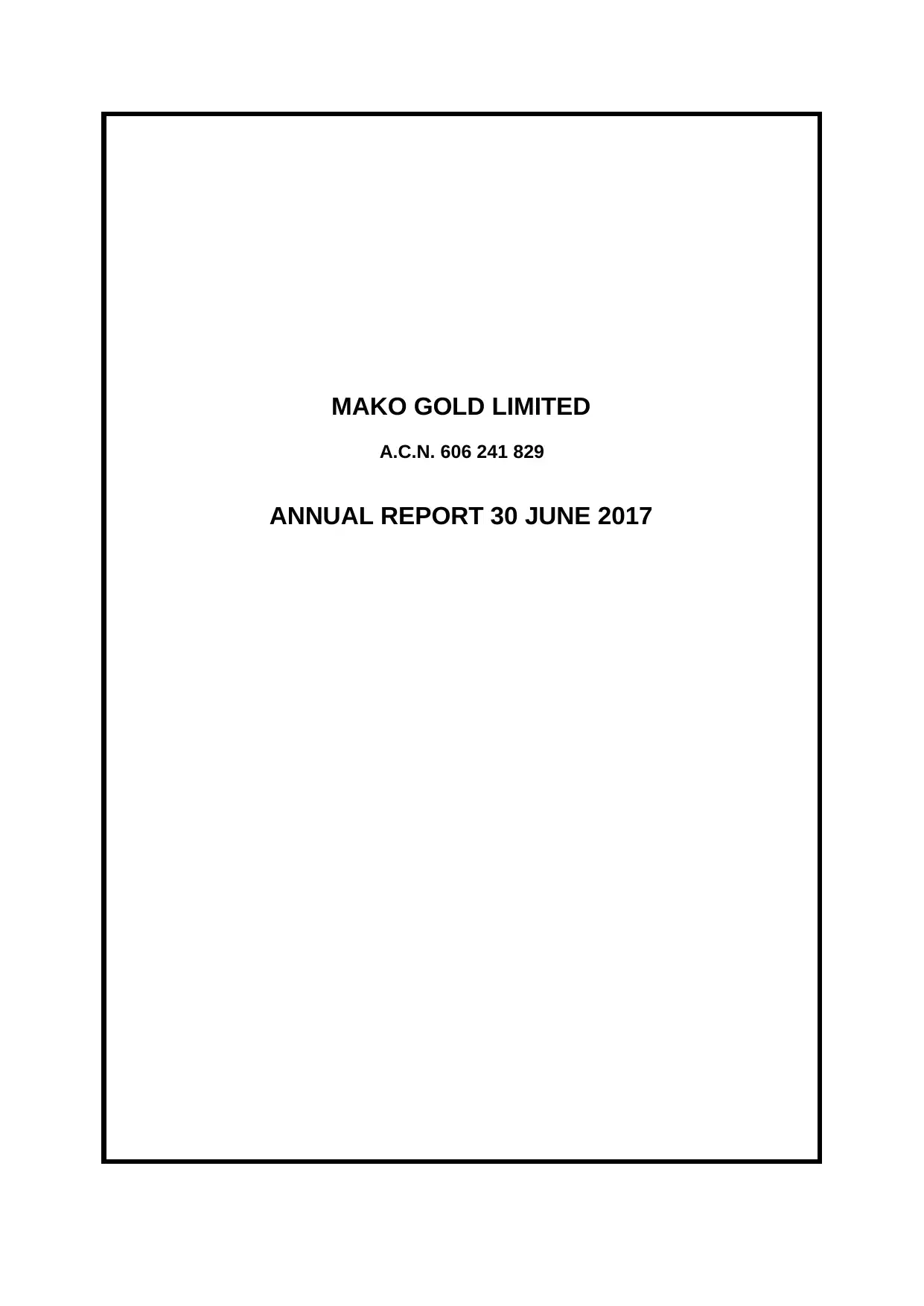
MAKO GOLD LIMITED
A.C.N. 606 241 829
ANNUAL REPORT 30 JUNE 2017
A.C.N. 606 241 829
ANNUAL REPORT 30 JUNE 2017
Secure Best Marks with AI Grader
Need help grading? Try our AI Grader for instant feedback on your assignments.
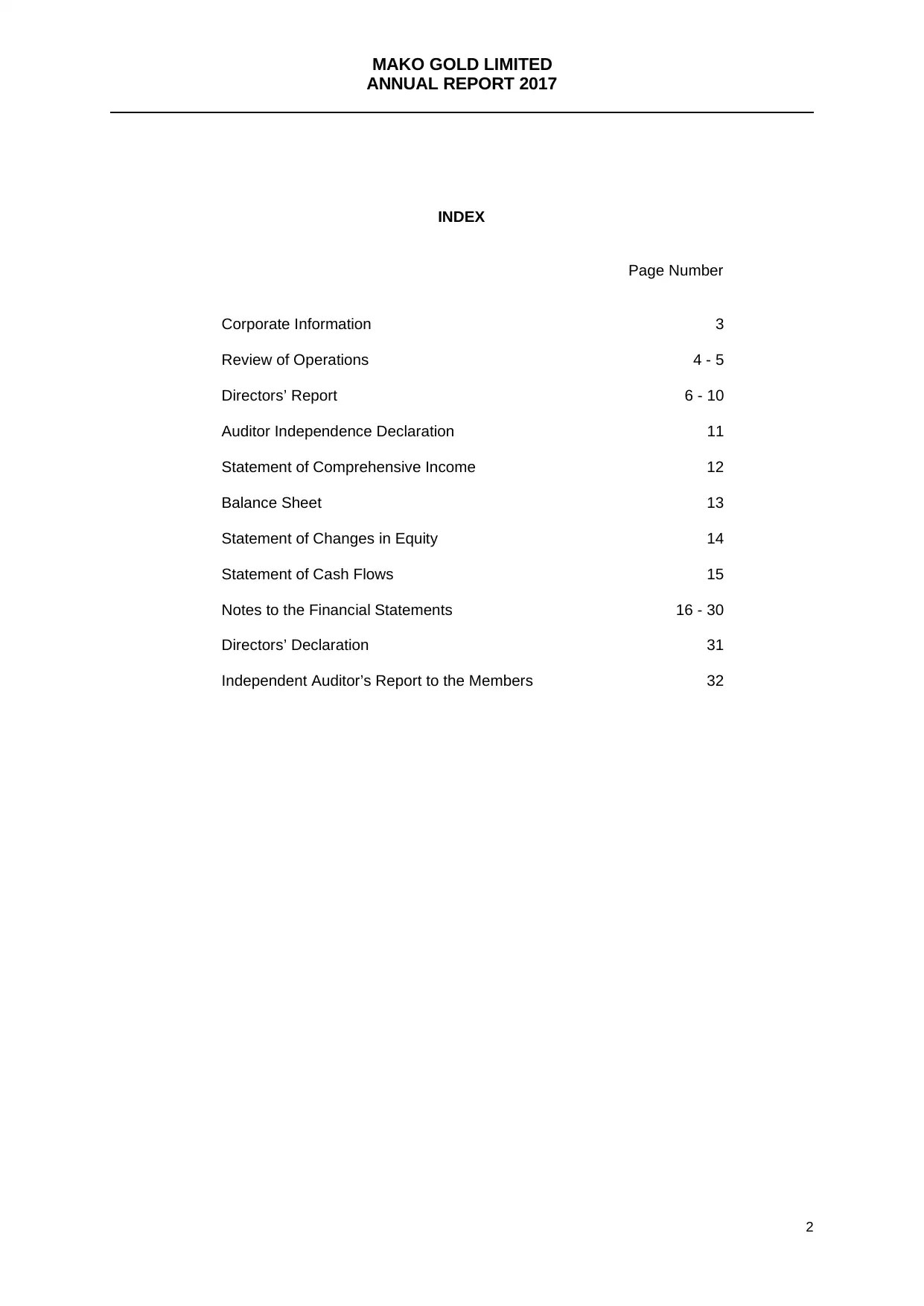
MAKO GOLD LIMITED
ANNUAL REPORT 2017
2
INDEX
Page Number
Corporate Information 3
Review of Operations 4 - 5
Directors’ Report 6 - 10
Auditor Independence Declaration 11
Statement of Comprehensive Income 12
Balance Sheet 13
Statement of Changes in Equity 14
Statement of Cash Flows 15
Notes to the Financial Statements 16 - 30
Directors’ Declaration 31
Independent Auditor’s Report to the Members 32
ANNUAL REPORT 2017
2
INDEX
Page Number
Corporate Information 3
Review of Operations 4 - 5
Directors’ Report 6 - 10
Auditor Independence Declaration 11
Statement of Comprehensive Income 12
Balance Sheet 13
Statement of Changes in Equity 14
Statement of Cash Flows 15
Notes to the Financial Statements 16 - 30
Directors’ Declaration 31
Independent Auditor’s Report to the Members 32
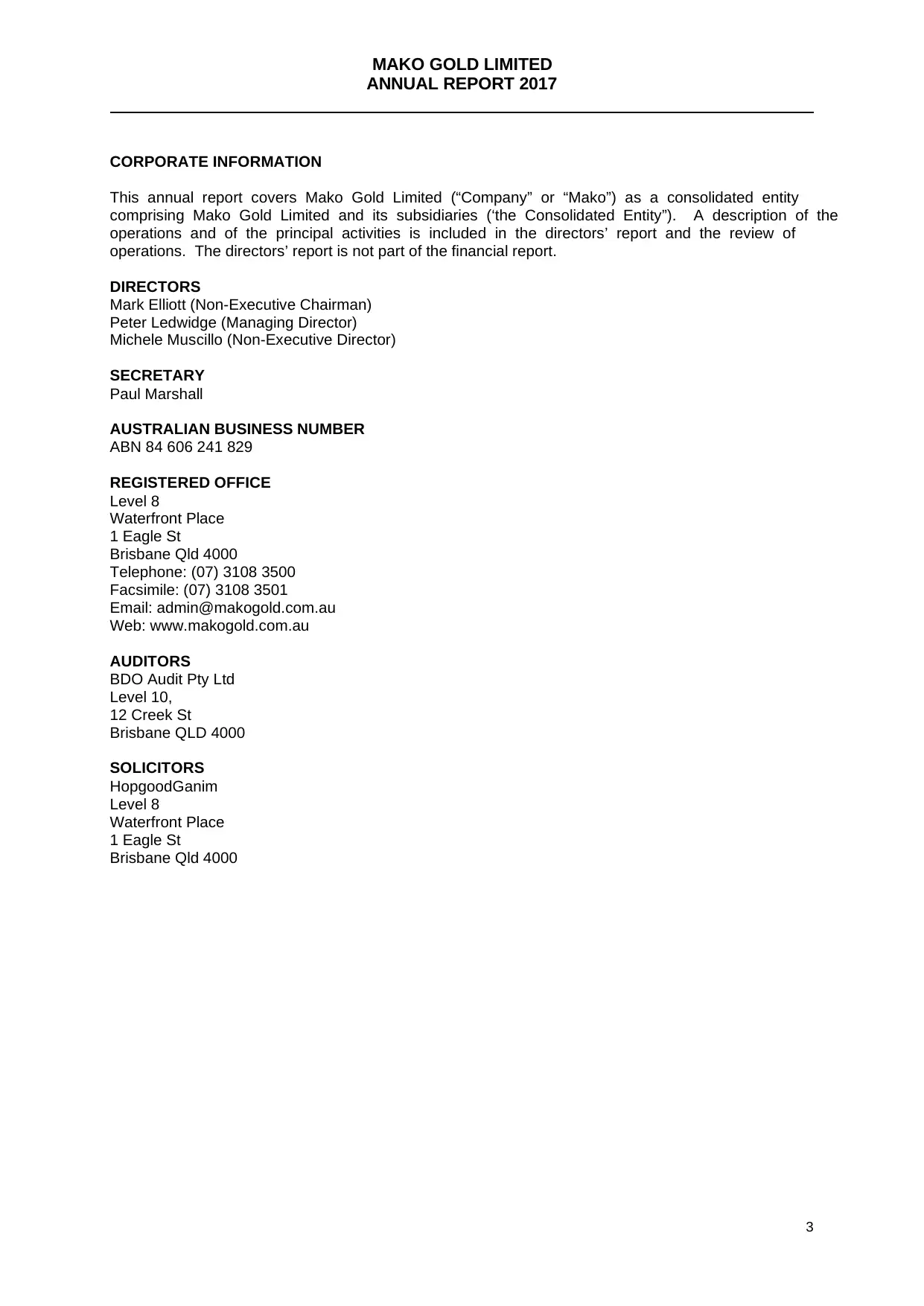
MAKO GOLD LIMITED
ANNUAL REPORT 2017
3
CORPORATE INFORMATION
This annual report covers Mako Gold Limited (“Company” or “Mako”) as a consolidated entity
comprising Mako Gold Limited and its subsidiaries (‘the Consolidated Entity”). A description of the
operations and of the principal activities is included in the directors’ report and the review of
operations. The directors’ report is not part of the financial report.
DIRECTORS
Mark Elliott (Non-Executive Chairman)
Peter Ledwidge (Managing Director)
Michele Muscillo (Non-Executive Director)
SECRETARY
Paul Marshall
AUSTRALIAN BUSINESS NUMBER
ABN 84 606 241 829
REGISTERED OFFICE
Level 8
Waterfront Place
1 Eagle St
Brisbane Qld 4000
Telephone: (07) 3108 3500
Facsimile: (07) 3108 3501
Email: admin@makogold.com.au
Web: www.makogold.com.au
AUDITORS
BDO Audit Pty Ltd
Level 10,
12 Creek St
Brisbane QLD 4000
SOLICITORS
HopgoodGanim
Level 8
Waterfront Place
1 Eagle St
Brisbane Qld 4000
ANNUAL REPORT 2017
3
CORPORATE INFORMATION
This annual report covers Mako Gold Limited (“Company” or “Mako”) as a consolidated entity
comprising Mako Gold Limited and its subsidiaries (‘the Consolidated Entity”). A description of the
operations and of the principal activities is included in the directors’ report and the review of
operations. The directors’ report is not part of the financial report.
DIRECTORS
Mark Elliott (Non-Executive Chairman)
Peter Ledwidge (Managing Director)
Michele Muscillo (Non-Executive Director)
SECRETARY
Paul Marshall
AUSTRALIAN BUSINESS NUMBER
ABN 84 606 241 829
REGISTERED OFFICE
Level 8
Waterfront Place
1 Eagle St
Brisbane Qld 4000
Telephone: (07) 3108 3500
Facsimile: (07) 3108 3501
Email: admin@makogold.com.au
Web: www.makogold.com.au
AUDITORS
BDO Audit Pty Ltd
Level 10,
12 Creek St
Brisbane QLD 4000
SOLICITORS
HopgoodGanim
Level 8
Waterfront Place
1 Eagle St
Brisbane Qld 4000

MAKO GOLD LIMITED
ANNUAL REPORT 2017
4
The directors present their review of operations for the year ended 30 June 2017.
Mako Gold is an exploration company focussed on the discovery of large high-grade gold deposits in
highly prospective and under-explored terrains in Burkina Faso and other favourable countries in West
Africa.
The Company was established in June 2015 and acquired its first project interests in July 2016. It
raised $700,000 in seed capital from investors in April 2017. The conversion of Mako Gold to a public
company was completed in June 2017 and Mako is seeking to list on the ASX in the near term.
Mako Gold’s first two gold projects are in highly mineralised terrain in Burkina Faso that have no
known drilling and which contain extensive artisanal workings indicating the presence of gold
mineralisation.
The Niou Project is located in the central part of the Burkina Faso. It is only 50km north of Burkina
Faso's capital Ouagadougou it is easily accessed by a good road system. The Tangora Project is
located in the Banfora greenstone belt in the southwest of Burkina Faso.
Burkina Faso Projects
Initial exploration work was undertaken on the Burkina Faso projects during May and June 2017 with
the following highlights:
• An airborne helicopter survey was completed at the Niou Gold Project with the entire 250km2
permit was flown for a total of 2750 line kilometres at a spacing of 100m and a survey height of
30m. Lines were flown north-south to intersect regional east-west structures and local NW-SE
and NE-SW structures that appear to be associated with gold mineralisation.
• Geology crew finished a rock chip sampling and preliminary mapping of the extensive artisanal
mining sites on the Niou Gold Project and on the Tangora Gold Project.
• Visible gold was observed in samples excavated from an artisanal mining shaft on Niou Project.
• An exploration office was established in Ouagadougou.
ANNUAL REPORT 2017
4
The directors present their review of operations for the year ended 30 June 2017.
Mako Gold is an exploration company focussed on the discovery of large high-grade gold deposits in
highly prospective and under-explored terrains in Burkina Faso and other favourable countries in West
Africa.
The Company was established in June 2015 and acquired its first project interests in July 2016. It
raised $700,000 in seed capital from investors in April 2017. The conversion of Mako Gold to a public
company was completed in June 2017 and Mako is seeking to list on the ASX in the near term.
Mako Gold’s first two gold projects are in highly mineralised terrain in Burkina Faso that have no
known drilling and which contain extensive artisanal workings indicating the presence of gold
mineralisation.
The Niou Project is located in the central part of the Burkina Faso. It is only 50km north of Burkina
Faso's capital Ouagadougou it is easily accessed by a good road system. The Tangora Project is
located in the Banfora greenstone belt in the southwest of Burkina Faso.
Burkina Faso Projects
Initial exploration work was undertaken on the Burkina Faso projects during May and June 2017 with
the following highlights:
• An airborne helicopter survey was completed at the Niou Gold Project with the entire 250km2
permit was flown for a total of 2750 line kilometres at a spacing of 100m and a survey height of
30m. Lines were flown north-south to intersect regional east-west structures and local NW-SE
and NE-SW structures that appear to be associated with gold mineralisation.
• Geology crew finished a rock chip sampling and preliminary mapping of the extensive artisanal
mining sites on the Niou Gold Project and on the Tangora Gold Project.
• Visible gold was observed in samples excavated from an artisanal mining shaft on Niou Project.
• An exploration office was established in Ouagadougou.
Secure Best Marks with AI Grader
Need help grading? Try our AI Grader for instant feedback on your assignments.
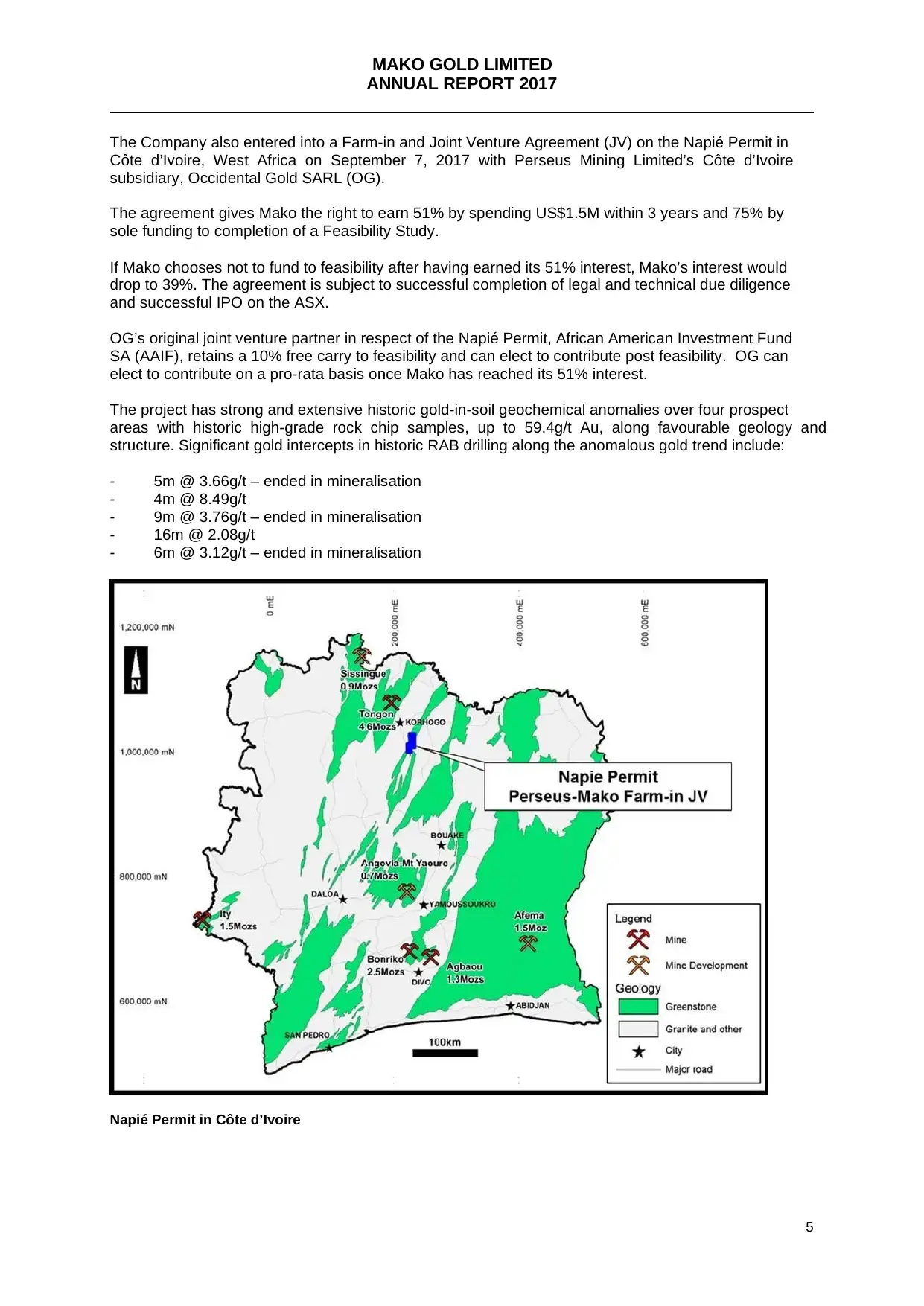
MAKO GOLD LIMITED
ANNUAL REPORT 2017
5
The Company also entered into a Farm-in and Joint Venture Agreement (JV) on the Napié Permit in
Côte d’Ivoire, West Africa on September 7, 2017 with Perseus Mining Limited’s Côte d’Ivoire
subsidiary, Occidental Gold SARL (OG).
The agreement gives Mako the right to earn 51% by spending US$1.5M within 3 years and 75% by
sole funding to completion of a Feasibility Study.
If Mako chooses not to fund to feasibility after having earned its 51% interest, Mako’s interest would
drop to 39%. The agreement is subject to successful completion of legal and technical due diligence
and successful IPO on the ASX.
OG’s original joint venture partner in respect of the Napié Permit, African American Investment Fund
SA (AAIF), retains a 10% free carry to feasibility and can elect to contribute post feasibility. OG can
elect to contribute on a pro-rata basis once Mako has reached its 51% interest.
The project has strong and extensive historic gold-in-soil geochemical anomalies over four prospect
areas with historic high-grade rock chip samples, up to 59.4g/t Au, along favourable geology and
structure. Significant gold intercepts in historic RAB drilling along the anomalous gold trend include:
- 5m @ 3.66g/t – ended in mineralisation
- 4m @ 8.49g/t
- 9m @ 3.76g/t – ended in mineralisation
- 16m @ 2.08g/t
- 6m @ 3.12g/t – ended in mineralisation
Napié Permit in Côte d’Ivoire
ANNUAL REPORT 2017
5
The Company also entered into a Farm-in and Joint Venture Agreement (JV) on the Napié Permit in
Côte d’Ivoire, West Africa on September 7, 2017 with Perseus Mining Limited’s Côte d’Ivoire
subsidiary, Occidental Gold SARL (OG).
The agreement gives Mako the right to earn 51% by spending US$1.5M within 3 years and 75% by
sole funding to completion of a Feasibility Study.
If Mako chooses not to fund to feasibility after having earned its 51% interest, Mako’s interest would
drop to 39%. The agreement is subject to successful completion of legal and technical due diligence
and successful IPO on the ASX.
OG’s original joint venture partner in respect of the Napié Permit, African American Investment Fund
SA (AAIF), retains a 10% free carry to feasibility and can elect to contribute post feasibility. OG can
elect to contribute on a pro-rata basis once Mako has reached its 51% interest.
The project has strong and extensive historic gold-in-soil geochemical anomalies over four prospect
areas with historic high-grade rock chip samples, up to 59.4g/t Au, along favourable geology and
structure. Significant gold intercepts in historic RAB drilling along the anomalous gold trend include:
- 5m @ 3.66g/t – ended in mineralisation
- 4m @ 8.49g/t
- 9m @ 3.76g/t – ended in mineralisation
- 16m @ 2.08g/t
- 6m @ 3.12g/t – ended in mineralisation
Napié Permit in Côte d’Ivoire
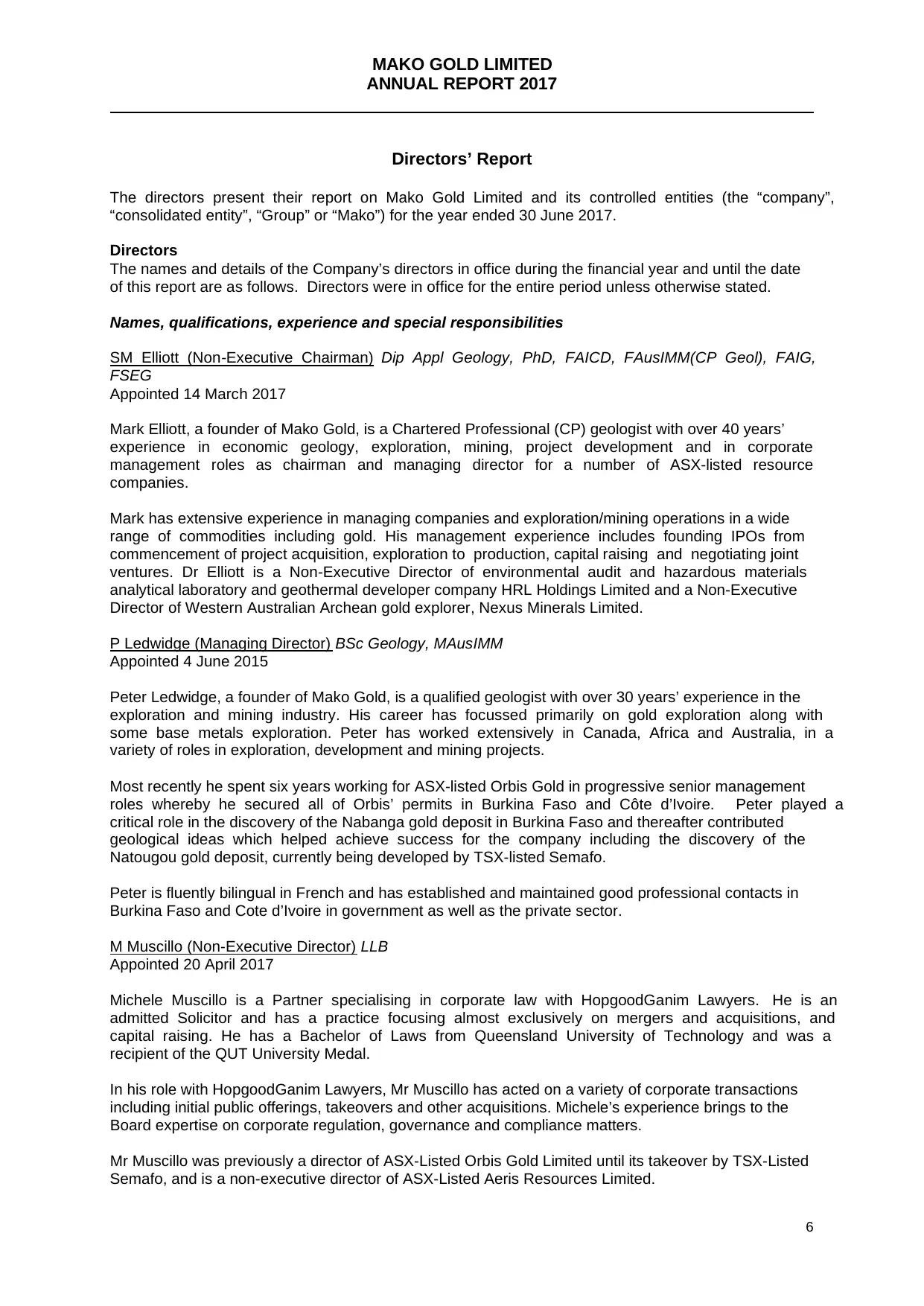
MAKO GOLD LIMITED
ANNUAL REPORT 2017
6
Directors’ Report
The directors present their report on Mako Gold Limited and its controlled entities (the “company”,
“consolidated entity”, “Group” or “Mako”) for the year ended 30 June 2017.
Directors
The names and details of the Company’s directors in office during the financial year and until the date
of this report are as follows. Directors were in office for the entire period unless otherwise stated.
Names, qualifications, experience and special responsibilities
SM Elliott (Non-Executive Chairman) Dip Appl Geology, PhD, FAICD, FAusIMM(CP Geol), FAIG,
FSEG
Appointed 14 March 2017
Mark Elliott, a founder of Mako Gold, is a Chartered Professional (CP) geologist with over 40 years’
experience in economic geology, exploration, mining, project development and in corporate
management roles as chairman and managing director for a number of ASX-listed resource
companies.
Mark has extensive experience in managing companies and exploration/mining operations in a wide
range of commodities including gold. His management experience includes founding IPOs from
commencement of project acquisition, exploration to production, capital raising and negotiating joint
ventures. Dr Elliott is a Non-Executive Director of environmental audit and hazardous materials
analytical laboratory and geothermal developer company HRL Holdings Limited and a Non-Executive
Director of Western Australian Archean gold explorer, Nexus Minerals Limited.
P Ledwidge (Managing Director) BSc Geology, MAusIMM
Appointed 4 June 2015
Peter Ledwidge, a founder of Mako Gold, is a qualified geologist with over 30 years’ experience in the
exploration and mining industry. His career has focussed primarily on gold exploration along with
some base metals exploration. Peter has worked extensively in Canada, Africa and Australia, in a
variety of roles in exploration, development and mining projects.
Most recently he spent six years working for ASX-listed Orbis Gold in progressive senior management
roles whereby he secured all of Orbis’ permits in Burkina Faso and Côte d’Ivoire. Peter played a
critical role in the discovery of the Nabanga gold deposit in Burkina Faso and thereafter contributed
geological ideas which helped achieve success for the company including the discovery of the
Natougou gold deposit, currently being developed by TSX-listed Semafo.
Peter is fluently bilingual in French and has established and maintained good professional contacts in
Burkina Faso and Cote d’Ivoire in government as well as the private sector.
M Muscillo (Non-Executive Director) LLB
Appointed 20 April 2017
Michele Muscillo is a Partner specialising in corporate law with HopgoodGanim Lawyers. He is an
admitted Solicitor and has a practice focusing almost exclusively on mergers and acquisitions, and
capital raising. He has a Bachelor of Laws from Queensland University of Technology and was a
recipient of the QUT University Medal.
In his role with HopgoodGanim Lawyers, Mr Muscillo has acted on a variety of corporate transactions
including initial public offerings, takeovers and other acquisitions. Michele’s experience brings to the
Board expertise on corporate regulation, governance and compliance matters.
Mr Muscillo was previously a director of ASX-Listed Orbis Gold Limited until its takeover by TSX-Listed
Semafo, and is a non-executive director of ASX-Listed Aeris Resources Limited.
ANNUAL REPORT 2017
6
Directors’ Report
The directors present their report on Mako Gold Limited and its controlled entities (the “company”,
“consolidated entity”, “Group” or “Mako”) for the year ended 30 June 2017.
Directors
The names and details of the Company’s directors in office during the financial year and until the date
of this report are as follows. Directors were in office for the entire period unless otherwise stated.
Names, qualifications, experience and special responsibilities
SM Elliott (Non-Executive Chairman) Dip Appl Geology, PhD, FAICD, FAusIMM(CP Geol), FAIG,
FSEG
Appointed 14 March 2017
Mark Elliott, a founder of Mako Gold, is a Chartered Professional (CP) geologist with over 40 years’
experience in economic geology, exploration, mining, project development and in corporate
management roles as chairman and managing director for a number of ASX-listed resource
companies.
Mark has extensive experience in managing companies and exploration/mining operations in a wide
range of commodities including gold. His management experience includes founding IPOs from
commencement of project acquisition, exploration to production, capital raising and negotiating joint
ventures. Dr Elliott is a Non-Executive Director of environmental audit and hazardous materials
analytical laboratory and geothermal developer company HRL Holdings Limited and a Non-Executive
Director of Western Australian Archean gold explorer, Nexus Minerals Limited.
P Ledwidge (Managing Director) BSc Geology, MAusIMM
Appointed 4 June 2015
Peter Ledwidge, a founder of Mako Gold, is a qualified geologist with over 30 years’ experience in the
exploration and mining industry. His career has focussed primarily on gold exploration along with
some base metals exploration. Peter has worked extensively in Canada, Africa and Australia, in a
variety of roles in exploration, development and mining projects.
Most recently he spent six years working for ASX-listed Orbis Gold in progressive senior management
roles whereby he secured all of Orbis’ permits in Burkina Faso and Côte d’Ivoire. Peter played a
critical role in the discovery of the Nabanga gold deposit in Burkina Faso and thereafter contributed
geological ideas which helped achieve success for the company including the discovery of the
Natougou gold deposit, currently being developed by TSX-listed Semafo.
Peter is fluently bilingual in French and has established and maintained good professional contacts in
Burkina Faso and Cote d’Ivoire in government as well as the private sector.
M Muscillo (Non-Executive Director) LLB
Appointed 20 April 2017
Michele Muscillo is a Partner specialising in corporate law with HopgoodGanim Lawyers. He is an
admitted Solicitor and has a practice focusing almost exclusively on mergers and acquisitions, and
capital raising. He has a Bachelor of Laws from Queensland University of Technology and was a
recipient of the QUT University Medal.
In his role with HopgoodGanim Lawyers, Mr Muscillo has acted on a variety of corporate transactions
including initial public offerings, takeovers and other acquisitions. Michele’s experience brings to the
Board expertise on corporate regulation, governance and compliance matters.
Mr Muscillo was previously a director of ASX-Listed Orbis Gold Limited until its takeover by TSX-Listed
Semafo, and is a non-executive director of ASX-Listed Aeris Resources Limited.
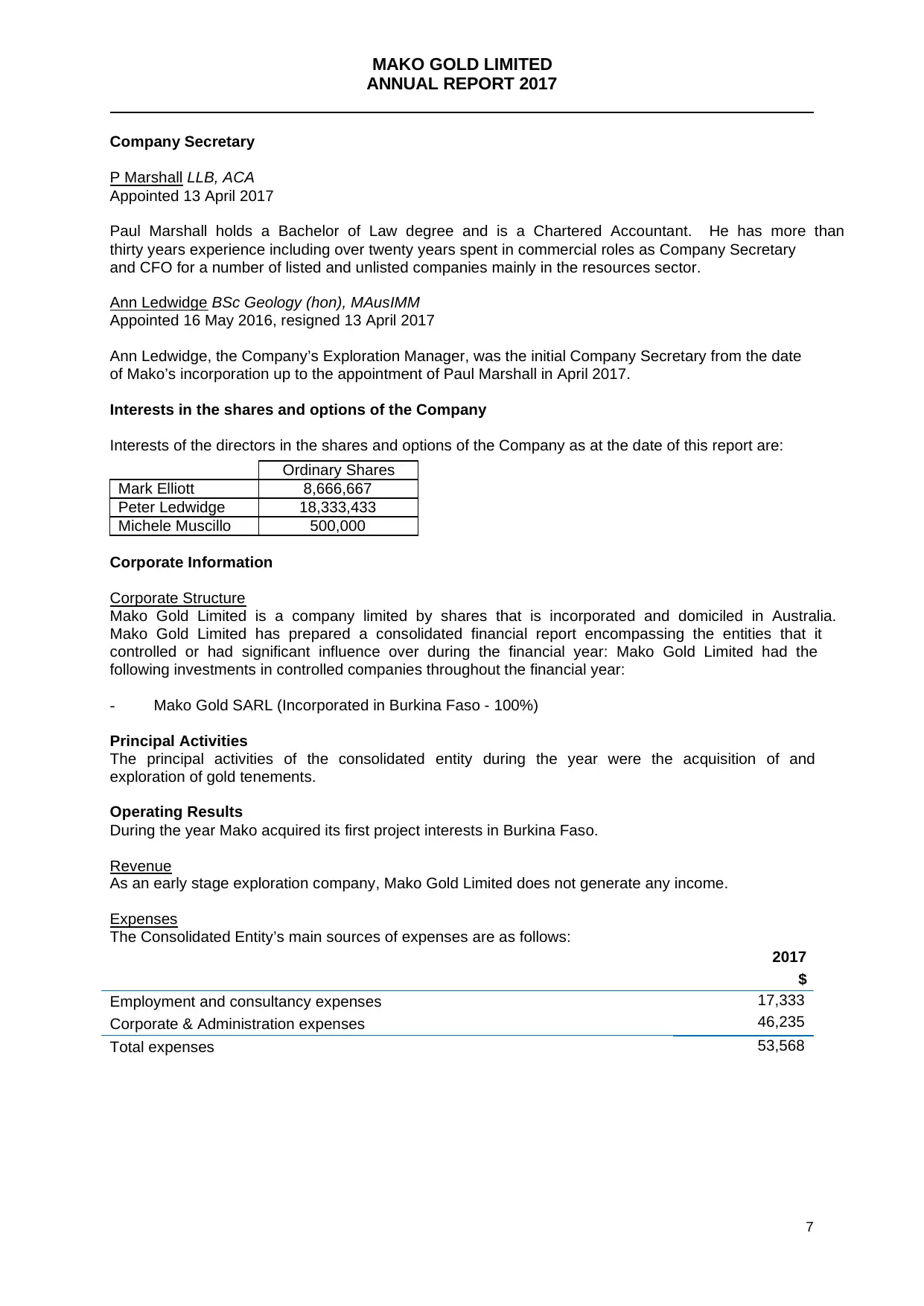
MAKO GOLD LIMITED
ANNUAL REPORT 2017
7
Company Secretary
P Marshall LLB, ACA
Appointed 13 April 2017
Paul Marshall holds a Bachelor of Law degree and is a Chartered Accountant. He has more than
thirty years experience including over twenty years spent in commercial roles as Company Secretary
and CFO for a number of listed and unlisted companies mainly in the resources sector.
Ann Ledwidge BSc Geology (hon), MAusIMM
Appointed 16 May 2016, resigned 13 April 2017
Ann Ledwidge, the Company’s Exploration Manager, was the initial Company Secretary from the date
of Mako’s incorporation up to the appointment of Paul Marshall in April 2017.
Interests in the shares and options of the Company
Interests of the directors in the shares and options of the Company as at the date of this report are:
Ordinary Shares
Mark Elliott 8,666,667
Peter Ledwidge 18,333,433
Michele Muscillo 500,000
Corporate Information
Corporate Structure
Mako Gold Limited is a company limited by shares that is incorporated and domiciled in Australia.
Mako Gold Limited has prepared a consolidated financial report encompassing the entities that it
controlled or had significant influence over during the financial year: Mako Gold Limited had the
following investments in controlled companies throughout the financial year:
- Mako Gold SARL (Incorporated in Burkina Faso - 100%)
Principal Activities
The principal activities of the consolidated entity during the year were the acquisition of and
exploration of gold tenements.
Operating Results
During the year Mako acquired its first project interests in Burkina Faso.
Revenue
As an early stage exploration company, Mako Gold Limited does not generate any income.
Expenses
The Consolidated Entity’s main sources of expenses are as follows:
2017
$
Employment and consultancy expenses 17,333
Corporate & Administration expenses 46,235
Total expenses 53,568
ANNUAL REPORT 2017
7
Company Secretary
P Marshall LLB, ACA
Appointed 13 April 2017
Paul Marshall holds a Bachelor of Law degree and is a Chartered Accountant. He has more than
thirty years experience including over twenty years spent in commercial roles as Company Secretary
and CFO for a number of listed and unlisted companies mainly in the resources sector.
Ann Ledwidge BSc Geology (hon), MAusIMM
Appointed 16 May 2016, resigned 13 April 2017
Ann Ledwidge, the Company’s Exploration Manager, was the initial Company Secretary from the date
of Mako’s incorporation up to the appointment of Paul Marshall in April 2017.
Interests in the shares and options of the Company
Interests of the directors in the shares and options of the Company as at the date of this report are:
Ordinary Shares
Mark Elliott 8,666,667
Peter Ledwidge 18,333,433
Michele Muscillo 500,000
Corporate Information
Corporate Structure
Mako Gold Limited is a company limited by shares that is incorporated and domiciled in Australia.
Mako Gold Limited has prepared a consolidated financial report encompassing the entities that it
controlled or had significant influence over during the financial year: Mako Gold Limited had the
following investments in controlled companies throughout the financial year:
- Mako Gold SARL (Incorporated in Burkina Faso - 100%)
Principal Activities
The principal activities of the consolidated entity during the year were the acquisition of and
exploration of gold tenements.
Operating Results
During the year Mako acquired its first project interests in Burkina Faso.
Revenue
As an early stage exploration company, Mako Gold Limited does not generate any income.
Expenses
The Consolidated Entity’s main sources of expenses are as follows:
2017
$
Employment and consultancy expenses 17,333
Corporate & Administration expenses 46,235
Total expenses 53,568
Paraphrase This Document
Need a fresh take? Get an instant paraphrase of this document with our AI Paraphraser
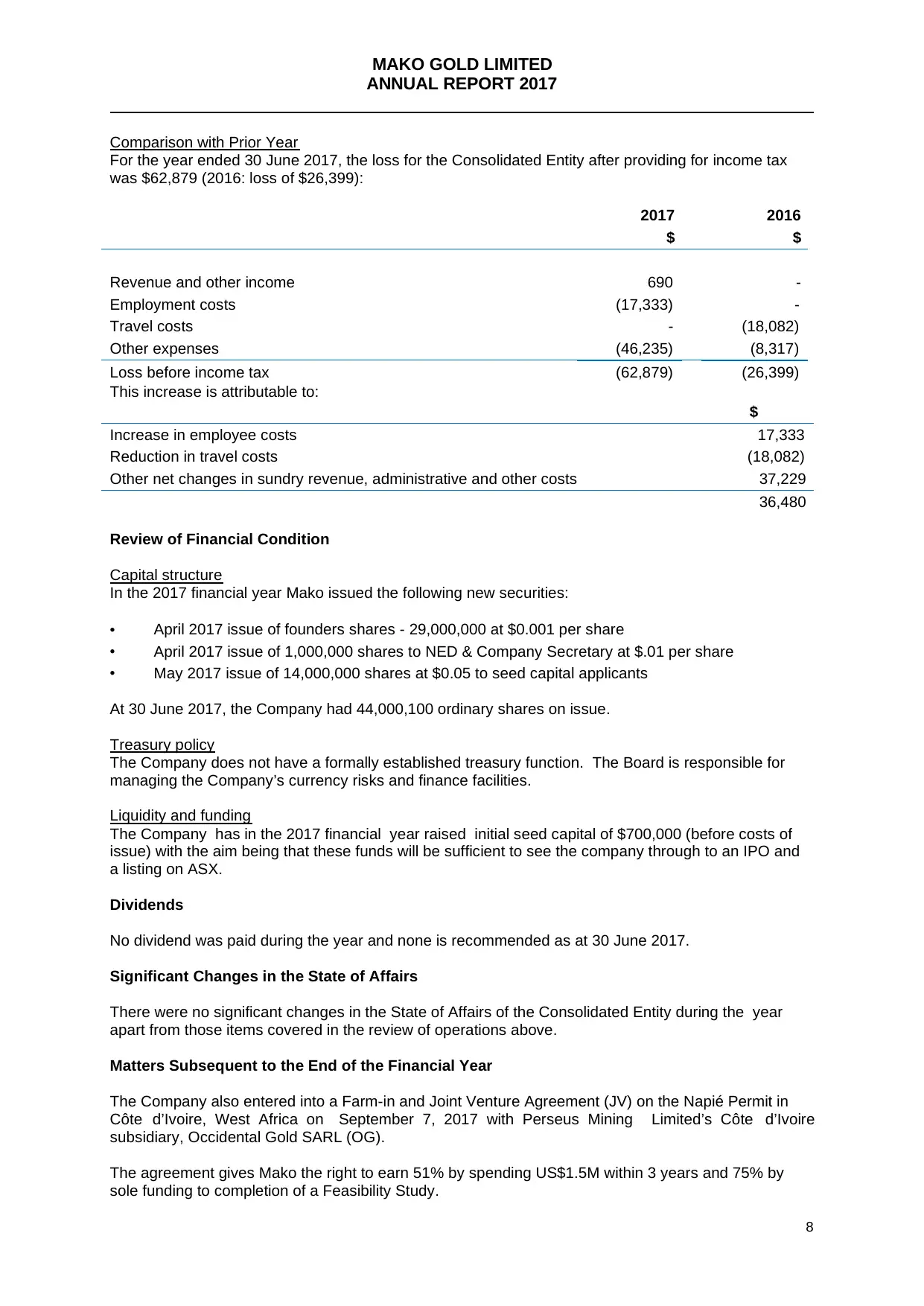
MAKO GOLD LIMITED
ANNUAL REPORT 2017
8
Comparison with Prior Year
For the year ended 30 June 2017, the loss for the Consolidated Entity after providing for income tax
was $62,879 (2016: loss of $26,399):
2017 2016
$ $
Revenue and other income 690 -
Employment costs (17,333) -
Travel costs - (18,082)
Other expenses (46,235) (8,317)
Loss before income tax (62,879) (26,399)
This increase is attributable to:
$
Increase in employee costs 17,333
Reduction in travel costs (18,082)
Other net changes in sundry revenue, administrative and other costs 37,229
36,480
Review of Financial Condition
Capital structure
In the 2017 financial year Mako issued the following new securities:
• April 2017 issue of founders shares - 29,000,000 at $0.001 per share
• April 2017 issue of 1,000,000 shares to NED & Company Secretary at $.01 per share
• May 2017 issue of 14,000,000 shares at $0.05 to seed capital applicants
At 30 June 2017, the Company had 44,000,100 ordinary shares on issue.
Treasury policy
The Company does not have a formally established treasury function. The Board is responsible for
managing the Company’s currency risks and finance facilities.
Liquidity and funding
The Company has in the 2017 financial year raised initial seed capital of $700,000 (before costs of
issue) with the aim being that these funds will be sufficient to see the company through to an IPO and
a listing on ASX.
Dividends
No dividend was paid during the year and none is recommended as at 30 June 2017.
Significant Changes in the State of Affairs
There were no significant changes in the State of Affairs of the Consolidated Entity during the year
apart from those items covered in the review of operations above.
Matters Subsequent to the End of the Financial Year
The Company also entered into a Farm-in and Joint Venture Agreement (JV) on the Napié Permit in
Côte d’Ivoire, West Africa on September 7, 2017 with Perseus Mining Limited’s Côte d’Ivoire
subsidiary, Occidental Gold SARL (OG).
The agreement gives Mako the right to earn 51% by spending US$1.5M within 3 years and 75% by
sole funding to completion of a Feasibility Study.
ANNUAL REPORT 2017
8
Comparison with Prior Year
For the year ended 30 June 2017, the loss for the Consolidated Entity after providing for income tax
was $62,879 (2016: loss of $26,399):
2017 2016
$ $
Revenue and other income 690 -
Employment costs (17,333) -
Travel costs - (18,082)
Other expenses (46,235) (8,317)
Loss before income tax (62,879) (26,399)
This increase is attributable to:
$
Increase in employee costs 17,333
Reduction in travel costs (18,082)
Other net changes in sundry revenue, administrative and other costs 37,229
36,480
Review of Financial Condition
Capital structure
In the 2017 financial year Mako issued the following new securities:
• April 2017 issue of founders shares - 29,000,000 at $0.001 per share
• April 2017 issue of 1,000,000 shares to NED & Company Secretary at $.01 per share
• May 2017 issue of 14,000,000 shares at $0.05 to seed capital applicants
At 30 June 2017, the Company had 44,000,100 ordinary shares on issue.
Treasury policy
The Company does not have a formally established treasury function. The Board is responsible for
managing the Company’s currency risks and finance facilities.
Liquidity and funding
The Company has in the 2017 financial year raised initial seed capital of $700,000 (before costs of
issue) with the aim being that these funds will be sufficient to see the company through to an IPO and
a listing on ASX.
Dividends
No dividend was paid during the year and none is recommended as at 30 June 2017.
Significant Changes in the State of Affairs
There were no significant changes in the State of Affairs of the Consolidated Entity during the year
apart from those items covered in the review of operations above.
Matters Subsequent to the End of the Financial Year
The Company also entered into a Farm-in and Joint Venture Agreement (JV) on the Napié Permit in
Côte d’Ivoire, West Africa on September 7, 2017 with Perseus Mining Limited’s Côte d’Ivoire
subsidiary, Occidental Gold SARL (OG).
The agreement gives Mako the right to earn 51% by spending US$1.5M within 3 years and 75% by
sole funding to completion of a Feasibility Study.
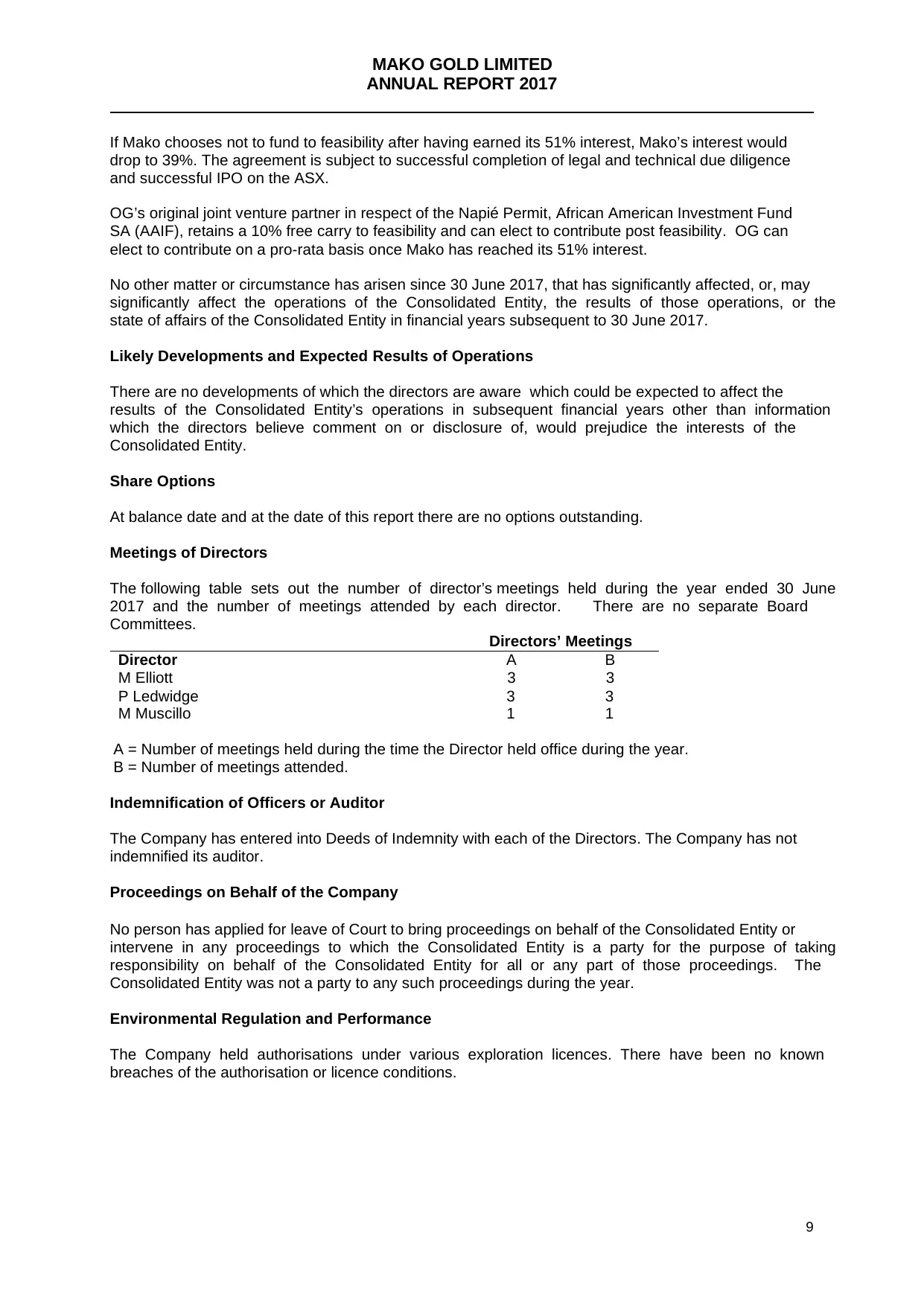
MAKO GOLD LIMITED
ANNUAL REPORT 2017
9
If Mako chooses not to fund to feasibility after having earned its 51% interest, Mako’s interest would
drop to 39%. The agreement is subject to successful completion of legal and technical due diligence
and successful IPO on the ASX.
OG’s original joint venture partner in respect of the Napié Permit, African American Investment Fund
SA (AAIF), retains a 10% free carry to feasibility and can elect to contribute post feasibility. OG can
elect to contribute on a pro-rata basis once Mako has reached its 51% interest.
No other matter or circumstance has arisen since 30 June 2017, that has significantly affected, or, may
significantly affect the operations of the Consolidated Entity, the results of those operations, or the
state of affairs of the Consolidated Entity in financial years subsequent to 30 June 2017.
Likely Developments and Expected Results of Operations
There are no developments of which the directors are aware which could be expected to affect the
results of the Consolidated Entity’s operations in subsequent financial years other than information
which the directors believe comment on or disclosure of, would prejudice the interests of the
Consolidated Entity.
Share Options
At balance date and at the date of this report there are no options outstanding.
Meetings of Directors
The following table sets out the number of director’s meetings held during the year ended 30 June
2017 and the number of meetings attended by each director. There are no separate Board
Committees.
Directors’ Meetings
Director A B
M Elliott 3 3
P Ledwidge 3 3
M Muscillo 1 1
A = Number of meetings held during the time the Director held office during the year.
B = Number of meetings attended.
Indemnification of Officers or Auditor
The Company has entered into Deeds of Indemnity with each of the Directors. The Company has not
indemnified its auditor.
Proceedings on Behalf of the Company
No person has applied for leave of Court to bring proceedings on behalf of the Consolidated Entity or
intervene in any proceedings to which the Consolidated Entity is a party for the purpose of taking
responsibility on behalf of the Consolidated Entity for all or any part of those proceedings. The
Consolidated Entity was not a party to any such proceedings during the year.
Environmental Regulation and Performance
The Company held authorisations under various exploration licences. There have been no known
breaches of the authorisation or licence conditions.
ANNUAL REPORT 2017
9
If Mako chooses not to fund to feasibility after having earned its 51% interest, Mako’s interest would
drop to 39%. The agreement is subject to successful completion of legal and technical due diligence
and successful IPO on the ASX.
OG’s original joint venture partner in respect of the Napié Permit, African American Investment Fund
SA (AAIF), retains a 10% free carry to feasibility and can elect to contribute post feasibility. OG can
elect to contribute on a pro-rata basis once Mako has reached its 51% interest.
No other matter or circumstance has arisen since 30 June 2017, that has significantly affected, or, may
significantly affect the operations of the Consolidated Entity, the results of those operations, or the
state of affairs of the Consolidated Entity in financial years subsequent to 30 June 2017.
Likely Developments and Expected Results of Operations
There are no developments of which the directors are aware which could be expected to affect the
results of the Consolidated Entity’s operations in subsequent financial years other than information
which the directors believe comment on or disclosure of, would prejudice the interests of the
Consolidated Entity.
Share Options
At balance date and at the date of this report there are no options outstanding.
Meetings of Directors
The following table sets out the number of director’s meetings held during the year ended 30 June
2017 and the number of meetings attended by each director. There are no separate Board
Committees.
Directors’ Meetings
Director A B
M Elliott 3 3
P Ledwidge 3 3
M Muscillo 1 1
A = Number of meetings held during the time the Director held office during the year.
B = Number of meetings attended.
Indemnification of Officers or Auditor
The Company has entered into Deeds of Indemnity with each of the Directors. The Company has not
indemnified its auditor.
Proceedings on Behalf of the Company
No person has applied for leave of Court to bring proceedings on behalf of the Consolidated Entity or
intervene in any proceedings to which the Consolidated Entity is a party for the purpose of taking
responsibility on behalf of the Consolidated Entity for all or any part of those proceedings. The
Consolidated Entity was not a party to any such proceedings during the year.
Environmental Regulation and Performance
The Company held authorisations under various exploration licences. There have been no known
breaches of the authorisation or licence conditions.
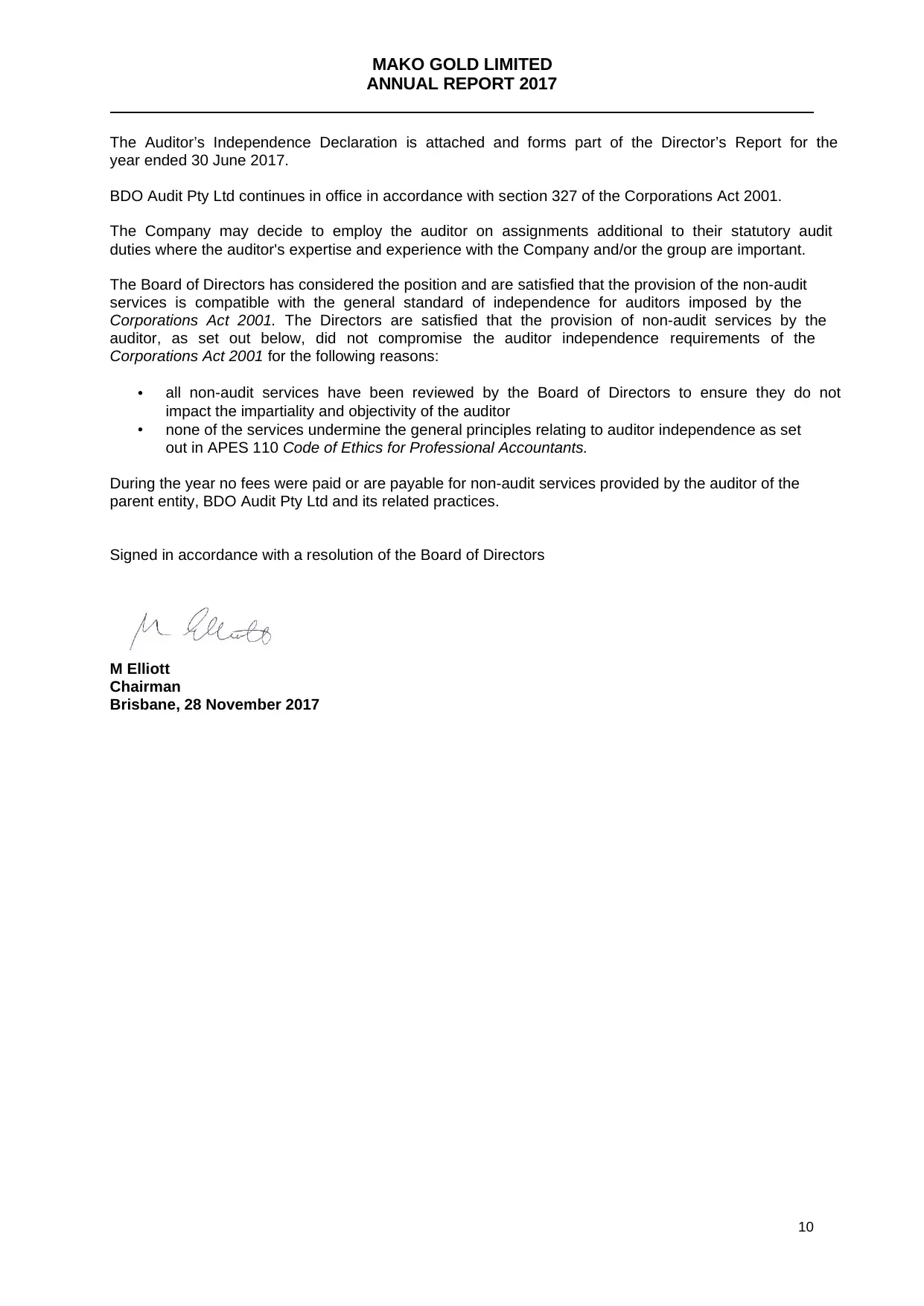
MAKO GOLD LIMITED
ANNUAL REPORT 2017
10
The Auditor’s Independence Declaration is attached and forms part of the Director’s Report for the
year ended 30 June 2017.
BDO Audit Pty Ltd continues in office in accordance with section 327 of the Corporations Act 2001.
The Company may decide to employ the auditor on assignments additional to their statutory audit
duties where the auditor's expertise and experience with the Company and/or the group are important.
The Board of Directors has considered the position and are satisfied that the provision of the non-audit
services is compatible with the general standard of independence for auditors imposed by the
Corporations Act 2001. The Directors are satisfied that the provision of non-audit services by the
auditor, as set out below, did not compromise the auditor independence requirements of the
Corporations Act 2001 for the following reasons:
• all non-audit services have been reviewed by the Board of Directors to ensure they do not
impact the impartiality and objectivity of the auditor
• none of the services undermine the general principles relating to auditor independence as set
out in APES 110 Code of Ethics for Professional Accountants.
During the year no fees were paid or are payable for non-audit services provided by the auditor of the
parent entity, BDO Audit Pty Ltd and its related practices.
Signed in accordance with a resolution of the Board of Directors
M Elliott
Chairman
Brisbane, 28 November 2017
ANNUAL REPORT 2017
10
The Auditor’s Independence Declaration is attached and forms part of the Director’s Report for the
year ended 30 June 2017.
BDO Audit Pty Ltd continues in office in accordance with section 327 of the Corporations Act 2001.
The Company may decide to employ the auditor on assignments additional to their statutory audit
duties where the auditor's expertise and experience with the Company and/or the group are important.
The Board of Directors has considered the position and are satisfied that the provision of the non-audit
services is compatible with the general standard of independence for auditors imposed by the
Corporations Act 2001. The Directors are satisfied that the provision of non-audit services by the
auditor, as set out below, did not compromise the auditor independence requirements of the
Corporations Act 2001 for the following reasons:
• all non-audit services have been reviewed by the Board of Directors to ensure they do not
impact the impartiality and objectivity of the auditor
• none of the services undermine the general principles relating to auditor independence as set
out in APES 110 Code of Ethics for Professional Accountants.
During the year no fees were paid or are payable for non-audit services provided by the auditor of the
parent entity, BDO Audit Pty Ltd and its related practices.
Signed in accordance with a resolution of the Board of Directors
M Elliott
Chairman
Brisbane, 28 November 2017
Secure Best Marks with AI Grader
Need help grading? Try our AI Grader for instant feedback on your assignments.
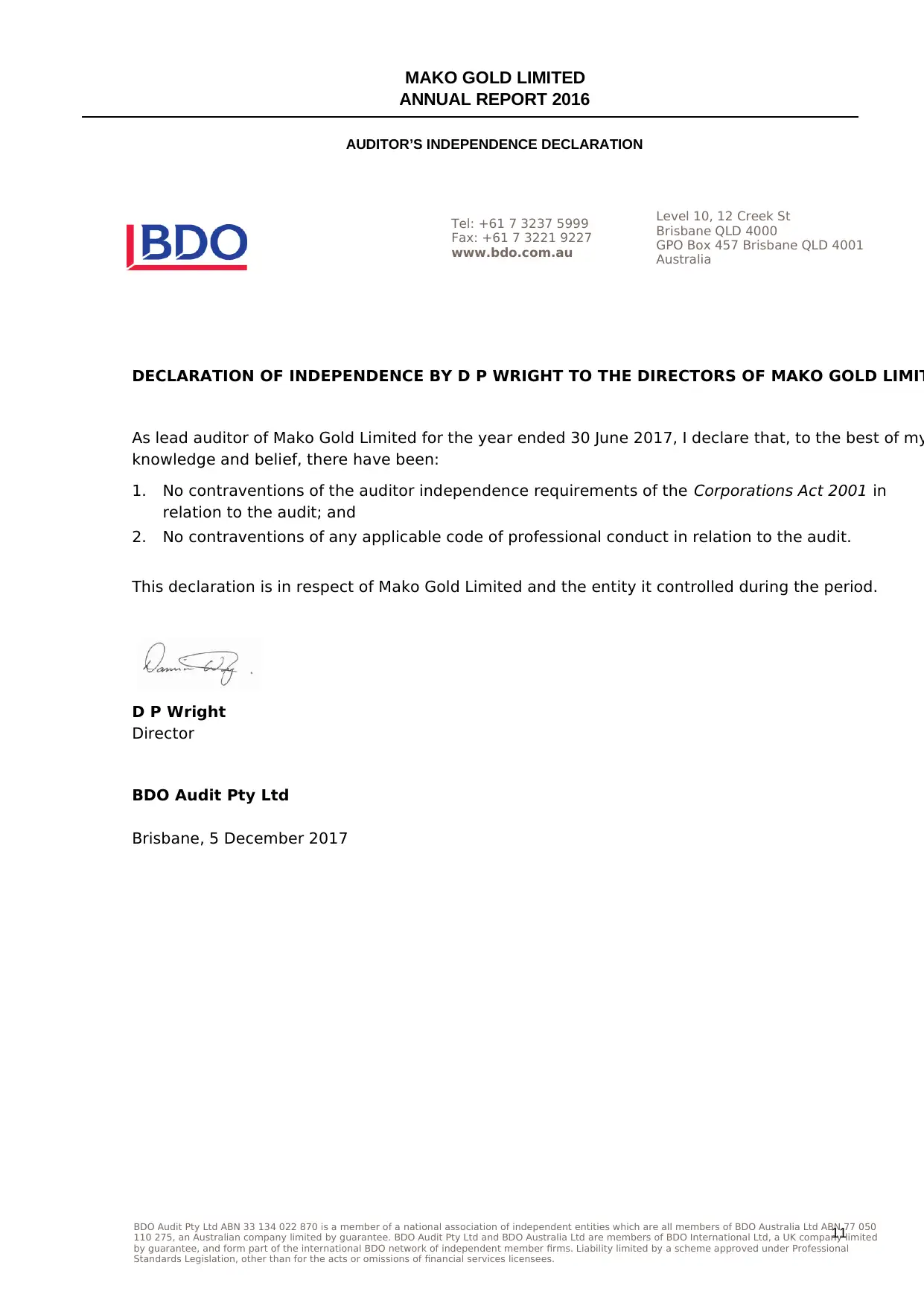
MAKO GOLD LIMITED
ANNUAL REPORT 2016
AUDITOR’S INDEPENDENCE DECLARATION
Tel: +61 7 3237 5999
Fax: +61 7 3221 9227
www.bdo.com.au
Level 10, 12 Creek St
Brisbane QLD 4000
GPO Box 457 Brisbane QLD 4001
Australia
BDO Audit Pty Ltd ABN 33 134 022 870 is a member of a national association of independent entities which are all members of BDO Australia Ltd ABN 77 050
110 275, an Australian company limited by guarantee. BDO Audit Pty Ltd and BDO Australia Ltd are members of BDO International Ltd, a UK company limited
by guarantee, and form part of the international BDO network of independent member firms. Liability limited by a scheme approved under Professional
Standards Legislation, other than for the acts or omissions of financial services licensees.
DECLARATION OF INDEPENDENCE BY D P WRIGHT TO THE DIRECTORS OF MAKO GOLD LIMIT
As lead auditor of Mako Gold Limited for the year ended 30 June 2017, I declare that, to the best of my
knowledge and belief, there have been:
1. No contraventions of the auditor independence requirements of the Corporations Act 2001 in
relation to the audit; and
2. No contraventions of any applicable code of professional conduct in relation to the audit.
This declaration is in respect of Mako Gold Limited and the entity it controlled during the period.
D P Wright
Director
BDO Audit Pty Ltd
Brisbane, 5 December 2017
11
ANNUAL REPORT 2016
AUDITOR’S INDEPENDENCE DECLARATION
Tel: +61 7 3237 5999
Fax: +61 7 3221 9227
www.bdo.com.au
Level 10, 12 Creek St
Brisbane QLD 4000
GPO Box 457 Brisbane QLD 4001
Australia
BDO Audit Pty Ltd ABN 33 134 022 870 is a member of a national association of independent entities which are all members of BDO Australia Ltd ABN 77 050
110 275, an Australian company limited by guarantee. BDO Audit Pty Ltd and BDO Australia Ltd are members of BDO International Ltd, a UK company limited
by guarantee, and form part of the international BDO network of independent member firms. Liability limited by a scheme approved under Professional
Standards Legislation, other than for the acts or omissions of financial services licensees.
DECLARATION OF INDEPENDENCE BY D P WRIGHT TO THE DIRECTORS OF MAKO GOLD LIMIT
As lead auditor of Mako Gold Limited for the year ended 30 June 2017, I declare that, to the best of my
knowledge and belief, there have been:
1. No contraventions of the auditor independence requirements of the Corporations Act 2001 in
relation to the audit; and
2. No contraventions of any applicable code of professional conduct in relation to the audit.
This declaration is in respect of Mako Gold Limited and the entity it controlled during the period.
D P Wright
Director
BDO Audit Pty Ltd
Brisbane, 5 December 2017
11

MAKO GOLD LIMITED
ANNUAL REPORT 2017
12
CONSOLIDATED STATEMENT PROFIT OR LOSS AND OTHER COMPREHENSIVE INCOME
FOR THE YEAR ENDED 30 JUNE 2017
Consolidated
2017
4 June
2015 to 30
June 2016
Note $ $
Revenue 2 - -
Other Income/(Expenses) 2 690 -
Employment costs 3 (17,333) -
Other expenses 3 (46,236) (26,399)
Loss before tax (62,879) (26,399)
Income tax expense 4 - -
Loss for the year (62,879) (26,399)
Other comprehensive income (6,401) (45)
Total comprehensive income for the year (69,280) (26,444)
Total comprehensive income for the year is attributable to:
Owners of Mako Gold Limited (69,280) (26,444)
Loss per share
Basic and diluted loss per share (cents per share) 18 (0.75) (26,398.89)
The above consolidated statement of profit or loss and other comprehensive income should be read in conjunction
with the accompanying notes
ANNUAL REPORT 2017
12
CONSOLIDATED STATEMENT PROFIT OR LOSS AND OTHER COMPREHENSIVE INCOME
FOR THE YEAR ENDED 30 JUNE 2017
Consolidated
2017
4 June
2015 to 30
June 2016
Note $ $
Revenue 2 - -
Other Income/(Expenses) 2 690 -
Employment costs 3 (17,333) -
Other expenses 3 (46,236) (26,399)
Loss before tax (62,879) (26,399)
Income tax expense 4 - -
Loss for the year (62,879) (26,399)
Other comprehensive income (6,401) (45)
Total comprehensive income for the year (69,280) (26,444)
Total comprehensive income for the year is attributable to:
Owners of Mako Gold Limited (69,280) (26,444)
Loss per share
Basic and diluted loss per share (cents per share) 18 (0.75) (26,398.89)
The above consolidated statement of profit or loss and other comprehensive income should be read in conjunction
with the accompanying notes
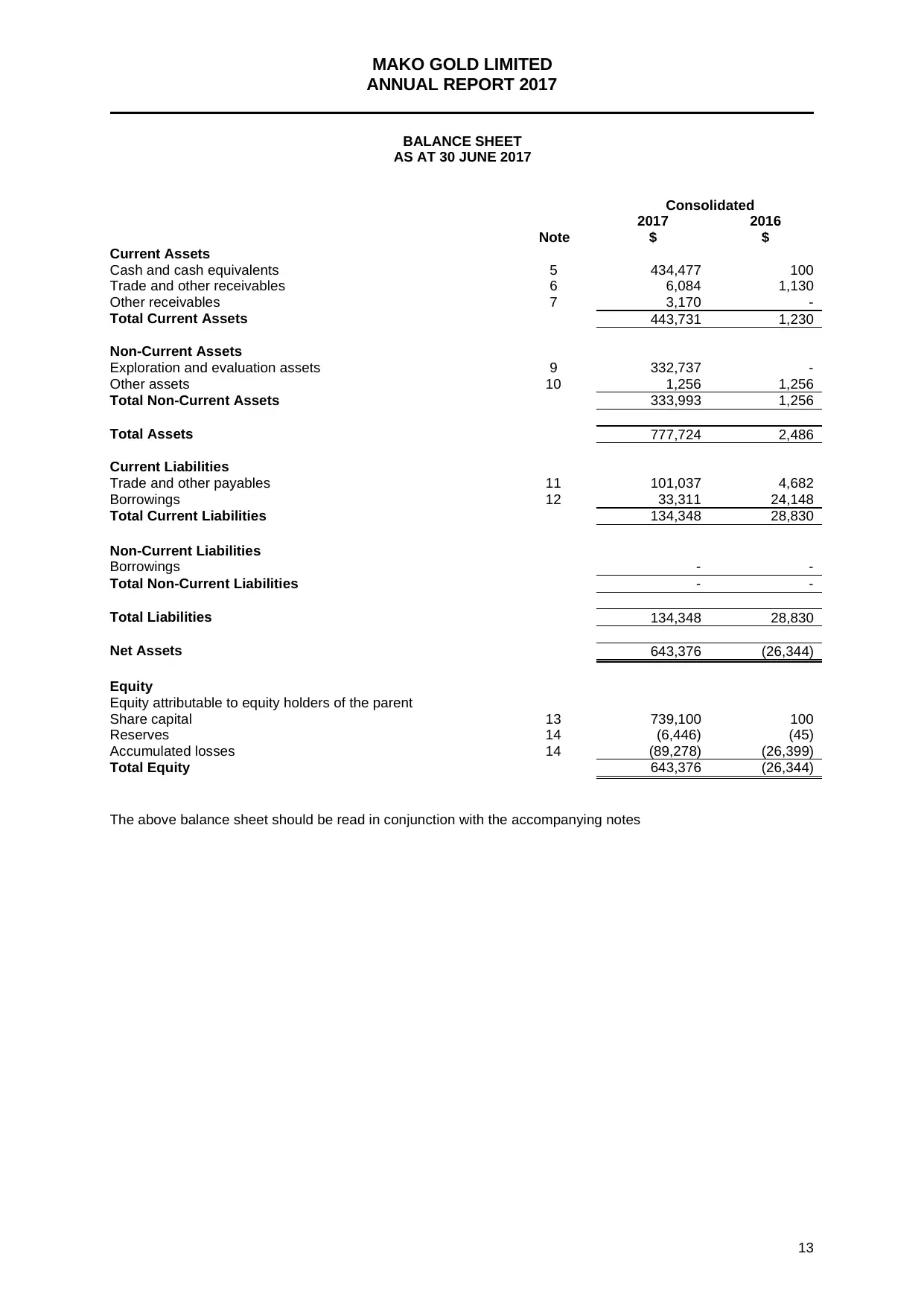
MAKO GOLD LIMITED
ANNUAL REPORT 2017
13
BALANCE SHEET
AS AT 30 JUNE 2017
Consolidated
2017 2016
Note $ $
Current Assets
Cash and cash equivalents 5 434,477 100
Trade and other receivables 6 6,084 1,130
Other receivables 7 3,170 -
Total Current Assets 443,731 1,230
Non-Current Assets
Exploration and evaluation assets 9 332,737 -
Other assets 10 1,256 1,256
Total Non-Current Assets 333,993 1,256
Total Assets 777,724 2,486
Current Liabilities
Trade and other payables 11 101,037 4,682
Borrowings 12 33,311 24,148
Total Current Liabilities 134,348 28,830
Non-Current Liabilities
Borrowings - -
Total Non-Current Liabilities - -
Total Liabilities 134,348 28,830
Net Assets 643,376 (26,344)
Equity
Equity attributable to equity holders of the parent
Share capital 13 739,100 100
Reserves 14 (6,446) (45)
Accumulated losses 14 (89,278) (26,399)
Total Equity 643,376 (26,344)
The above balance sheet should be read in conjunction with the accompanying notes
ANNUAL REPORT 2017
13
BALANCE SHEET
AS AT 30 JUNE 2017
Consolidated
2017 2016
Note $ $
Current Assets
Cash and cash equivalents 5 434,477 100
Trade and other receivables 6 6,084 1,130
Other receivables 7 3,170 -
Total Current Assets 443,731 1,230
Non-Current Assets
Exploration and evaluation assets 9 332,737 -
Other assets 10 1,256 1,256
Total Non-Current Assets 333,993 1,256
Total Assets 777,724 2,486
Current Liabilities
Trade and other payables 11 101,037 4,682
Borrowings 12 33,311 24,148
Total Current Liabilities 134,348 28,830
Non-Current Liabilities
Borrowings - -
Total Non-Current Liabilities - -
Total Liabilities 134,348 28,830
Net Assets 643,376 (26,344)
Equity
Equity attributable to equity holders of the parent
Share capital 13 739,100 100
Reserves 14 (6,446) (45)
Accumulated losses 14 (89,278) (26,399)
Total Equity 643,376 (26,344)
The above balance sheet should be read in conjunction with the accompanying notes
Paraphrase This Document
Need a fresh take? Get an instant paraphrase of this document with our AI Paraphraser
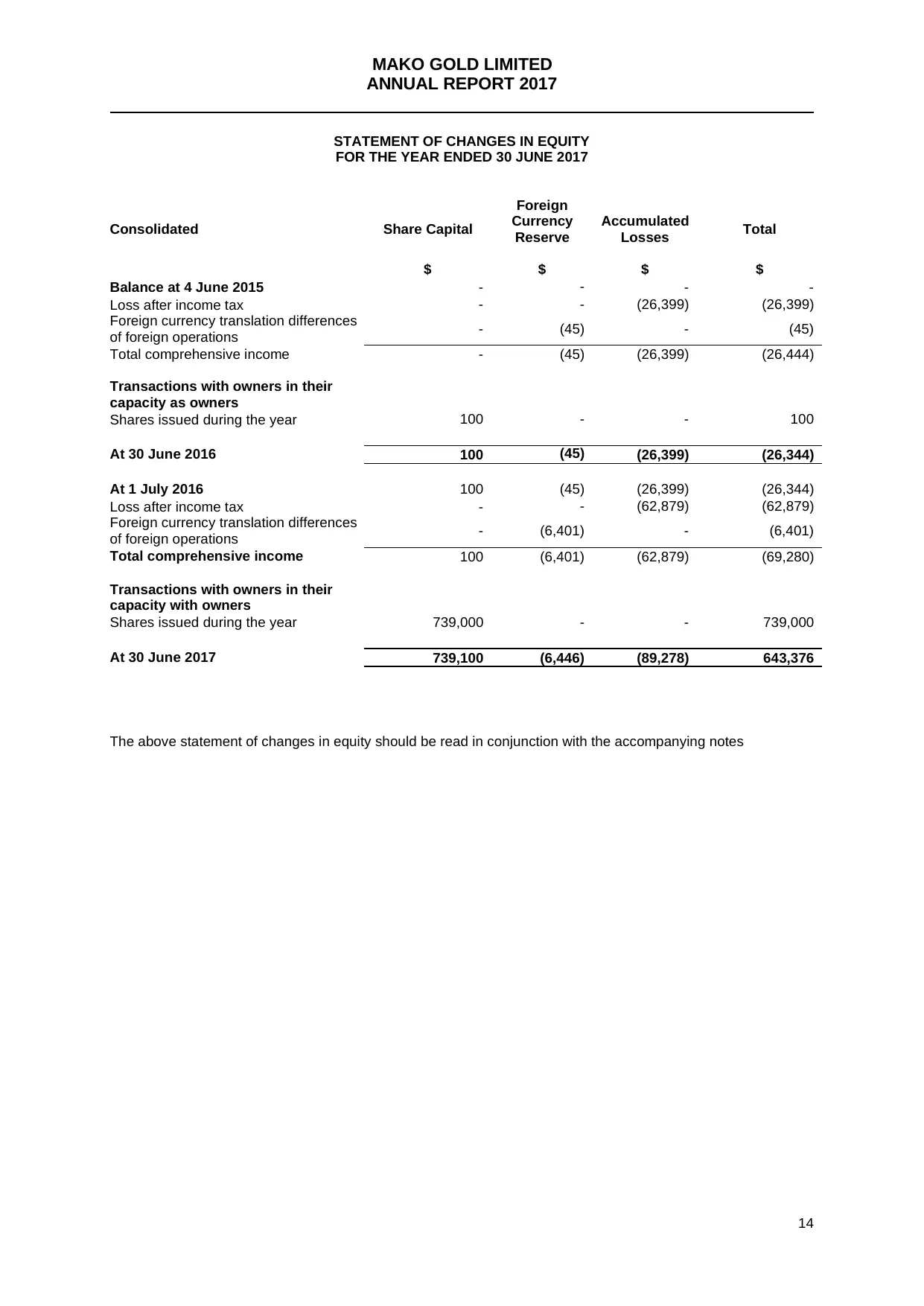
MAKO GOLD LIMITED
ANNUAL REPORT 2017
14
STATEMENT OF CHANGES IN EQUITY
FOR THE YEAR ENDED 30 JUNE 2017
Consolidated Share Capital
Foreign
Currency
Reserve
Accumulated
Losses Total
$ $ $ $
Balance at 4 June 2015 - - - -
Loss after income tax - - (26,399) (26,399)
Foreign currency translation differences
of foreign operations - (45) - (45)
Total comprehensive income - (45) (26,399) (26,444)
Transactions with owners in their
capacity as owners
Shares issued during the year 100 - - 100
At 30 June 2016 100 (45) (26,399) (26,344)
At 1 July 2016 100 (45) (26,399) (26,344)
Loss after income tax - - (62,879) (62,879)
Foreign currency translation differences
of foreign operations - (6,401) - (6,401)
Total comprehensive income 100 (6,401) (62,879) (69,280)
Transactions with owners in their
capacity with owners
Shares issued during the year 739,000 - - 739,000
At 30 June 2017 739,100 (6,446) (89,278) 643,376
The above statement of changes in equity should be read in conjunction with the accompanying notes
ANNUAL REPORT 2017
14
STATEMENT OF CHANGES IN EQUITY
FOR THE YEAR ENDED 30 JUNE 2017
Consolidated Share Capital
Foreign
Currency
Reserve
Accumulated
Losses Total
$ $ $ $
Balance at 4 June 2015 - - - -
Loss after income tax - - (26,399) (26,399)
Foreign currency translation differences
of foreign operations - (45) - (45)
Total comprehensive income - (45) (26,399) (26,444)
Transactions with owners in their
capacity as owners
Shares issued during the year 100 - - 100
At 30 June 2016 100 (45) (26,399) (26,344)
At 1 July 2016 100 (45) (26,399) (26,344)
Loss after income tax - - (62,879) (62,879)
Foreign currency translation differences
of foreign operations - (6,401) - (6,401)
Total comprehensive income 100 (6,401) (62,879) (69,280)
Transactions with owners in their
capacity with owners
Shares issued during the year 739,000 - - 739,000
At 30 June 2017 739,100 (6,446) (89,278) 643,376
The above statement of changes in equity should be read in conjunction with the accompanying notes
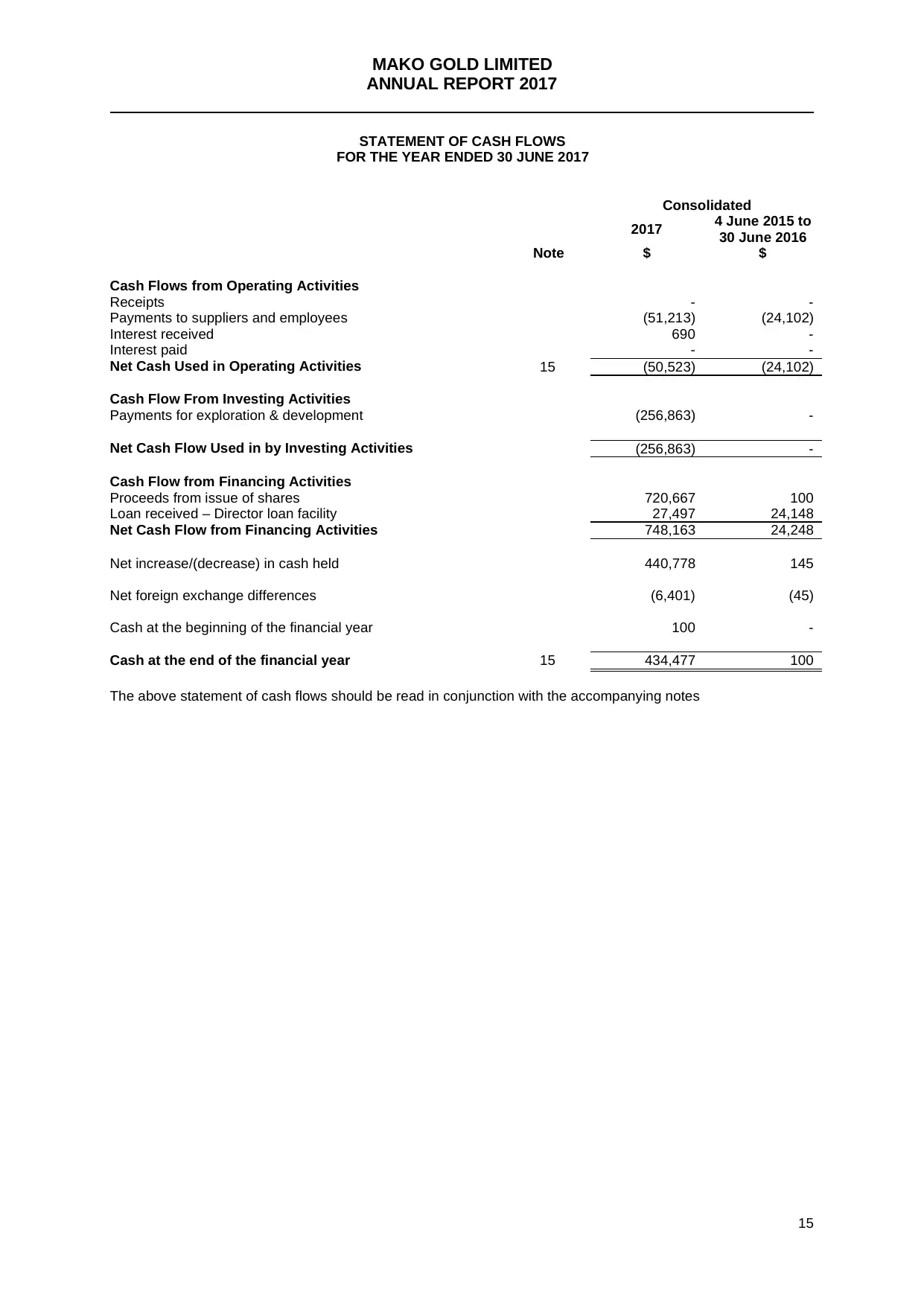
MAKO GOLD LIMITED
ANNUAL REPORT 2017
15
STATEMENT OF CASH FLOWS
FOR THE YEAR ENDED 30 JUNE 2017
Consolidated
2017 4 June 2015 to
30 June 2016
Note $ $
Cash Flows from Operating Activities
Receipts - -
Payments to suppliers and employees (51,213) (24,102)
Interest received 690 -
Interest paid - -
Net Cash Used in Operating Activities 15 (50,523) (24,102)
Cash Flow From Investing Activities
Payments for exploration & development (256,863) -
Net Cash Flow Used in by Investing Activities (256,863) -
Cash Flow from Financing Activities
Proceeds from issue of shares 720,667 100
Loan received – Director loan facility 27,497 24,148
Net Cash Flow from Financing Activities 748,163 24,248
Net increase/(decrease) in cash held 440,778 145
Net foreign exchange differences (6,401) (45)
Cash at the beginning of the financial year 100 -
Cash at the end of the financial year 15 434,477 100
The above statement of cash flows should be read in conjunction with the accompanying notes
ANNUAL REPORT 2017
15
STATEMENT OF CASH FLOWS
FOR THE YEAR ENDED 30 JUNE 2017
Consolidated
2017 4 June 2015 to
30 June 2016
Note $ $
Cash Flows from Operating Activities
Receipts - -
Payments to suppliers and employees (51,213) (24,102)
Interest received 690 -
Interest paid - -
Net Cash Used in Operating Activities 15 (50,523) (24,102)
Cash Flow From Investing Activities
Payments for exploration & development (256,863) -
Net Cash Flow Used in by Investing Activities (256,863) -
Cash Flow from Financing Activities
Proceeds from issue of shares 720,667 100
Loan received – Director loan facility 27,497 24,148
Net Cash Flow from Financing Activities 748,163 24,248
Net increase/(decrease) in cash held 440,778 145
Net foreign exchange differences (6,401) (45)
Cash at the beginning of the financial year 100 -
Cash at the end of the financial year 15 434,477 100
The above statement of cash flows should be read in conjunction with the accompanying notes
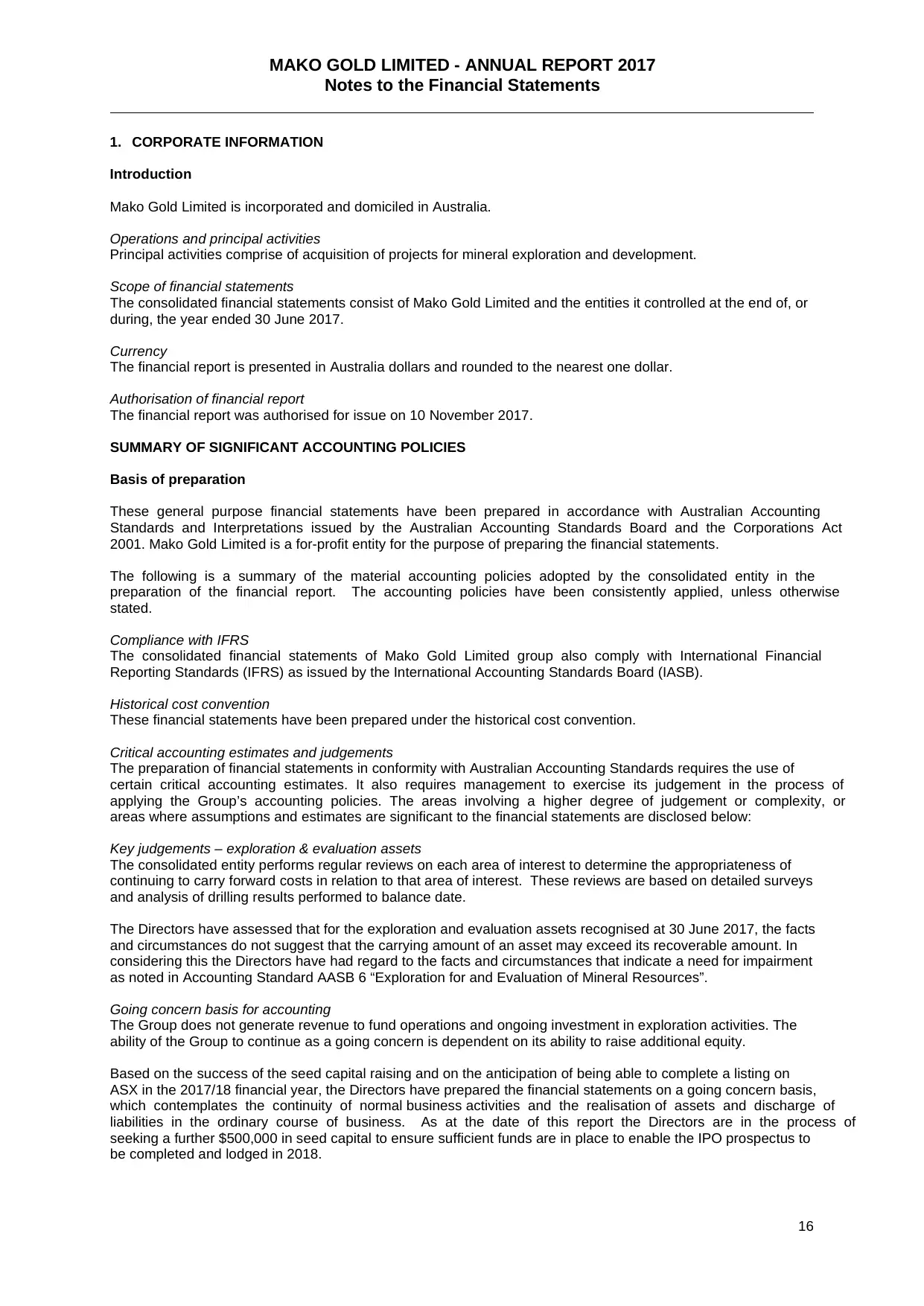
MAKO GOLD LIMITED - ANNUAL REPORT 2017
Notes to the Financial Statements
16
1. CORPORATE INFORMATION
Introduction
Mako Gold Limited is incorporated and domiciled in Australia.
Operations and principal activities
Principal activities comprise of acquisition of projects for mineral exploration and development.
Scope of financial statements
The consolidated financial statements consist of Mako Gold Limited and the entities it controlled at the end of, or
during, the year ended 30 June 2017.
Currency
The financial report is presented in Australia dollars and rounded to the nearest one dollar.
Authorisation of financial report
The financial report was authorised for issue on 10 November 2017.
SUMMARY OF SIGNIFICANT ACCOUNTING POLICIES
Basis of preparation
These general purpose financial statements have been prepared in accordance with Australian Accounting
Standards and Interpretations issued by the Australian Accounting Standards Board and the Corporations Act
2001. Mako Gold Limited is a for-profit entity for the purpose of preparing the financial statements.
The following is a summary of the material accounting policies adopted by the consolidated entity in the
preparation of the financial report. The accounting policies have been consistently applied, unless otherwise
stated.
Compliance with IFRS
The consolidated financial statements of Mako Gold Limited group also comply with International Financial
Reporting Standards (IFRS) as issued by the International Accounting Standards Board (IASB).
Historical cost convention
These financial statements have been prepared under the historical cost convention.
Critical accounting estimates and judgements
The preparation of financial statements in conformity with Australian Accounting Standards requires the use of
certain critical accounting estimates. It also requires management to exercise its judgement in the process of
applying the Group’s accounting policies. The areas involving a higher degree of judgement or complexity, or
areas where assumptions and estimates are significant to the financial statements are disclosed below:
Key judgements – exploration & evaluation assets
The consolidated entity performs regular reviews on each area of interest to determine the appropriateness of
continuing to carry forward costs in relation to that area of interest. These reviews are based on detailed surveys
and analysis of drilling results performed to balance date.
The Directors have assessed that for the exploration and evaluation assets recognised at 30 June 2017, the facts
and circumstances do not suggest that the carrying amount of an asset may exceed its recoverable amount. In
considering this the Directors have had regard to the facts and circumstances that indicate a need for impairment
as noted in Accounting Standard AASB 6 “Exploration for and Evaluation of Mineral Resources”.
Going concern basis for accounting
The Group does not generate revenue to fund operations and ongoing investment in exploration activities. The
ability of the Group to continue as a going concern is dependent on its ability to raise additional equity.
Based on the success of the seed capital raising and on the anticipation of being able to complete a listing on
ASX in the 2017/18 financial year, the Directors have prepared the financial statements on a going concern basis,
which contemplates the continuity of normal business activities and the realisation of assets and discharge of
liabilities in the ordinary course of business. As at the date of this report the Directors are in the process of
seeking a further $500,000 in seed capital to ensure sufficient funds are in place to enable the IPO prospectus to
be completed and lodged in 2018.
Notes to the Financial Statements
16
1. CORPORATE INFORMATION
Introduction
Mako Gold Limited is incorporated and domiciled in Australia.
Operations and principal activities
Principal activities comprise of acquisition of projects for mineral exploration and development.
Scope of financial statements
The consolidated financial statements consist of Mako Gold Limited and the entities it controlled at the end of, or
during, the year ended 30 June 2017.
Currency
The financial report is presented in Australia dollars and rounded to the nearest one dollar.
Authorisation of financial report
The financial report was authorised for issue on 10 November 2017.
SUMMARY OF SIGNIFICANT ACCOUNTING POLICIES
Basis of preparation
These general purpose financial statements have been prepared in accordance with Australian Accounting
Standards and Interpretations issued by the Australian Accounting Standards Board and the Corporations Act
2001. Mako Gold Limited is a for-profit entity for the purpose of preparing the financial statements.
The following is a summary of the material accounting policies adopted by the consolidated entity in the
preparation of the financial report. The accounting policies have been consistently applied, unless otherwise
stated.
Compliance with IFRS
The consolidated financial statements of Mako Gold Limited group also comply with International Financial
Reporting Standards (IFRS) as issued by the International Accounting Standards Board (IASB).
Historical cost convention
These financial statements have been prepared under the historical cost convention.
Critical accounting estimates and judgements
The preparation of financial statements in conformity with Australian Accounting Standards requires the use of
certain critical accounting estimates. It also requires management to exercise its judgement in the process of
applying the Group’s accounting policies. The areas involving a higher degree of judgement or complexity, or
areas where assumptions and estimates are significant to the financial statements are disclosed below:
Key judgements – exploration & evaluation assets
The consolidated entity performs regular reviews on each area of interest to determine the appropriateness of
continuing to carry forward costs in relation to that area of interest. These reviews are based on detailed surveys
and analysis of drilling results performed to balance date.
The Directors have assessed that for the exploration and evaluation assets recognised at 30 June 2017, the facts
and circumstances do not suggest that the carrying amount of an asset may exceed its recoverable amount. In
considering this the Directors have had regard to the facts and circumstances that indicate a need for impairment
as noted in Accounting Standard AASB 6 “Exploration for and Evaluation of Mineral Resources”.
Going concern basis for accounting
The Group does not generate revenue to fund operations and ongoing investment in exploration activities. The
ability of the Group to continue as a going concern is dependent on its ability to raise additional equity.
Based on the success of the seed capital raising and on the anticipation of being able to complete a listing on
ASX in the 2017/18 financial year, the Directors have prepared the financial statements on a going concern basis,
which contemplates the continuity of normal business activities and the realisation of assets and discharge of
liabilities in the ordinary course of business. As at the date of this report the Directors are in the process of
seeking a further $500,000 in seed capital to ensure sufficient funds are in place to enable the IPO prospectus to
be completed and lodged in 2018.
Secure Best Marks with AI Grader
Need help grading? Try our AI Grader for instant feedback on your assignments.
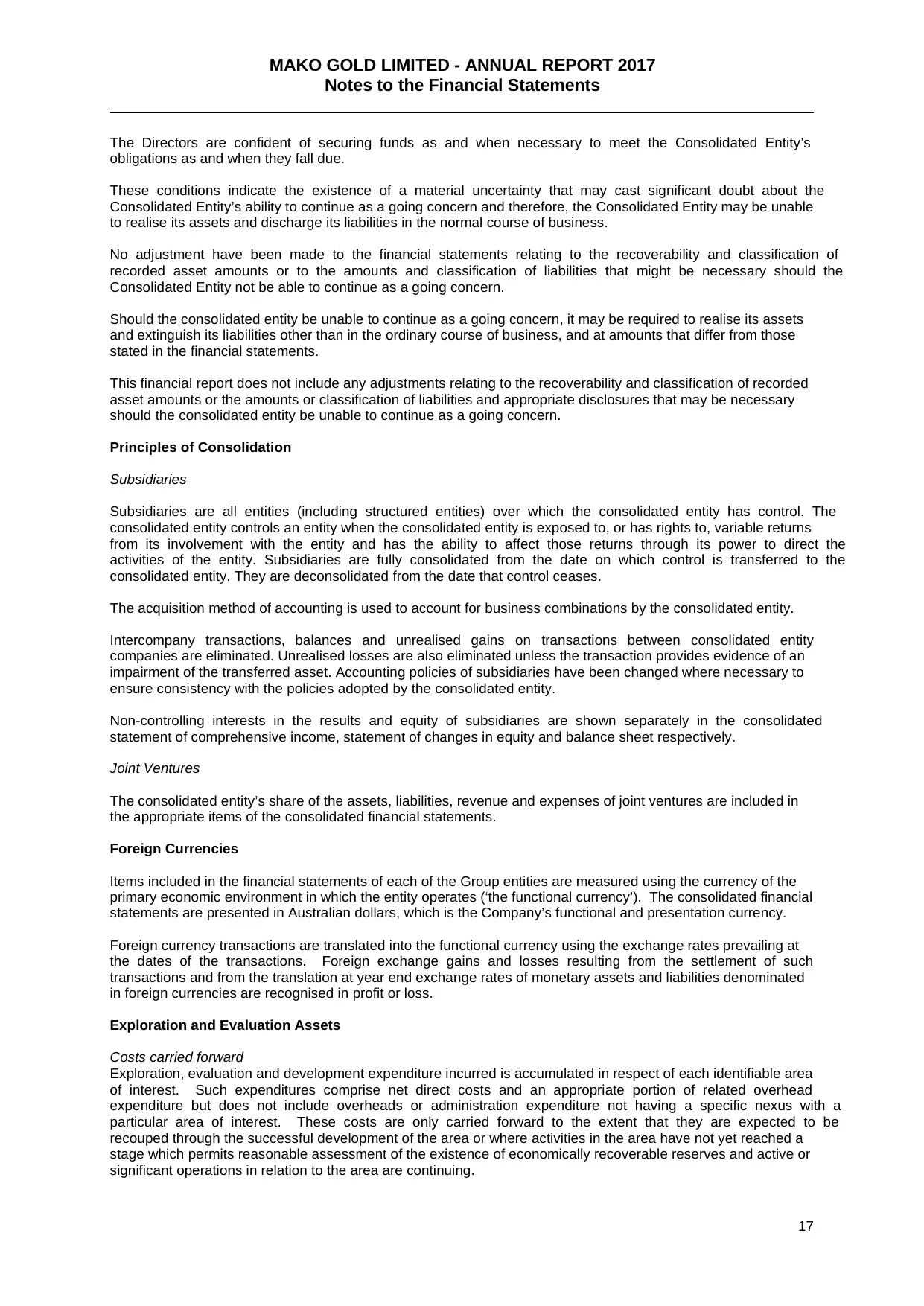
MAKO GOLD LIMITED - ANNUAL REPORT 2017
Notes to the Financial Statements
17
The Directors are confident of securing funds as and when necessary to meet the Consolidated Entity’s
obligations as and when they fall due.
These conditions indicate the existence of a material uncertainty that may cast significant doubt about the
Consolidated Entity’s ability to continue as a going concern and therefore, the Consolidated Entity may be unable
to realise its assets and discharge its liabilities in the normal course of business.
No adjustment have been made to the financial statements relating to the recoverability and classification of
recorded asset amounts or to the amounts and classification of liabilities that might be necessary should the
Consolidated Entity not be able to continue as a going concern.
Should the consolidated entity be unable to continue as a going concern, it may be required to realise its assets
and extinguish its liabilities other than in the ordinary course of business, and at amounts that differ from those
stated in the financial statements.
This financial report does not include any adjustments relating to the recoverability and classification of recorded
asset amounts or the amounts or classification of liabilities and appropriate disclosures that may be necessary
should the consolidated entity be unable to continue as a going concern.
Principles of Consolidation
Subsidiaries
Subsidiaries are all entities (including structured entities) over which the consolidated entity has control. The
consolidated entity controls an entity when the consolidated entity is exposed to, or has rights to, variable returns
from its involvement with the entity and has the ability to affect those returns through its power to direct the
activities of the entity. Subsidiaries are fully consolidated from the date on which control is transferred to the
consolidated entity. They are deconsolidated from the date that control ceases.
The acquisition method of accounting is used to account for business combinations by the consolidated entity.
Intercompany transactions, balances and unrealised gains on transactions between consolidated entity
companies are eliminated. Unrealised losses are also eliminated unless the transaction provides evidence of an
impairment of the transferred asset. Accounting policies of subsidiaries have been changed where necessary to
ensure consistency with the policies adopted by the consolidated entity.
Non-controlling interests in the results and equity of subsidiaries are shown separately in the consolidated
statement of comprehensive income, statement of changes in equity and balance sheet respectively.
Joint Ventures
The consolidated entity’s share of the assets, liabilities, revenue and expenses of joint ventures are included in
the appropriate items of the consolidated financial statements.
Foreign Currencies
Items included in the financial statements of each of the Group entities are measured using the currency of the
primary economic environment in which the entity operates (‘the functional currency’). The consolidated financial
statements are presented in Australian dollars, which is the Company’s functional and presentation currency.
Foreign currency transactions are translated into the functional currency using the exchange rates prevailing at
the dates of the transactions. Foreign exchange gains and losses resulting from the settlement of such
transactions and from the translation at year end exchange rates of monetary assets and liabilities denominated
in foreign currencies are recognised in profit or loss.
Exploration and Evaluation Assets
Costs carried forward
Exploration, evaluation and development expenditure incurred is accumulated in respect of each identifiable area
of interest. Such expenditures comprise net direct costs and an appropriate portion of related overhead
expenditure but does not include overheads or administration expenditure not having a specific nexus with a
particular area of interest. These costs are only carried forward to the extent that they are expected to be
recouped through the successful development of the area or where activities in the area have not yet reached a
stage which permits reasonable assessment of the existence of economically recoverable reserves and active or
significant operations in relation to the area are continuing.
Notes to the Financial Statements
17
The Directors are confident of securing funds as and when necessary to meet the Consolidated Entity’s
obligations as and when they fall due.
These conditions indicate the existence of a material uncertainty that may cast significant doubt about the
Consolidated Entity’s ability to continue as a going concern and therefore, the Consolidated Entity may be unable
to realise its assets and discharge its liabilities in the normal course of business.
No adjustment have been made to the financial statements relating to the recoverability and classification of
recorded asset amounts or to the amounts and classification of liabilities that might be necessary should the
Consolidated Entity not be able to continue as a going concern.
Should the consolidated entity be unable to continue as a going concern, it may be required to realise its assets
and extinguish its liabilities other than in the ordinary course of business, and at amounts that differ from those
stated in the financial statements.
This financial report does not include any adjustments relating to the recoverability and classification of recorded
asset amounts or the amounts or classification of liabilities and appropriate disclosures that may be necessary
should the consolidated entity be unable to continue as a going concern.
Principles of Consolidation
Subsidiaries
Subsidiaries are all entities (including structured entities) over which the consolidated entity has control. The
consolidated entity controls an entity when the consolidated entity is exposed to, or has rights to, variable returns
from its involvement with the entity and has the ability to affect those returns through its power to direct the
activities of the entity. Subsidiaries are fully consolidated from the date on which control is transferred to the
consolidated entity. They are deconsolidated from the date that control ceases.
The acquisition method of accounting is used to account for business combinations by the consolidated entity.
Intercompany transactions, balances and unrealised gains on transactions between consolidated entity
companies are eliminated. Unrealised losses are also eliminated unless the transaction provides evidence of an
impairment of the transferred asset. Accounting policies of subsidiaries have been changed where necessary to
ensure consistency with the policies adopted by the consolidated entity.
Non-controlling interests in the results and equity of subsidiaries are shown separately in the consolidated
statement of comprehensive income, statement of changes in equity and balance sheet respectively.
Joint Ventures
The consolidated entity’s share of the assets, liabilities, revenue and expenses of joint ventures are included in
the appropriate items of the consolidated financial statements.
Foreign Currencies
Items included in the financial statements of each of the Group entities are measured using the currency of the
primary economic environment in which the entity operates (‘the functional currency’). The consolidated financial
statements are presented in Australian dollars, which is the Company’s functional and presentation currency.
Foreign currency transactions are translated into the functional currency using the exchange rates prevailing at
the dates of the transactions. Foreign exchange gains and losses resulting from the settlement of such
transactions and from the translation at year end exchange rates of monetary assets and liabilities denominated
in foreign currencies are recognised in profit or loss.
Exploration and Evaluation Assets
Costs carried forward
Exploration, evaluation and development expenditure incurred is accumulated in respect of each identifiable area
of interest. Such expenditures comprise net direct costs and an appropriate portion of related overhead
expenditure but does not include overheads or administration expenditure not having a specific nexus with a
particular area of interest. These costs are only carried forward to the extent that they are expected to be
recouped through the successful development of the area or where activities in the area have not yet reached a
stage which permits reasonable assessment of the existence of economically recoverable reserves and active or
significant operations in relation to the area are continuing.
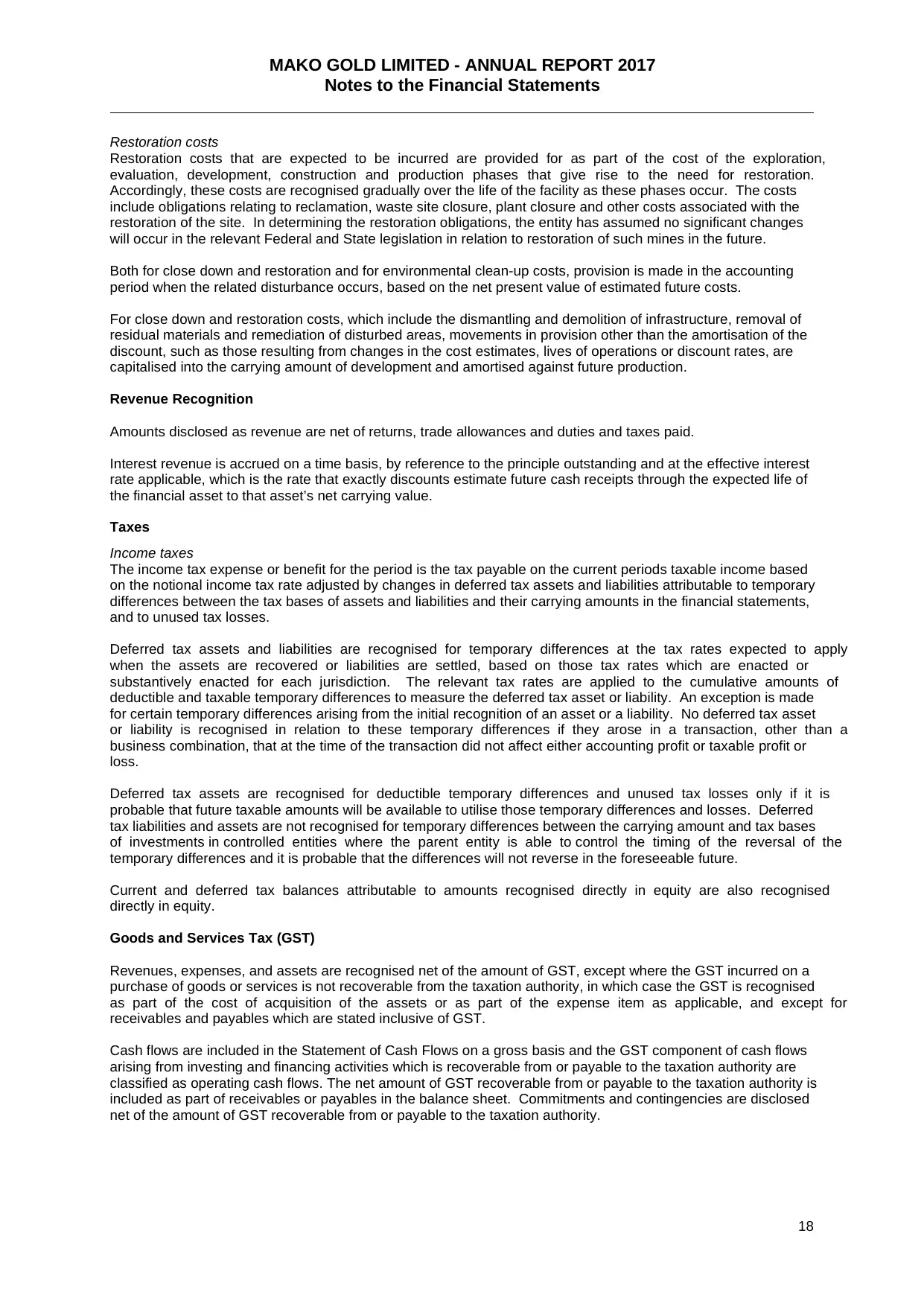
MAKO GOLD LIMITED - ANNUAL REPORT 2017
Notes to the Financial Statements
18
Restoration costs
Restoration costs that are expected to be incurred are provided for as part of the cost of the exploration,
evaluation, development, construction and production phases that give rise to the need for restoration.
Accordingly, these costs are recognised gradually over the life of the facility as these phases occur. The costs
include obligations relating to reclamation, waste site closure, plant closure and other costs associated with the
restoration of the site. In determining the restoration obligations, the entity has assumed no significant changes
will occur in the relevant Federal and State legislation in relation to restoration of such mines in the future.
Both for close down and restoration and for environmental clean-up costs, provision is made in the accounting
period when the related disturbance occurs, based on the net present value of estimated future costs.
For close down and restoration costs, which include the dismantling and demolition of infrastructure, removal of
residual materials and remediation of disturbed areas, movements in provision other than the amortisation of the
discount, such as those resulting from changes in the cost estimates, lives of operations or discount rates, are
capitalised into the carrying amount of development and amortised against future production.
Revenue Recognition
Amounts disclosed as revenue are net of returns, trade allowances and duties and taxes paid.
Interest revenue is accrued on a time basis, by reference to the principle outstanding and at the effective interest
rate applicable, which is the rate that exactly discounts estimate future cash receipts through the expected life of
the financial asset to that asset’s net carrying value.
Taxes
Income taxes
The income tax expense or benefit for the period is the tax payable on the current periods taxable income based
on the notional income tax rate adjusted by changes in deferred tax assets and liabilities attributable to temporary
differences between the tax bases of assets and liabilities and their carrying amounts in the financial statements,
and to unused tax losses.
Deferred tax assets and liabilities are recognised for temporary differences at the tax rates expected to apply
when the assets are recovered or liabilities are settled, based on those tax rates which are enacted or
substantively enacted for each jurisdiction. The relevant tax rates are applied to the cumulative amounts of
deductible and taxable temporary differences to measure the deferred tax asset or liability. An exception is made
for certain temporary differences arising from the initial recognition of an asset or a liability. No deferred tax asset
or liability is recognised in relation to these temporary differences if they arose in a transaction, other than a
business combination, that at the time of the transaction did not affect either accounting profit or taxable profit or
loss.
Deferred tax assets are recognised for deductible temporary differences and unused tax losses only if it is
probable that future taxable amounts will be available to utilise those temporary differences and losses. Deferred
tax liabilities and assets are not recognised for temporary differences between the carrying amount and tax bases
of investments in controlled entities where the parent entity is able to control the timing of the reversal of the
temporary differences and it is probable that the differences will not reverse in the foreseeable future.
Current and deferred tax balances attributable to amounts recognised directly in equity are also recognised
directly in equity.
Goods and Services Tax (GST)
Revenues, expenses, and assets are recognised net of the amount of GST, except where the GST incurred on a
purchase of goods or services is not recoverable from the taxation authority, in which case the GST is recognised
as part of the cost of acquisition of the assets or as part of the expense item as applicable, and except for
receivables and payables which are stated inclusive of GST.
Cash flows are included in the Statement of Cash Flows on a gross basis and the GST component of cash flows
arising from investing and financing activities which is recoverable from or payable to the taxation authority are
classified as operating cash flows. The net amount of GST recoverable from or payable to the taxation authority is
included as part of receivables or payables in the balance sheet. Commitments and contingencies are disclosed
net of the amount of GST recoverable from or payable to the taxation authority.
Notes to the Financial Statements
18
Restoration costs
Restoration costs that are expected to be incurred are provided for as part of the cost of the exploration,
evaluation, development, construction and production phases that give rise to the need for restoration.
Accordingly, these costs are recognised gradually over the life of the facility as these phases occur. The costs
include obligations relating to reclamation, waste site closure, plant closure and other costs associated with the
restoration of the site. In determining the restoration obligations, the entity has assumed no significant changes
will occur in the relevant Federal and State legislation in relation to restoration of such mines in the future.
Both for close down and restoration and for environmental clean-up costs, provision is made in the accounting
period when the related disturbance occurs, based on the net present value of estimated future costs.
For close down and restoration costs, which include the dismantling and demolition of infrastructure, removal of
residual materials and remediation of disturbed areas, movements in provision other than the amortisation of the
discount, such as those resulting from changes in the cost estimates, lives of operations or discount rates, are
capitalised into the carrying amount of development and amortised against future production.
Revenue Recognition
Amounts disclosed as revenue are net of returns, trade allowances and duties and taxes paid.
Interest revenue is accrued on a time basis, by reference to the principle outstanding and at the effective interest
rate applicable, which is the rate that exactly discounts estimate future cash receipts through the expected life of
the financial asset to that asset’s net carrying value.
Taxes
Income taxes
The income tax expense or benefit for the period is the tax payable on the current periods taxable income based
on the notional income tax rate adjusted by changes in deferred tax assets and liabilities attributable to temporary
differences between the tax bases of assets and liabilities and their carrying amounts in the financial statements,
and to unused tax losses.
Deferred tax assets and liabilities are recognised for temporary differences at the tax rates expected to apply
when the assets are recovered or liabilities are settled, based on those tax rates which are enacted or
substantively enacted for each jurisdiction. The relevant tax rates are applied to the cumulative amounts of
deductible and taxable temporary differences to measure the deferred tax asset or liability. An exception is made
for certain temporary differences arising from the initial recognition of an asset or a liability. No deferred tax asset
or liability is recognised in relation to these temporary differences if they arose in a transaction, other than a
business combination, that at the time of the transaction did not affect either accounting profit or taxable profit or
loss.
Deferred tax assets are recognised for deductible temporary differences and unused tax losses only if it is
probable that future taxable amounts will be available to utilise those temporary differences and losses. Deferred
tax liabilities and assets are not recognised for temporary differences between the carrying amount and tax bases
of investments in controlled entities where the parent entity is able to control the timing of the reversal of the
temporary differences and it is probable that the differences will not reverse in the foreseeable future.
Current and deferred tax balances attributable to amounts recognised directly in equity are also recognised
directly in equity.
Goods and Services Tax (GST)
Revenues, expenses, and assets are recognised net of the amount of GST, except where the GST incurred on a
purchase of goods or services is not recoverable from the taxation authority, in which case the GST is recognised
as part of the cost of acquisition of the assets or as part of the expense item as applicable, and except for
receivables and payables which are stated inclusive of GST.
Cash flows are included in the Statement of Cash Flows on a gross basis and the GST component of cash flows
arising from investing and financing activities which is recoverable from or payable to the taxation authority are
classified as operating cash flows. The net amount of GST recoverable from or payable to the taxation authority is
included as part of receivables or payables in the balance sheet. Commitments and contingencies are disclosed
net of the amount of GST recoverable from or payable to the taxation authority.
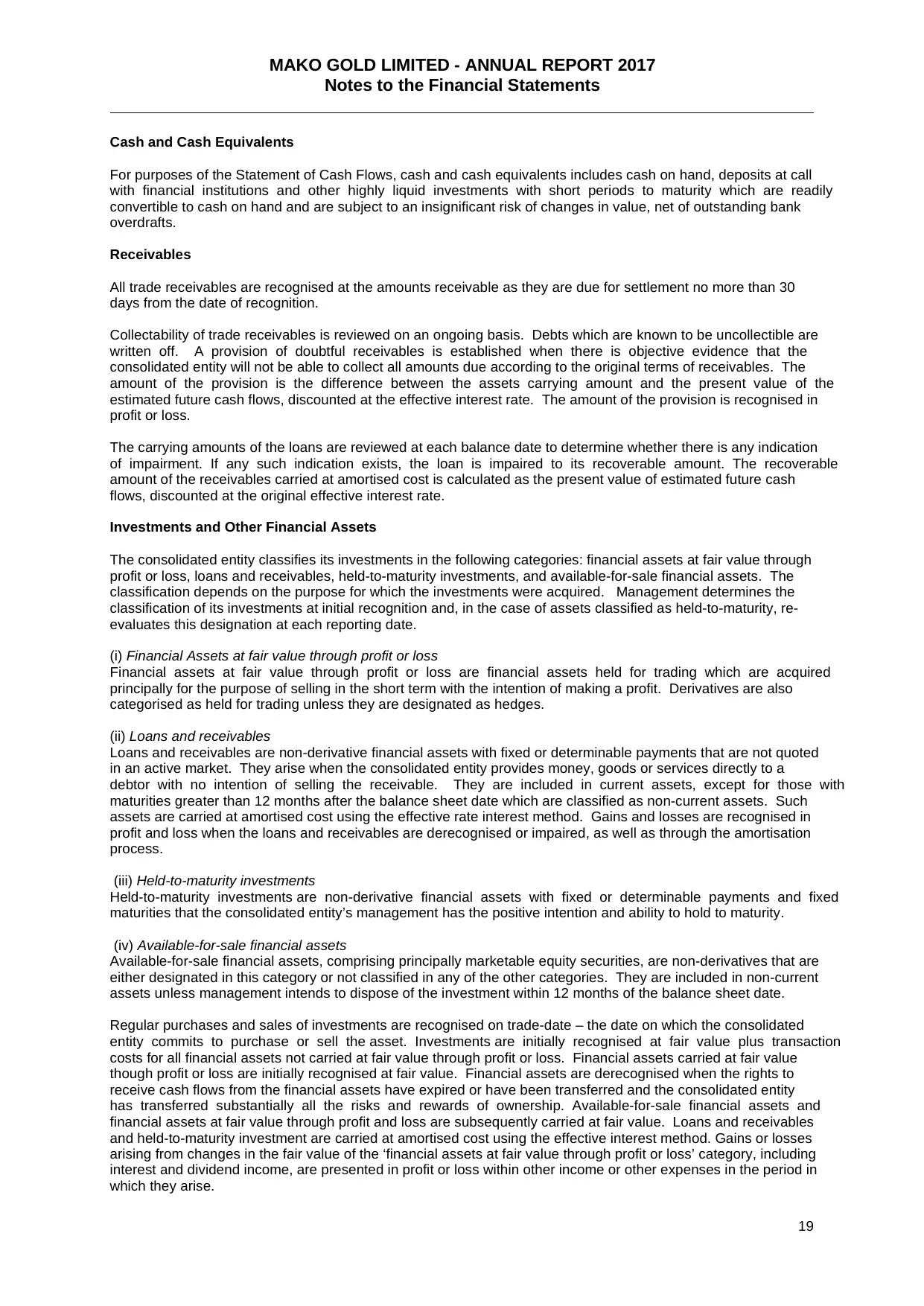
MAKO GOLD LIMITED - ANNUAL REPORT 2017
Notes to the Financial Statements
19
Cash and Cash Equivalents
For purposes of the Statement of Cash Flows, cash and cash equivalents includes cash on hand, deposits at call
with financial institutions and other highly liquid investments with short periods to maturity which are readily
convertible to cash on hand and are subject to an insignificant risk of changes in value, net of outstanding bank
overdrafts.
Receivables
All trade receivables are recognised at the amounts receivable as they are due for settlement no more than 30
days from the date of recognition.
Collectability of trade receivables is reviewed on an ongoing basis. Debts which are known to be uncollectible are
written off. A provision of doubtful receivables is established when there is objective evidence that the
consolidated entity will not be able to collect all amounts due according to the original terms of receivables. The
amount of the provision is the difference between the assets carrying amount and the present value of the
estimated future cash flows, discounted at the effective interest rate. The amount of the provision is recognised in
profit or loss.
The carrying amounts of the loans are reviewed at each balance date to determine whether there is any indication
of impairment. If any such indication exists, the loan is impaired to its recoverable amount. The recoverable
amount of the receivables carried at amortised cost is calculated as the present value of estimated future cash
flows, discounted at the original effective interest rate.
Investments and Other Financial Assets
The consolidated entity classifies its investments in the following categories: financial assets at fair value through
profit or loss, loans and receivables, held-to-maturity investments, and available-for-sale financial assets. The
classification depends on the purpose for which the investments were acquired. Management determines the
classification of its investments at initial recognition and, in the case of assets classified as held-to-maturity, re-
evaluates this designation at each reporting date.
(i) Financial Assets at fair value through profit or loss
Financial assets at fair value through profit or loss are financial assets held for trading which are acquired
principally for the purpose of selling in the short term with the intention of making a profit. Derivatives are also
categorised as held for trading unless they are designated as hedges.
(ii) Loans and receivables
Loans and receivables are non-derivative financial assets with fixed or determinable payments that are not quoted
in an active market. They arise when the consolidated entity provides money, goods or services directly to a
debtor with no intention of selling the receivable. They are included in current assets, except for those with
maturities greater than 12 months after the balance sheet date which are classified as non-current assets. Such
assets are carried at amortised cost using the effective rate interest method. Gains and losses are recognised in
profit and loss when the loans and receivables are derecognised or impaired, as well as through the amortisation
process.
(iii) Held-to-maturity investments
Held-to-maturity investments are non-derivative financial assets with fixed or determinable payments and fixed
maturities that the consolidated entity’s management has the positive intention and ability to hold to maturity.
(iv) Available-for-sale financial assets
Available-for-sale financial assets, comprising principally marketable equity securities, are non-derivatives that are
either designated in this category or not classified in any of the other categories. They are included in non-current
assets unless management intends to dispose of the investment within 12 months of the balance sheet date.
Regular purchases and sales of investments are recognised on trade-date – the date on which the consolidated
entity commits to purchase or sell the asset. Investments are initially recognised at fair value plus transaction
costs for all financial assets not carried at fair value through profit or loss. Financial assets carried at fair value
though profit or loss are initially recognised at fair value. Financial assets are derecognised when the rights to
receive cash flows from the financial assets have expired or have been transferred and the consolidated entity
has transferred substantially all the risks and rewards of ownership. Available-for-sale financial assets and
financial assets at fair value through profit and loss are subsequently carried at fair value. Loans and receivables
and held-to-maturity investment are carried at amortised cost using the effective interest method. Gains or losses
arising from changes in the fair value of the ‘financial assets at fair value through profit or loss’ category, including
interest and dividend income, are presented in profit or loss within other income or other expenses in the period in
which they arise.
Notes to the Financial Statements
19
Cash and Cash Equivalents
For purposes of the Statement of Cash Flows, cash and cash equivalents includes cash on hand, deposits at call
with financial institutions and other highly liquid investments with short periods to maturity which are readily
convertible to cash on hand and are subject to an insignificant risk of changes in value, net of outstanding bank
overdrafts.
Receivables
All trade receivables are recognised at the amounts receivable as they are due for settlement no more than 30
days from the date of recognition.
Collectability of trade receivables is reviewed on an ongoing basis. Debts which are known to be uncollectible are
written off. A provision of doubtful receivables is established when there is objective evidence that the
consolidated entity will not be able to collect all amounts due according to the original terms of receivables. The
amount of the provision is the difference between the assets carrying amount and the present value of the
estimated future cash flows, discounted at the effective interest rate. The amount of the provision is recognised in
profit or loss.
The carrying amounts of the loans are reviewed at each balance date to determine whether there is any indication
of impairment. If any such indication exists, the loan is impaired to its recoverable amount. The recoverable
amount of the receivables carried at amortised cost is calculated as the present value of estimated future cash
flows, discounted at the original effective interest rate.
Investments and Other Financial Assets
The consolidated entity classifies its investments in the following categories: financial assets at fair value through
profit or loss, loans and receivables, held-to-maturity investments, and available-for-sale financial assets. The
classification depends on the purpose for which the investments were acquired. Management determines the
classification of its investments at initial recognition and, in the case of assets classified as held-to-maturity, re-
evaluates this designation at each reporting date.
(i) Financial Assets at fair value through profit or loss
Financial assets at fair value through profit or loss are financial assets held for trading which are acquired
principally for the purpose of selling in the short term with the intention of making a profit. Derivatives are also
categorised as held for trading unless they are designated as hedges.
(ii) Loans and receivables
Loans and receivables are non-derivative financial assets with fixed or determinable payments that are not quoted
in an active market. They arise when the consolidated entity provides money, goods or services directly to a
debtor with no intention of selling the receivable. They are included in current assets, except for those with
maturities greater than 12 months after the balance sheet date which are classified as non-current assets. Such
assets are carried at amortised cost using the effective rate interest method. Gains and losses are recognised in
profit and loss when the loans and receivables are derecognised or impaired, as well as through the amortisation
process.
(iii) Held-to-maturity investments
Held-to-maturity investments are non-derivative financial assets with fixed or determinable payments and fixed
maturities that the consolidated entity’s management has the positive intention and ability to hold to maturity.
(iv) Available-for-sale financial assets
Available-for-sale financial assets, comprising principally marketable equity securities, are non-derivatives that are
either designated in this category or not classified in any of the other categories. They are included in non-current
assets unless management intends to dispose of the investment within 12 months of the balance sheet date.
Regular purchases and sales of investments are recognised on trade-date – the date on which the consolidated
entity commits to purchase or sell the asset. Investments are initially recognised at fair value plus transaction
costs for all financial assets not carried at fair value through profit or loss. Financial assets carried at fair value
though profit or loss are initially recognised at fair value. Financial assets are derecognised when the rights to
receive cash flows from the financial assets have expired or have been transferred and the consolidated entity
has transferred substantially all the risks and rewards of ownership. Available-for-sale financial assets and
financial assets at fair value through profit and loss are subsequently carried at fair value. Loans and receivables
and held-to-maturity investment are carried at amortised cost using the effective interest method. Gains or losses
arising from changes in the fair value of the ‘financial assets at fair value through profit or loss’ category, including
interest and dividend income, are presented in profit or loss within other income or other expenses in the period in
which they arise.
Paraphrase This Document
Need a fresh take? Get an instant paraphrase of this document with our AI Paraphraser
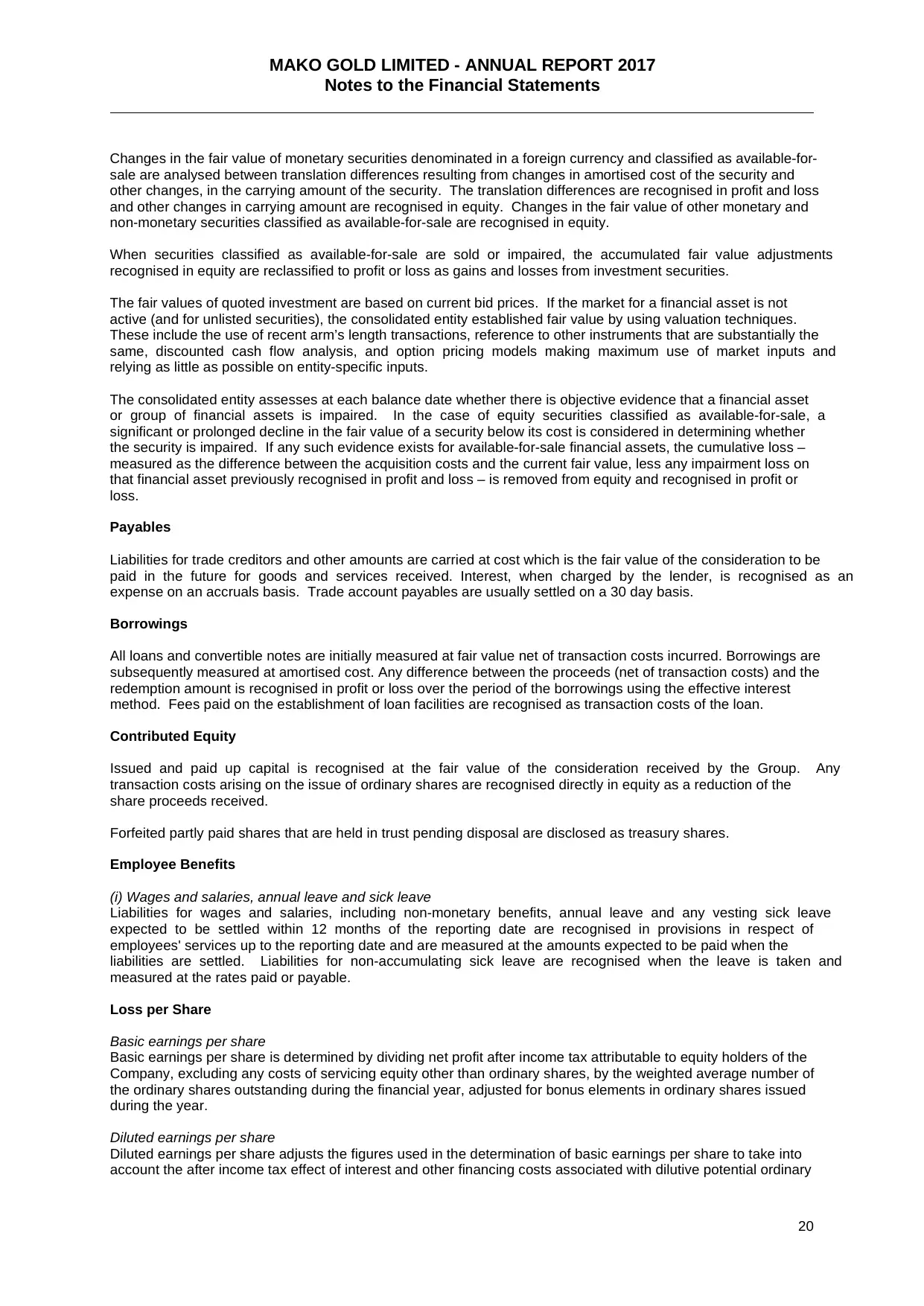
MAKO GOLD LIMITED - ANNUAL REPORT 2017
Notes to the Financial Statements
20
Changes in the fair value of monetary securities denominated in a foreign currency and classified as available-for-
sale are analysed between translation differences resulting from changes in amortised cost of the security and
other changes, in the carrying amount of the security. The translation differences are recognised in profit and loss
and other changes in carrying amount are recognised in equity. Changes in the fair value of other monetary and
non-monetary securities classified as available-for-sale are recognised in equity.
When securities classified as available-for-sale are sold or impaired, the accumulated fair value adjustments
recognised in equity are reclassified to profit or loss as gains and losses from investment securities.
The fair values of quoted investment are based on current bid prices. If the market for a financial asset is not
active (and for unlisted securities), the consolidated entity established fair value by using valuation techniques.
These include the use of recent arm’s length transactions, reference to other instruments that are substantially the
same, discounted cash flow analysis, and option pricing models making maximum use of market inputs and
relying as little as possible on entity-specific inputs.
The consolidated entity assesses at each balance date whether there is objective evidence that a financial asset
or group of financial assets is impaired. In the case of equity securities classified as available-for-sale, a
significant or prolonged decline in the fair value of a security below its cost is considered in determining whether
the security is impaired. If any such evidence exists for available-for-sale financial assets, the cumulative loss –
measured as the difference between the acquisition costs and the current fair value, less any impairment loss on
that financial asset previously recognised in profit and loss – is removed from equity and recognised in profit or
loss.
Payables
Liabilities for trade creditors and other amounts are carried at cost which is the fair value of the consideration to be
paid in the future for goods and services received. Interest, when charged by the lender, is recognised as an
expense on an accruals basis. Trade account payables are usually settled on a 30 day basis.
Borrowings
All loans and convertible notes are initially measured at fair value net of transaction costs incurred. Borrowings are
subsequently measured at amortised cost. Any difference between the proceeds (net of transaction costs) and the
redemption amount is recognised in profit or loss over the period of the borrowings using the effective interest
method. Fees paid on the establishment of loan facilities are recognised as transaction costs of the loan.
Contributed Equity
Issued and paid up capital is recognised at the fair value of the consideration received by the Group. Any
transaction costs arising on the issue of ordinary shares are recognised directly in equity as a reduction of the
share proceeds received.
Forfeited partly paid shares that are held in trust pending disposal are disclosed as treasury shares.
Employee Benefits
(i) Wages and salaries, annual leave and sick leave
Liabilities for wages and salaries, including non-monetary benefits, annual leave and any vesting sick leave
expected to be settled within 12 months of the reporting date are recognised in provisions in respect of
employees' services up to the reporting date and are measured at the amounts expected to be paid when the
liabilities are settled. Liabilities for non-accumulating sick leave are recognised when the leave is taken and
measured at the rates paid or payable.
Loss per Share
Basic earnings per share
Basic earnings per share is determined by dividing net profit after income tax attributable to equity holders of the
Company, excluding any costs of servicing equity other than ordinary shares, by the weighted average number of
the ordinary shares outstanding during the financial year, adjusted for bonus elements in ordinary shares issued
during the year.
Diluted earnings per share
Diluted earnings per share adjusts the figures used in the determination of basic earnings per share to take into
account the after income tax effect of interest and other financing costs associated with dilutive potential ordinary
Notes to the Financial Statements
20
Changes in the fair value of monetary securities denominated in a foreign currency and classified as available-for-
sale are analysed between translation differences resulting from changes in amortised cost of the security and
other changes, in the carrying amount of the security. The translation differences are recognised in profit and loss
and other changes in carrying amount are recognised in equity. Changes in the fair value of other monetary and
non-monetary securities classified as available-for-sale are recognised in equity.
When securities classified as available-for-sale are sold or impaired, the accumulated fair value adjustments
recognised in equity are reclassified to profit or loss as gains and losses from investment securities.
The fair values of quoted investment are based on current bid prices. If the market for a financial asset is not
active (and for unlisted securities), the consolidated entity established fair value by using valuation techniques.
These include the use of recent arm’s length transactions, reference to other instruments that are substantially the
same, discounted cash flow analysis, and option pricing models making maximum use of market inputs and
relying as little as possible on entity-specific inputs.
The consolidated entity assesses at each balance date whether there is objective evidence that a financial asset
or group of financial assets is impaired. In the case of equity securities classified as available-for-sale, a
significant or prolonged decline in the fair value of a security below its cost is considered in determining whether
the security is impaired. If any such evidence exists for available-for-sale financial assets, the cumulative loss –
measured as the difference between the acquisition costs and the current fair value, less any impairment loss on
that financial asset previously recognised in profit and loss – is removed from equity and recognised in profit or
loss.
Payables
Liabilities for trade creditors and other amounts are carried at cost which is the fair value of the consideration to be
paid in the future for goods and services received. Interest, when charged by the lender, is recognised as an
expense on an accruals basis. Trade account payables are usually settled on a 30 day basis.
Borrowings
All loans and convertible notes are initially measured at fair value net of transaction costs incurred. Borrowings are
subsequently measured at amortised cost. Any difference between the proceeds (net of transaction costs) and the
redemption amount is recognised in profit or loss over the period of the borrowings using the effective interest
method. Fees paid on the establishment of loan facilities are recognised as transaction costs of the loan.
Contributed Equity
Issued and paid up capital is recognised at the fair value of the consideration received by the Group. Any
transaction costs arising on the issue of ordinary shares are recognised directly in equity as a reduction of the
share proceeds received.
Forfeited partly paid shares that are held in trust pending disposal are disclosed as treasury shares.
Employee Benefits
(i) Wages and salaries, annual leave and sick leave
Liabilities for wages and salaries, including non-monetary benefits, annual leave and any vesting sick leave
expected to be settled within 12 months of the reporting date are recognised in provisions in respect of
employees' services up to the reporting date and are measured at the amounts expected to be paid when the
liabilities are settled. Liabilities for non-accumulating sick leave are recognised when the leave is taken and
measured at the rates paid or payable.
Loss per Share
Basic earnings per share
Basic earnings per share is determined by dividing net profit after income tax attributable to equity holders of the
Company, excluding any costs of servicing equity other than ordinary shares, by the weighted average number of
the ordinary shares outstanding during the financial year, adjusted for bonus elements in ordinary shares issued
during the year.
Diluted earnings per share
Diluted earnings per share adjusts the figures used in the determination of basic earnings per share to take into
account the after income tax effect of interest and other financing costs associated with dilutive potential ordinary
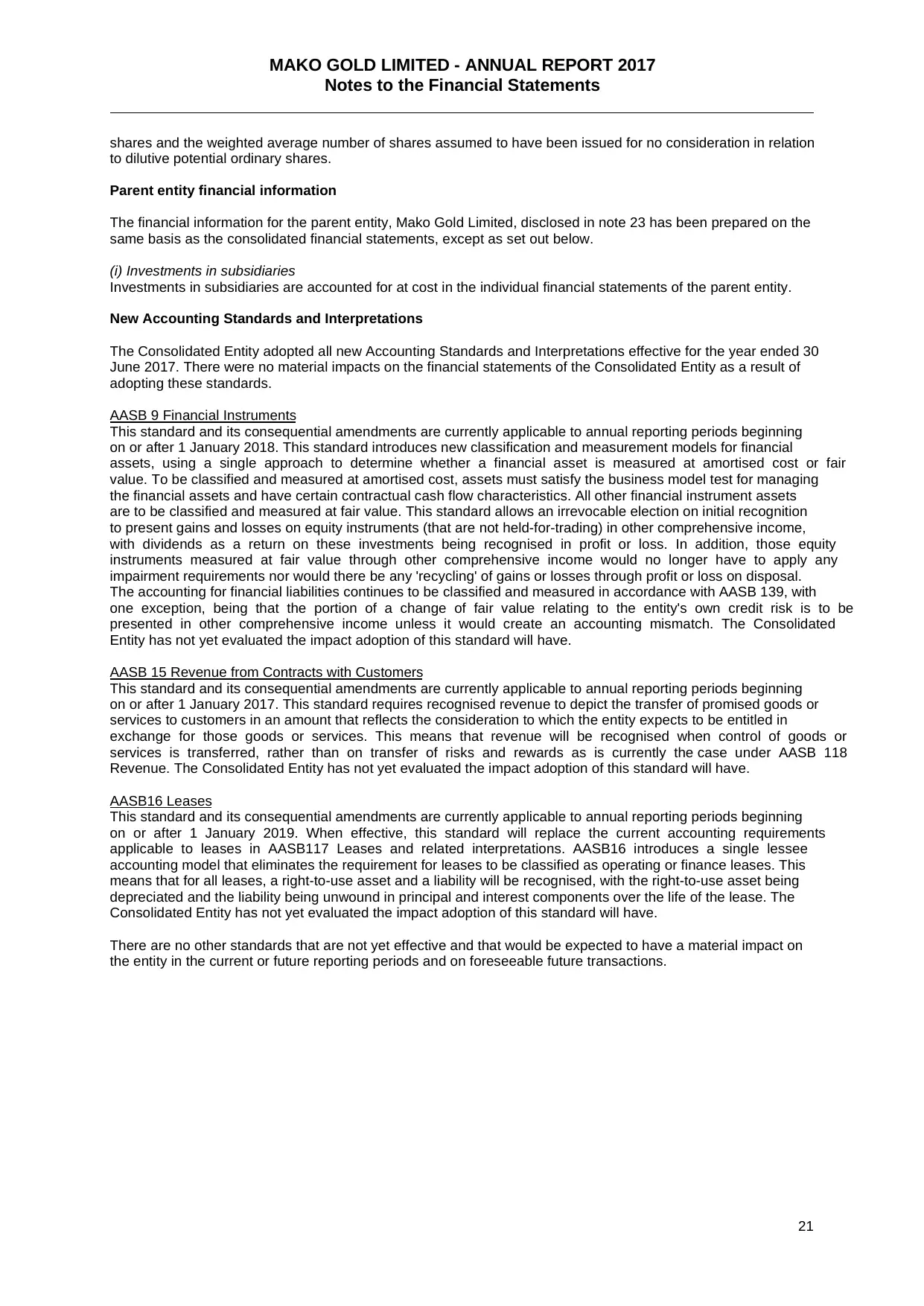
MAKO GOLD LIMITED - ANNUAL REPORT 2017
Notes to the Financial Statements
21
shares and the weighted average number of shares assumed to have been issued for no consideration in relation
to dilutive potential ordinary shares.
Parent entity financial information
The financial information for the parent entity, Mako Gold Limited, disclosed in note 23 has been prepared on the
same basis as the consolidated financial statements, except as set out below.
(i) Investments in subsidiaries
Investments in subsidiaries are accounted for at cost in the individual financial statements of the parent entity.
New Accounting Standards and Interpretations
The Consolidated Entity adopted all new Accounting Standards and Interpretations effective for the year ended 30
June 2017. There were no material impacts on the financial statements of the Consolidated Entity as a result of
adopting these standards.
AASB 9 Financial Instruments
This standard and its consequential amendments are currently applicable to annual reporting periods beginning
on or after 1 January 2018. This standard introduces new classification and measurement models for financial
assets, using a single approach to determine whether a financial asset is measured at amortised cost or fair
value. To be classified and measured at amortised cost, assets must satisfy the business model test for managing
the financial assets and have certain contractual cash flow characteristics. All other financial instrument assets
are to be classified and measured at fair value. This standard allows an irrevocable election on initial recognition
to present gains and losses on equity instruments (that are not held-for-trading) in other comprehensive income,
with dividends as a return on these investments being recognised in profit or loss. In addition, those equity
instruments measured at fair value through other comprehensive income would no longer have to apply any
impairment requirements nor would there be any 'recycling' of gains or losses through profit or loss on disposal.
The accounting for financial liabilities continues to be classified and measured in accordance with AASB 139, with
one exception, being that the portion of a change of fair value relating to the entity's own credit risk is to be
presented in other comprehensive income unless it would create an accounting mismatch. The Consolidated
Entity has not yet evaluated the impact adoption of this standard will have.
AASB 15 Revenue from Contracts with Customers
This standard and its consequential amendments are currently applicable to annual reporting periods beginning
on or after 1 January 2017. This standard requires recognised revenue to depict the transfer of promised goods or
services to customers in an amount that reflects the consideration to which the entity expects to be entitled in
exchange for those goods or services. This means that revenue will be recognised when control of goods or
services is transferred, rather than on transfer of risks and rewards as is currently the case under AASB 118
Revenue. The Consolidated Entity has not yet evaluated the impact adoption of this standard will have.
AASB16 Leases
This standard and its consequential amendments are currently applicable to annual reporting periods beginning
on or after 1 January 2019. When effective, this standard will replace the current accounting requirements
applicable to leases in AASB117 Leases and related interpretations. AASB16 introduces a single lessee
accounting model that eliminates the requirement for leases to be classified as operating or finance leases. This
means that for all leases, a right-to-use asset and a liability will be recognised, with the right-to-use asset being
depreciated and the liability being unwound in principal and interest components over the life of the lease. The
Consolidated Entity has not yet evaluated the impact adoption of this standard will have.
There are no other standards that are not yet effective and that would be expected to have a material impact on
the entity in the current or future reporting periods and on foreseeable future transactions.
Notes to the Financial Statements
21
shares and the weighted average number of shares assumed to have been issued for no consideration in relation
to dilutive potential ordinary shares.
Parent entity financial information
The financial information for the parent entity, Mako Gold Limited, disclosed in note 23 has been prepared on the
same basis as the consolidated financial statements, except as set out below.
(i) Investments in subsidiaries
Investments in subsidiaries are accounted for at cost in the individual financial statements of the parent entity.
New Accounting Standards and Interpretations
The Consolidated Entity adopted all new Accounting Standards and Interpretations effective for the year ended 30
June 2017. There were no material impacts on the financial statements of the Consolidated Entity as a result of
adopting these standards.
AASB 9 Financial Instruments
This standard and its consequential amendments are currently applicable to annual reporting periods beginning
on or after 1 January 2018. This standard introduces new classification and measurement models for financial
assets, using a single approach to determine whether a financial asset is measured at amortised cost or fair
value. To be classified and measured at amortised cost, assets must satisfy the business model test for managing
the financial assets and have certain contractual cash flow characteristics. All other financial instrument assets
are to be classified and measured at fair value. This standard allows an irrevocable election on initial recognition
to present gains and losses on equity instruments (that are not held-for-trading) in other comprehensive income,
with dividends as a return on these investments being recognised in profit or loss. In addition, those equity
instruments measured at fair value through other comprehensive income would no longer have to apply any
impairment requirements nor would there be any 'recycling' of gains or losses through profit or loss on disposal.
The accounting for financial liabilities continues to be classified and measured in accordance with AASB 139, with
one exception, being that the portion of a change of fair value relating to the entity's own credit risk is to be
presented in other comprehensive income unless it would create an accounting mismatch. The Consolidated
Entity has not yet evaluated the impact adoption of this standard will have.
AASB 15 Revenue from Contracts with Customers
This standard and its consequential amendments are currently applicable to annual reporting periods beginning
on or after 1 January 2017. This standard requires recognised revenue to depict the transfer of promised goods or
services to customers in an amount that reflects the consideration to which the entity expects to be entitled in
exchange for those goods or services. This means that revenue will be recognised when control of goods or
services is transferred, rather than on transfer of risks and rewards as is currently the case under AASB 118
Revenue. The Consolidated Entity has not yet evaluated the impact adoption of this standard will have.
AASB16 Leases
This standard and its consequential amendments are currently applicable to annual reporting periods beginning
on or after 1 January 2019. When effective, this standard will replace the current accounting requirements
applicable to leases in AASB117 Leases and related interpretations. AASB16 introduces a single lessee
accounting model that eliminates the requirement for leases to be classified as operating or finance leases. This
means that for all leases, a right-to-use asset and a liability will be recognised, with the right-to-use asset being
depreciated and the liability being unwound in principal and interest components over the life of the lease. The
Consolidated Entity has not yet evaluated the impact adoption of this standard will have.
There are no other standards that are not yet effective and that would be expected to have a material impact on
the entity in the current or future reporting periods and on foreseeable future transactions.
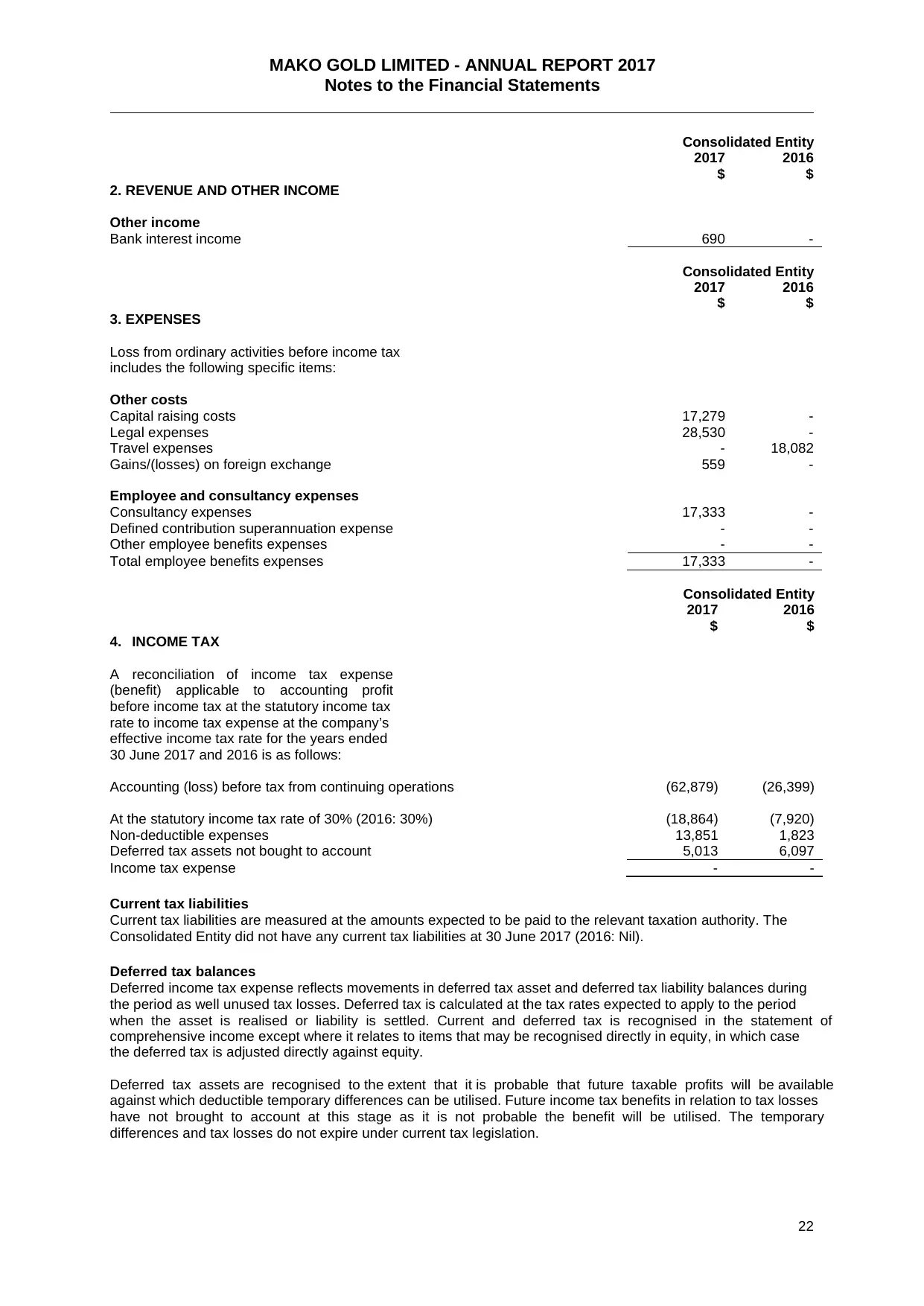
MAKO GOLD LIMITED - ANNUAL REPORT 2017
Notes to the Financial Statements
22
Consolidated Entity
2017 2016
$ $
2. REVENUE AND OTHER INCOME
Other income
Bank interest income 690 -
Consolidated Entity
2017 2016
$ $
3. EXPENSES
Loss from ordinary activities before income tax
includes the following specific items:
Other costs
Capital raising costs 17,279 -
Legal expenses 28,530 -
Travel expenses - 18,082
Gains/(losses) on foreign exchange 559 -
Employee and consultancy expenses
Consultancy expenses 17,333 -
Defined contribution superannuation expense - -
Other employee benefits expenses - -
Total employee benefits expenses 17,333 -
Consolidated Entity
2017 2016
$ $
4. INCOME TAX
A reconciliation of income tax expense
(benefit) applicable to accounting profit
before income tax at the statutory income tax
rate to income tax expense at the company’s
effective income tax rate for the years ended
30 June 2017 and 2016 is as follows:
Accounting (loss) before tax from continuing operations (62,879) (26,399)
At the statutory income tax rate of 30% (2016: 30%) (18,864) (7,920)
Non-deductible expenses 13,851 1,823
Deferred tax assets not bought to account 5,013 6,097
Income tax expense - -
Current tax liabilities
Current tax liabilities are measured at the amounts expected to be paid to the relevant taxation authority. The
Consolidated Entity did not have any current tax liabilities at 30 June 2017 (2016: Nil).
Deferred tax balances
Deferred income tax expense reflects movements in deferred tax asset and deferred tax liability balances during
the period as well unused tax losses. Deferred tax is calculated at the tax rates expected to apply to the period
when the asset is realised or liability is settled. Current and deferred tax is recognised in the statement of
comprehensive income except where it relates to items that may be recognised directly in equity, in which case
the deferred tax is adjusted directly against equity.
Deferred tax assets are recognised to the extent that it is probable that future taxable profits will be available
against which deductible temporary differences can be utilised. Future income tax benefits in relation to tax losses
have not brought to account at this stage as it is not probable the benefit will be utilised. The temporary
differences and tax losses do not expire under current tax legislation.
Notes to the Financial Statements
22
Consolidated Entity
2017 2016
$ $
2. REVENUE AND OTHER INCOME
Other income
Bank interest income 690 -
Consolidated Entity
2017 2016
$ $
3. EXPENSES
Loss from ordinary activities before income tax
includes the following specific items:
Other costs
Capital raising costs 17,279 -
Legal expenses 28,530 -
Travel expenses - 18,082
Gains/(losses) on foreign exchange 559 -
Employee and consultancy expenses
Consultancy expenses 17,333 -
Defined contribution superannuation expense - -
Other employee benefits expenses - -
Total employee benefits expenses 17,333 -
Consolidated Entity
2017 2016
$ $
4. INCOME TAX
A reconciliation of income tax expense
(benefit) applicable to accounting profit
before income tax at the statutory income tax
rate to income tax expense at the company’s
effective income tax rate for the years ended
30 June 2017 and 2016 is as follows:
Accounting (loss) before tax from continuing operations (62,879) (26,399)
At the statutory income tax rate of 30% (2016: 30%) (18,864) (7,920)
Non-deductible expenses 13,851 1,823
Deferred tax assets not bought to account 5,013 6,097
Income tax expense - -
Current tax liabilities
Current tax liabilities are measured at the amounts expected to be paid to the relevant taxation authority. The
Consolidated Entity did not have any current tax liabilities at 30 June 2017 (2016: Nil).
Deferred tax balances
Deferred income tax expense reflects movements in deferred tax asset and deferred tax liability balances during
the period as well unused tax losses. Deferred tax is calculated at the tax rates expected to apply to the period
when the asset is realised or liability is settled. Current and deferred tax is recognised in the statement of
comprehensive income except where it relates to items that may be recognised directly in equity, in which case
the deferred tax is adjusted directly against equity.
Deferred tax assets are recognised to the extent that it is probable that future taxable profits will be available
against which deductible temporary differences can be utilised. Future income tax benefits in relation to tax losses
have not brought to account at this stage as it is not probable the benefit will be utilised. The temporary
differences and tax losses do not expire under current tax legislation.
Secure Best Marks with AI Grader
Need help grading? Try our AI Grader for instant feedback on your assignments.
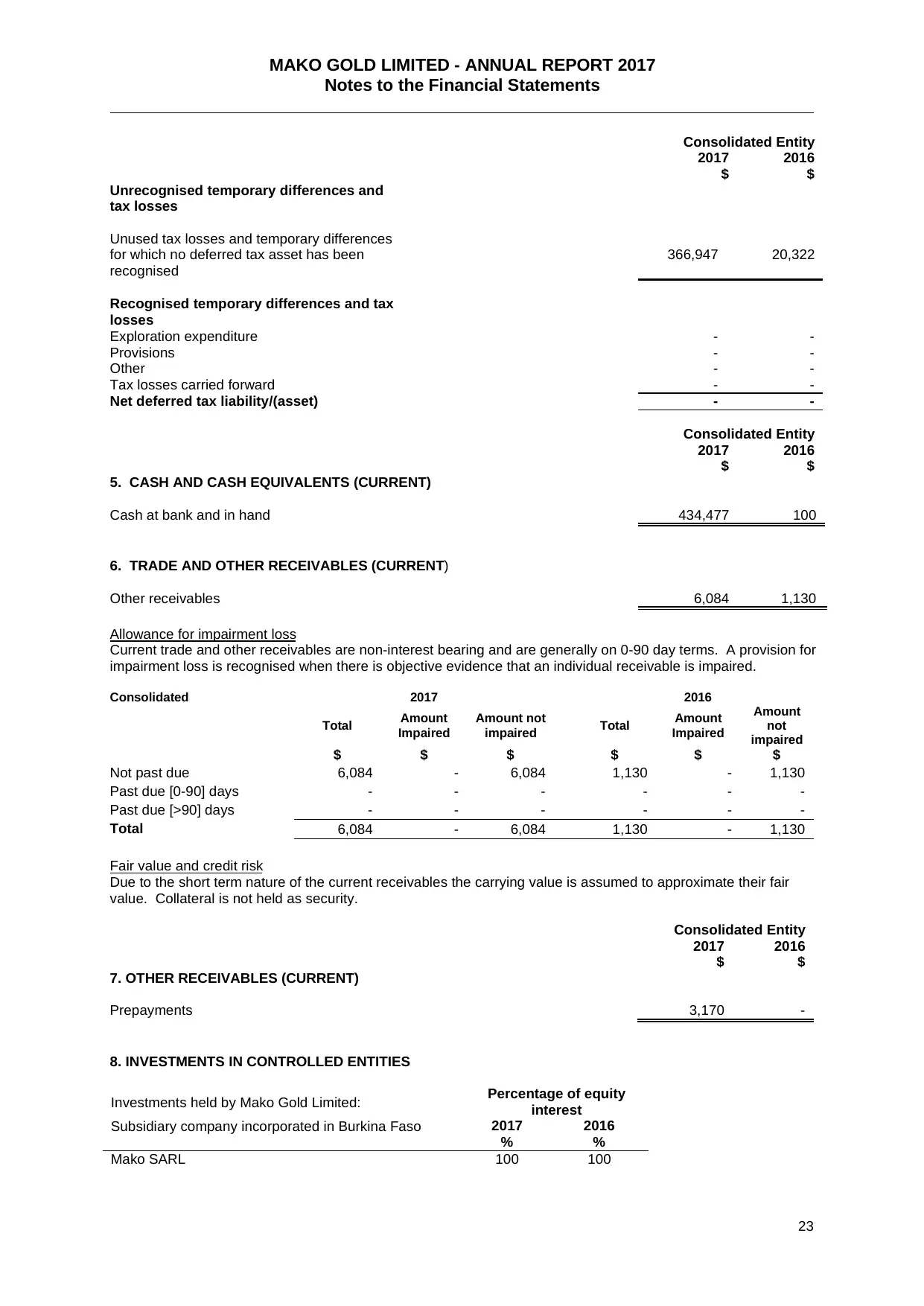
MAKO GOLD LIMITED - ANNUAL REPORT 2017
Notes to the Financial Statements
23
Consolidated Entity
2017 2016
$ $
Unrecognised temporary differences and
tax losses
Unused tax losses and temporary differences
for which no deferred tax asset has been
recognised
366,947 20,322
Recognised temporary differences and tax
losses
Exploration expenditure - -
Provisions - -
Other - -
Tax losses carried forward - -
Net deferred tax liability/(asset) - -
Consolidated Entity
2017 2016
$ $
5. CASH AND CASH EQUIVALENTS (CURRENT)
Cash at bank and in hand 434,477 100
6. TRADE AND OTHER RECEIVABLES (CURRENT)
Other receivables 6,084 1,130
Allowance for impairment loss
Current trade and other receivables are non-interest bearing and are generally on 0-90 day terms. A provision for
impairment loss is recognised when there is objective evidence that an individual receivable is impaired.
Consolidated 2017 2016
Total Amount
Impaired
Amount not
impaired Total Amount
Impaired
Amount
not
impaired
$ $ $ $ $ $
Not past due 6,084 - 6,084 1,130 - 1,130
Past due [0-90] days - - - - - -
Past due [>90] days - - - - - -
Total 6,084 - 6,084 1,130 - 1,130
Fair value and credit risk
Due to the short term nature of the current receivables the carrying value is assumed to approximate their fair
value. Collateral is not held as security.
Consolidated Entity
2017 2016
$ $
7. OTHER RECEIVABLES (CURRENT)
Prepayments 3,170 -
8. INVESTMENTS IN CONTROLLED ENTITIES
Investments held by Mako Gold Limited: Percentage of equity
interest
Subsidiary company incorporated in Burkina Faso 2017 2016
% %
Mako SARL 100 100
Notes to the Financial Statements
23
Consolidated Entity
2017 2016
$ $
Unrecognised temporary differences and
tax losses
Unused tax losses and temporary differences
for which no deferred tax asset has been
recognised
366,947 20,322
Recognised temporary differences and tax
losses
Exploration expenditure - -
Provisions - -
Other - -
Tax losses carried forward - -
Net deferred tax liability/(asset) - -
Consolidated Entity
2017 2016
$ $
5. CASH AND CASH EQUIVALENTS (CURRENT)
Cash at bank and in hand 434,477 100
6. TRADE AND OTHER RECEIVABLES (CURRENT)
Other receivables 6,084 1,130
Allowance for impairment loss
Current trade and other receivables are non-interest bearing and are generally on 0-90 day terms. A provision for
impairment loss is recognised when there is objective evidence that an individual receivable is impaired.
Consolidated 2017 2016
Total Amount
Impaired
Amount not
impaired Total Amount
Impaired
Amount
not
impaired
$ $ $ $ $ $
Not past due 6,084 - 6,084 1,130 - 1,130
Past due [0-90] days - - - - - -
Past due [>90] days - - - - - -
Total 6,084 - 6,084 1,130 - 1,130
Fair value and credit risk
Due to the short term nature of the current receivables the carrying value is assumed to approximate their fair
value. Collateral is not held as security.
Consolidated Entity
2017 2016
$ $
7. OTHER RECEIVABLES (CURRENT)
Prepayments 3,170 -
8. INVESTMENTS IN CONTROLLED ENTITIES
Investments held by Mako Gold Limited: Percentage of equity
interest
Subsidiary company incorporated in Burkina Faso 2017 2016
% %
Mako SARL 100 100
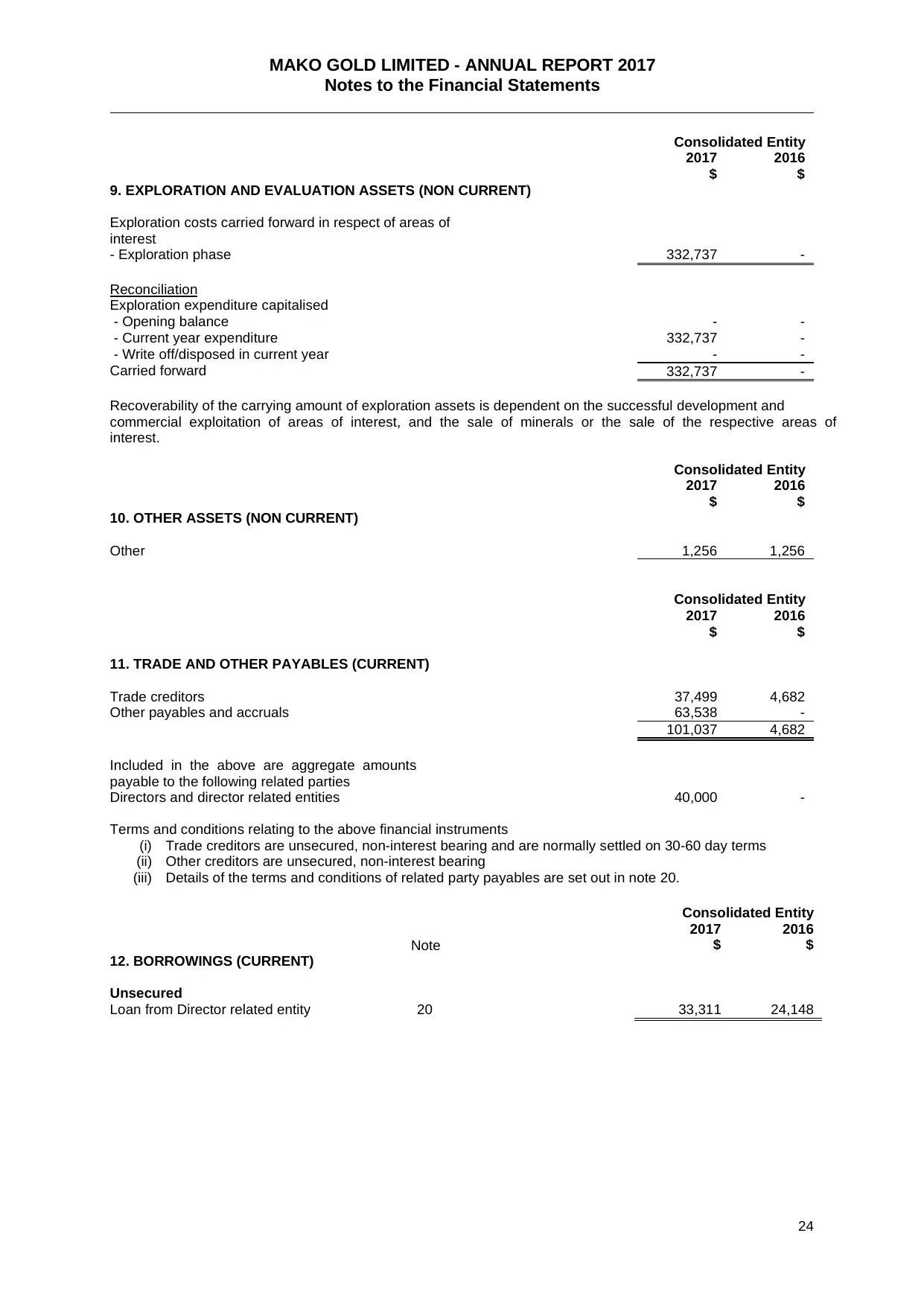
MAKO GOLD LIMITED - ANNUAL REPORT 2017
Notes to the Financial Statements
24
Consolidated Entity
2017 2016
$ $
9. EXPLORATION AND EVALUATION ASSETS (NON CURRENT)
Exploration costs carried forward in respect of areas of
interest
- Exploration phase 332,737 -
Reconciliation
Exploration expenditure capitalised
- Opening balance - -
- Current year expenditure 332,737 -
- Write off/disposed in current year - -
Carried forward 332,737 -
Recoverability of the carrying amount of exploration assets is dependent on the successful development and
commercial exploitation of areas of interest, and the sale of minerals or the sale of the respective areas of
interest.
Consolidated Entity
2017 2016
$ $
10. OTHER ASSETS (NON CURRENT)
Other 1,256 1,256
Consolidated Entity
2017 2016
$ $
11. TRADE AND OTHER PAYABLES (CURRENT)
Trade creditors 37,499 4,682
Other payables and accruals 63,538 -
101,037 4,682
Included in the above are aggregate amounts
payable to the following related parties
Directors and director related entities 40,000 -
Terms and conditions relating to the above financial instruments
(i) Trade creditors are unsecured, non-interest bearing and are normally settled on 30-60 day terms
(ii) Other creditors are unsecured, non-interest bearing
(iii) Details of the terms and conditions of related party payables are set out in note 20.
Consolidated Entity
2017 2016
Note $ $
12. BORROWINGS (CURRENT)
Unsecured
Loan from Director related entity 20 33,311 24,148
Notes to the Financial Statements
24
Consolidated Entity
2017 2016
$ $
9. EXPLORATION AND EVALUATION ASSETS (NON CURRENT)
Exploration costs carried forward in respect of areas of
interest
- Exploration phase 332,737 -
Reconciliation
Exploration expenditure capitalised
- Opening balance - -
- Current year expenditure 332,737 -
- Write off/disposed in current year - -
Carried forward 332,737 -
Recoverability of the carrying amount of exploration assets is dependent on the successful development and
commercial exploitation of areas of interest, and the sale of minerals or the sale of the respective areas of
interest.
Consolidated Entity
2017 2016
$ $
10. OTHER ASSETS (NON CURRENT)
Other 1,256 1,256
Consolidated Entity
2017 2016
$ $
11. TRADE AND OTHER PAYABLES (CURRENT)
Trade creditors 37,499 4,682
Other payables and accruals 63,538 -
101,037 4,682
Included in the above are aggregate amounts
payable to the following related parties
Directors and director related entities 40,000 -
Terms and conditions relating to the above financial instruments
(i) Trade creditors are unsecured, non-interest bearing and are normally settled on 30-60 day terms
(ii) Other creditors are unsecured, non-interest bearing
(iii) Details of the terms and conditions of related party payables are set out in note 20.
Consolidated Entity
2017 2016
Note $ $
12. BORROWINGS (CURRENT)
Unsecured
Loan from Director related entity 20 33,311 24,148
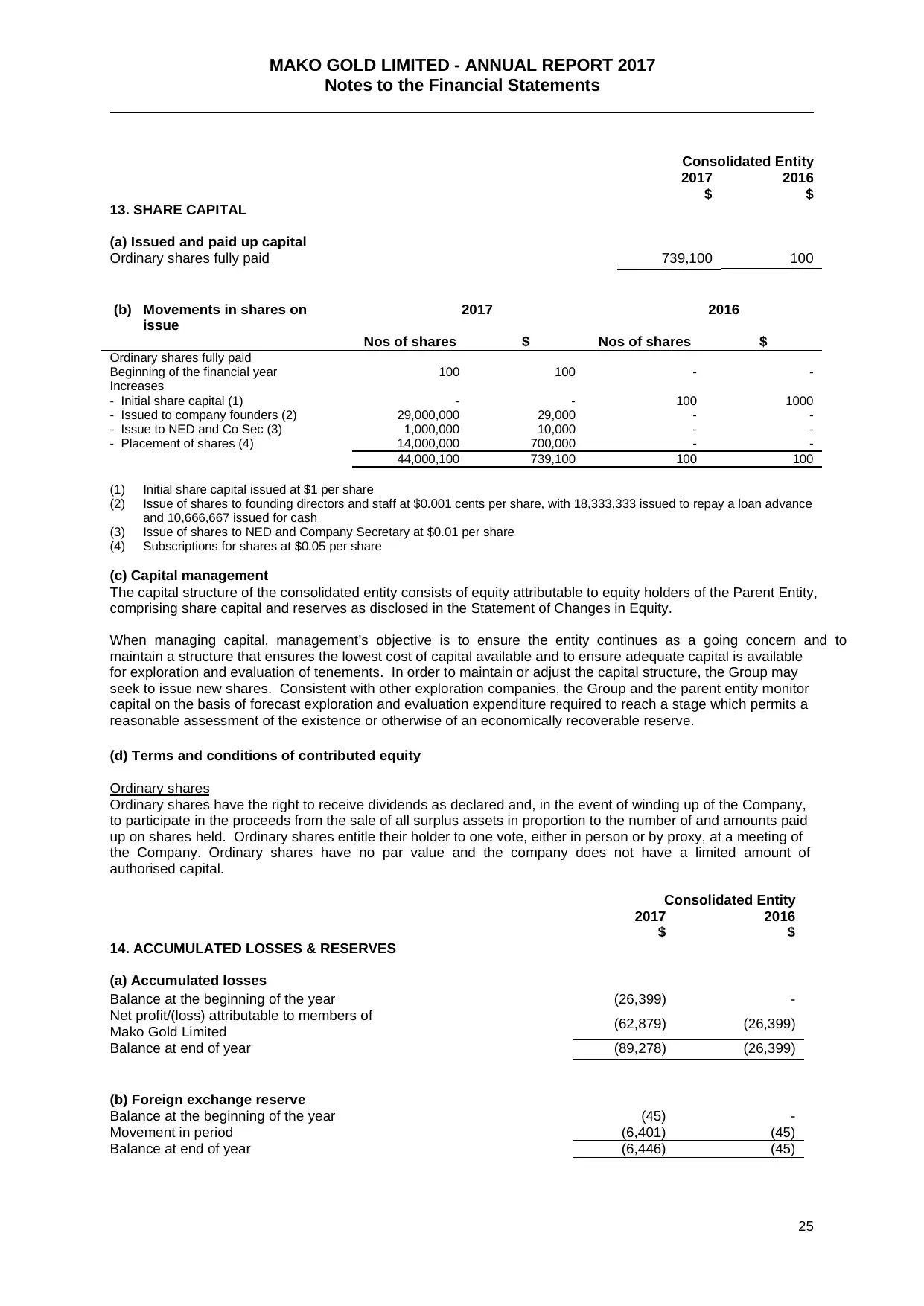
MAKO GOLD LIMITED - ANNUAL REPORT 2017
Notes to the Financial Statements
25
Consolidated Entity
2017 2016
$ $
13. SHARE CAPITAL
(a) Issued and paid up capital
Ordinary shares fully paid 739,100 100
(b) Movements in shares on
issue
2017 2016
Nos of shares $ Nos of shares $
Ordinary shares fully paid
Beginning of the financial year 100 100 - -
Increases
- Initial share capital (1) - - 100 1000
- Issued to company founders (2) 29,000,000 29,000 - -
- Issue to NED and Co Sec (3) 1,000,000 10,000 - -
- Placement of shares (4) 14,000,000 700,000 - -
44,000,100 739,100 100 100
(1) Initial share capital issued at $1 per share
(2) Issue of shares to founding directors and staff at $0.001 cents per share, with 18,333,333 issued to repay a loan advance
and 10,666,667 issued for cash
(3) Issue of shares to NED and Company Secretary at $0.01 per share
(4) Subscriptions for shares at $0.05 per share
(c) Capital management
The capital structure of the consolidated entity consists of equity attributable to equity holders of the Parent Entity,
comprising share capital and reserves as disclosed in the Statement of Changes in Equity.
When managing capital, management’s objective is to ensure the entity continues as a going concern and to
maintain a structure that ensures the lowest cost of capital available and to ensure adequate capital is available
for exploration and evaluation of tenements. In order to maintain or adjust the capital structure, the Group may
seek to issue new shares. Consistent with other exploration companies, the Group and the parent entity monitor
capital on the basis of forecast exploration and evaluation expenditure required to reach a stage which permits a
reasonable assessment of the existence or otherwise of an economically recoverable reserve.
(d) Terms and conditions of contributed equity
Ordinary shares
Ordinary shares have the right to receive dividends as declared and, in the event of winding up of the Company,
to participate in the proceeds from the sale of all surplus assets in proportion to the number of and amounts paid
up on shares held. Ordinary shares entitle their holder to one vote, either in person or by proxy, at a meeting of
the Company. Ordinary shares have no par value and the company does not have a limited amount of
authorised capital.
Consolidated Entity
2017 2016
$ $
14. ACCUMULATED LOSSES & RESERVES
(a) Accumulated losses
Balance at the beginning of the year (26,399) -
Net profit/(loss) attributable to members of
Mako Gold Limited (62,879) (26,399)
Balance at end of year (89,278) (26,399)
(b) Foreign exchange reserve
Balance at the beginning of the year (45) -
Movement in period (6,401) (45)
Balance at end of year (6,446) (45)
Notes to the Financial Statements
25
Consolidated Entity
2017 2016
$ $
13. SHARE CAPITAL
(a) Issued and paid up capital
Ordinary shares fully paid 739,100 100
(b) Movements in shares on
issue
2017 2016
Nos of shares $ Nos of shares $
Ordinary shares fully paid
Beginning of the financial year 100 100 - -
Increases
- Initial share capital (1) - - 100 1000
- Issued to company founders (2) 29,000,000 29,000 - -
- Issue to NED and Co Sec (3) 1,000,000 10,000 - -
- Placement of shares (4) 14,000,000 700,000 - -
44,000,100 739,100 100 100
(1) Initial share capital issued at $1 per share
(2) Issue of shares to founding directors and staff at $0.001 cents per share, with 18,333,333 issued to repay a loan advance
and 10,666,667 issued for cash
(3) Issue of shares to NED and Company Secretary at $0.01 per share
(4) Subscriptions for shares at $0.05 per share
(c) Capital management
The capital structure of the consolidated entity consists of equity attributable to equity holders of the Parent Entity,
comprising share capital and reserves as disclosed in the Statement of Changes in Equity.
When managing capital, management’s objective is to ensure the entity continues as a going concern and to
maintain a structure that ensures the lowest cost of capital available and to ensure adequate capital is available
for exploration and evaluation of tenements. In order to maintain or adjust the capital structure, the Group may
seek to issue new shares. Consistent with other exploration companies, the Group and the parent entity monitor
capital on the basis of forecast exploration and evaluation expenditure required to reach a stage which permits a
reasonable assessment of the existence or otherwise of an economically recoverable reserve.
(d) Terms and conditions of contributed equity
Ordinary shares
Ordinary shares have the right to receive dividends as declared and, in the event of winding up of the Company,
to participate in the proceeds from the sale of all surplus assets in proportion to the number of and amounts paid
up on shares held. Ordinary shares entitle their holder to one vote, either in person or by proxy, at a meeting of
the Company. Ordinary shares have no par value and the company does not have a limited amount of
authorised capital.
Consolidated Entity
2017 2016
$ $
14. ACCUMULATED LOSSES & RESERVES
(a) Accumulated losses
Balance at the beginning of the year (26,399) -
Net profit/(loss) attributable to members of
Mako Gold Limited (62,879) (26,399)
Balance at end of year (89,278) (26,399)
(b) Foreign exchange reserve
Balance at the beginning of the year (45) -
Movement in period (6,401) (45)
Balance at end of year (6,446) (45)
Paraphrase This Document
Need a fresh take? Get an instant paraphrase of this document with our AI Paraphraser
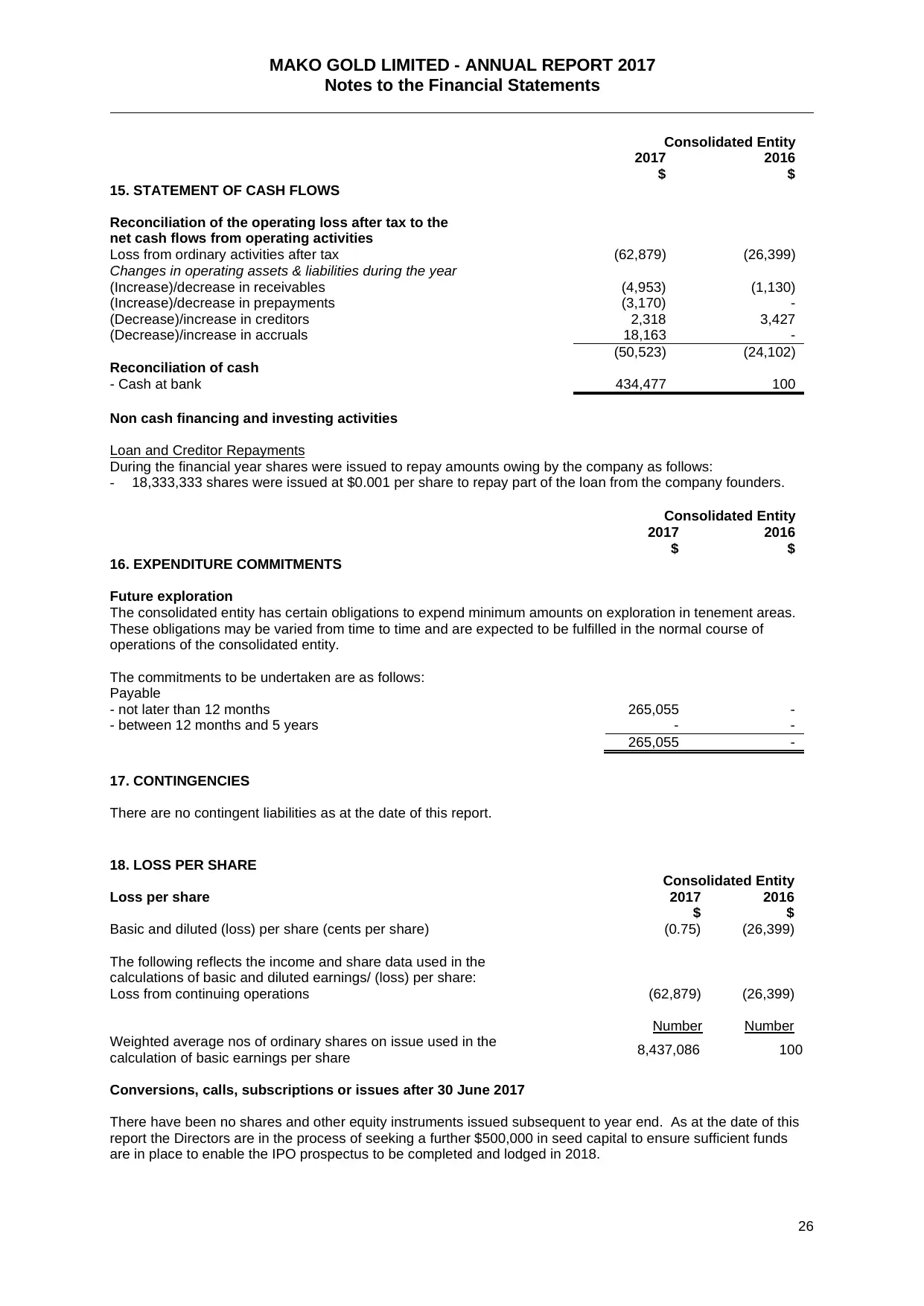
MAKO GOLD LIMITED - ANNUAL REPORT 2017
Notes to the Financial Statements
26
Consolidated Entity
2017 2016
$ $
15. STATEMENT OF CASH FLOWS
Reconciliation of the operating loss after tax to the
net cash flows from operating activities
Loss from ordinary activities after tax (62,879) (26,399)
Changes in operating assets & liabilities during the year
(Increase)/decrease in receivables (4,953) (1,130)
(Increase)/decrease in prepayments (3,170) -
(Decrease)/increase in creditors 2,318 3,427
(Decrease)/increase in accruals 18,163 -
(50,523) (24,102)
Reconciliation of cash
- Cash at bank 434,477 100
Non cash financing and investing activities
Loan and Creditor Repayments
During the financial year shares were issued to repay amounts owing by the company as follows:
- 18,333,333 shares were issued at $0.001 per share to repay part of the loan from the company founders.
Consolidated Entity
2017 2016
$ $
16. EXPENDITURE COMMITMENTS
Future exploration
The consolidated entity has certain obligations to expend minimum amounts on exploration in tenement areas.
These obligations may be varied from time to time and are expected to be fulfilled in the normal course of
operations of the consolidated entity.
The commitments to be undertaken are as follows:
Payable
- not later than 12 months 265,055 -
- between 12 months and 5 years - -
265,055 -
17. CONTINGENCIES
There are no contingent liabilities as at the date of this report.
18. LOSS PER SHARE
Consolidated Entity
Loss per share 2017 2016
Basic and diluted (loss) per share (cents per share)
$ $
(0.75) (26,399)
The following reflects the income and share data used in the
calculations of basic and diluted earnings/ (loss) per share:
Loss from continuing operations (62,879) (26,399)
Number Number
Weighted average nos of ordinary shares on issue used in the
calculation of basic earnings per share 8,437,086 100
Conversions, calls, subscriptions or issues after 30 June 2017
There have been no shares and other equity instruments issued subsequent to year end. As at the date of this
report the Directors are in the process of seeking a further $500,000 in seed capital to ensure sufficient funds
are in place to enable the IPO prospectus to be completed and lodged in 2018.
Notes to the Financial Statements
26
Consolidated Entity
2017 2016
$ $
15. STATEMENT OF CASH FLOWS
Reconciliation of the operating loss after tax to the
net cash flows from operating activities
Loss from ordinary activities after tax (62,879) (26,399)
Changes in operating assets & liabilities during the year
(Increase)/decrease in receivables (4,953) (1,130)
(Increase)/decrease in prepayments (3,170) -
(Decrease)/increase in creditors 2,318 3,427
(Decrease)/increase in accruals 18,163 -
(50,523) (24,102)
Reconciliation of cash
- Cash at bank 434,477 100
Non cash financing and investing activities
Loan and Creditor Repayments
During the financial year shares were issued to repay amounts owing by the company as follows:
- 18,333,333 shares were issued at $0.001 per share to repay part of the loan from the company founders.
Consolidated Entity
2017 2016
$ $
16. EXPENDITURE COMMITMENTS
Future exploration
The consolidated entity has certain obligations to expend minimum amounts on exploration in tenement areas.
These obligations may be varied from time to time and are expected to be fulfilled in the normal course of
operations of the consolidated entity.
The commitments to be undertaken are as follows:
Payable
- not later than 12 months 265,055 -
- between 12 months and 5 years - -
265,055 -
17. CONTINGENCIES
There are no contingent liabilities as at the date of this report.
18. LOSS PER SHARE
Consolidated Entity
Loss per share 2017 2016
Basic and diluted (loss) per share (cents per share)
$ $
(0.75) (26,399)
The following reflects the income and share data used in the
calculations of basic and diluted earnings/ (loss) per share:
Loss from continuing operations (62,879) (26,399)
Number Number
Weighted average nos of ordinary shares on issue used in the
calculation of basic earnings per share 8,437,086 100
Conversions, calls, subscriptions or issues after 30 June 2017
There have been no shares and other equity instruments issued subsequent to year end. As at the date of this
report the Directors are in the process of seeking a further $500,000 in seed capital to ensure sufficient funds
are in place to enable the IPO prospectus to be completed and lodged in 2018.
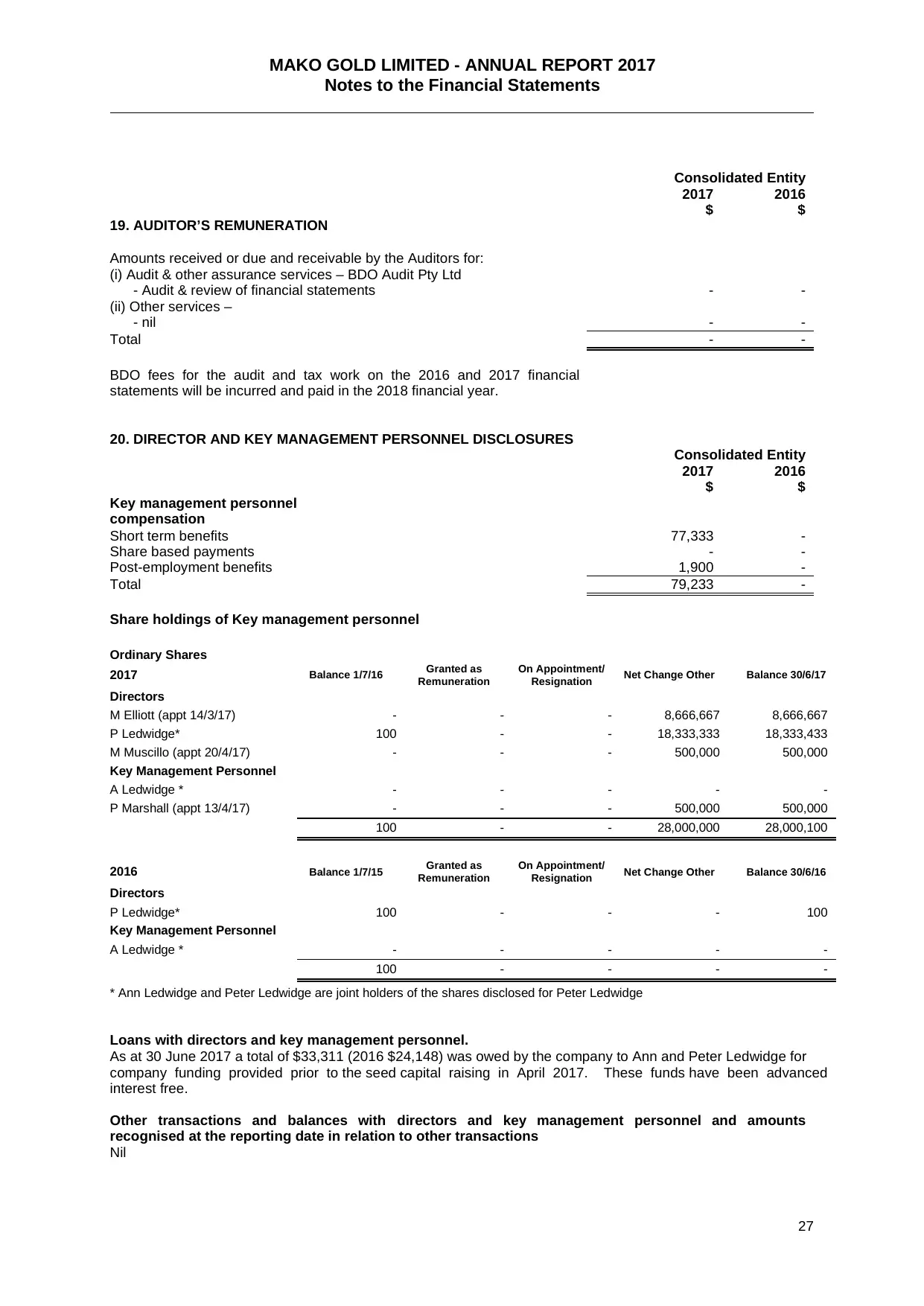
MAKO GOLD LIMITED - ANNUAL REPORT 2017
Notes to the Financial Statements
27
Consolidated Entity
2017 2016
$ $
19. AUDITOR’S REMUNERATION
Amounts received or due and receivable by the Auditors for:
(i) Audit & other assurance services – BDO Audit Pty Ltd
- Audit & review of financial statements - -
(ii) Other services –
- nil - -
Total - -
BDO fees for the audit and tax work on the 2016 and 2017 financial
statements will be incurred and paid in the 2018 financial year.
20. DIRECTOR AND KEY MANAGEMENT PERSONNEL DISCLOSURES
Consolidated Entity
2017 2016
$ $
Key management personnel
compensation
Short term benefits 77,333 -
Share based payments - -
Post-employment benefits 1,900 -
Total 79,233 -
Share holdings of Key management personnel
Ordinary Shares
2017 Balance 1/7/16 Granted as
Remuneration
On Appointment/
Resignation Net Change Other Balance 30/6/17
Directors
M Elliott (appt 14/3/17) - - - 8,666,667 8,666,667
P Ledwidge* 100 - - 18,333,333 18,333,433
M Muscillo (appt 20/4/17) - - - 500,000 500,000
Key Management Personnel
A Ledwidge * - - - - -
P Marshall (appt 13/4/17) - - - 500,000 500,000
100 - - 28,000,000 28,000,100
2016 Balance 1/7/15 Granted as
Remuneration
On Appointment/
Resignation Net Change Other Balance 30/6/16
Directors
P Ledwidge* 100 - - - 100
Key Management Personnel
A Ledwidge * - - - - -
100 - - - -
* Ann Ledwidge and Peter Ledwidge are joint holders of the shares disclosed for Peter Ledwidge
Loans with directors and key management personnel.
As at 30 June 2017 a total of $33,311 (2016 $24,148) was owed by the company to Ann and Peter Ledwidge for
company funding provided prior to the seed capital raising in April 2017. These funds have been advanced
interest free.
Other transactions and balances with directors and key management personnel and amounts
recognised at the reporting date in relation to other transactions
Nil
Notes to the Financial Statements
27
Consolidated Entity
2017 2016
$ $
19. AUDITOR’S REMUNERATION
Amounts received or due and receivable by the Auditors for:
(i) Audit & other assurance services – BDO Audit Pty Ltd
- Audit & review of financial statements - -
(ii) Other services –
- nil - -
Total - -
BDO fees for the audit and tax work on the 2016 and 2017 financial
statements will be incurred and paid in the 2018 financial year.
20. DIRECTOR AND KEY MANAGEMENT PERSONNEL DISCLOSURES
Consolidated Entity
2017 2016
$ $
Key management personnel
compensation
Short term benefits 77,333 -
Share based payments - -
Post-employment benefits 1,900 -
Total 79,233 -
Share holdings of Key management personnel
Ordinary Shares
2017 Balance 1/7/16 Granted as
Remuneration
On Appointment/
Resignation Net Change Other Balance 30/6/17
Directors
M Elliott (appt 14/3/17) - - - 8,666,667 8,666,667
P Ledwidge* 100 - - 18,333,333 18,333,433
M Muscillo (appt 20/4/17) - - - 500,000 500,000
Key Management Personnel
A Ledwidge * - - - - -
P Marshall (appt 13/4/17) - - - 500,000 500,000
100 - - 28,000,000 28,000,100
2016 Balance 1/7/15 Granted as
Remuneration
On Appointment/
Resignation Net Change Other Balance 30/6/16
Directors
P Ledwidge* 100 - - - 100
Key Management Personnel
A Ledwidge * - - - - -
100 - - - -
* Ann Ledwidge and Peter Ledwidge are joint holders of the shares disclosed for Peter Ledwidge
Loans with directors and key management personnel.
As at 30 June 2017 a total of $33,311 (2016 $24,148) was owed by the company to Ann and Peter Ledwidge for
company funding provided prior to the seed capital raising in April 2017. These funds have been advanced
interest free.
Other transactions and balances with directors and key management personnel and amounts
recognised at the reporting date in relation to other transactions
Nil
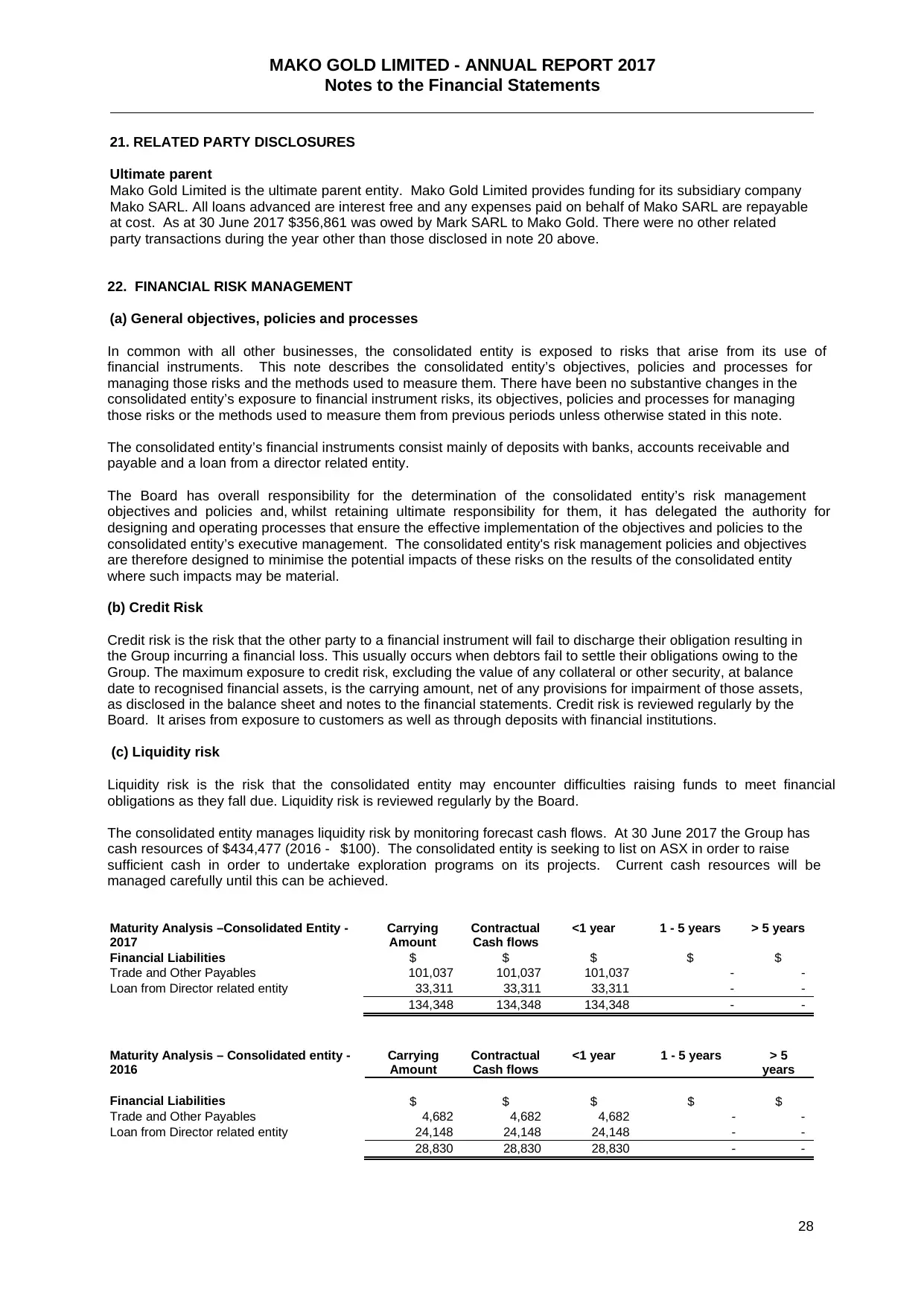
MAKO GOLD LIMITED - ANNUAL REPORT 2017
Notes to the Financial Statements
28
21. RELATED PARTY DISCLOSURES
Ultimate parent
Mako Gold Limited is the ultimate parent entity. Mako Gold Limited provides funding for its subsidiary company
Mako SARL. All loans advanced are interest free and any expenses paid on behalf of Mako SARL are repayable
at cost. As at 30 June 2017 $356,861 was owed by Mark SARL to Mako Gold. There were no other related
party transactions during the year other than those disclosed in note 20 above.
22. FINANCIAL RISK MANAGEMENT
(a) General objectives, policies and processes
In common with all other businesses, the consolidated entity is exposed to risks that arise from its use of
financial instruments. This note describes the consolidated entity’s objectives, policies and processes for
managing those risks and the methods used to measure them. There have been no substantive changes in the
consolidated entity’s exposure to financial instrument risks, its objectives, policies and processes for managing
those risks or the methods used to measure them from previous periods unless otherwise stated in this note.
The consolidated entity’s financial instruments consist mainly of deposits with banks, accounts receivable and
payable and a loan from a director related entity.
The Board has overall responsibility for the determination of the consolidated entity’s risk management
objectives and policies and, whilst retaining ultimate responsibility for them, it has delegated the authority for
designing and operating processes that ensure the effective implementation of the objectives and policies to the
consolidated entity’s executive management. The consolidated entity's risk management policies and objectives
are therefore designed to minimise the potential impacts of these risks on the results of the consolidated entity
where such impacts may be material.
(b) Credit Risk
Credit risk is the risk that the other party to a financial instrument will fail to discharge their obligation resulting in
the Group incurring a financial loss. This usually occurs when debtors fail to settle their obligations owing to the
Group. The maximum exposure to credit risk, excluding the value of any collateral or other security, at balance
date to recognised financial assets, is the carrying amount, net of any provisions for impairment of those assets,
as disclosed in the balance sheet and notes to the financial statements. Credit risk is reviewed regularly by the
Board. It arises from exposure to customers as well as through deposits with financial institutions.
(c) Liquidity risk
Liquidity risk is the risk that the consolidated entity may encounter difficulties raising funds to meet financial
obligations as they fall due. Liquidity risk is reviewed regularly by the Board.
The consolidated entity manages liquidity risk by monitoring forecast cash flows. At 30 June 2017 the Group has
cash resources of $434,477 (2016 - $100). The consolidated entity is seeking to list on ASX in order to raise
sufficient cash in order to undertake exploration programs on its projects. Current cash resources will be
managed carefully until this can be achieved.
Maturity Analysis –Consolidated Entity -
2017
Carrying
Amount
Contractual
Cash flows
<1 year 1 - 5 years > 5 years
Financial Liabilities $ $ $ $ $
Trade and Other Payables 101,037 101,037 101,037 - -
Loan from Director related entity 33,311 33,311 33,311 - -
134,348 134,348 134,348 - -
Maturity Analysis – Consolidated entity -
2016
Carrying
Amount
Contractual
Cash flows
<1 year 1 - 5 years > 5
years
Financial Liabilities $ $ $ $ $
Trade and Other Payables 4,682 4,682 4,682 - -
Loan from Director related entity 24,148 24,148 24,148 - -
28,830 28,830 28,830 - -
Notes to the Financial Statements
28
21. RELATED PARTY DISCLOSURES
Ultimate parent
Mako Gold Limited is the ultimate parent entity. Mako Gold Limited provides funding for its subsidiary company
Mako SARL. All loans advanced are interest free and any expenses paid on behalf of Mako SARL are repayable
at cost. As at 30 June 2017 $356,861 was owed by Mark SARL to Mako Gold. There were no other related
party transactions during the year other than those disclosed in note 20 above.
22. FINANCIAL RISK MANAGEMENT
(a) General objectives, policies and processes
In common with all other businesses, the consolidated entity is exposed to risks that arise from its use of
financial instruments. This note describes the consolidated entity’s objectives, policies and processes for
managing those risks and the methods used to measure them. There have been no substantive changes in the
consolidated entity’s exposure to financial instrument risks, its objectives, policies and processes for managing
those risks or the methods used to measure them from previous periods unless otherwise stated in this note.
The consolidated entity’s financial instruments consist mainly of deposits with banks, accounts receivable and
payable and a loan from a director related entity.
The Board has overall responsibility for the determination of the consolidated entity’s risk management
objectives and policies and, whilst retaining ultimate responsibility for them, it has delegated the authority for
designing and operating processes that ensure the effective implementation of the objectives and policies to the
consolidated entity’s executive management. The consolidated entity's risk management policies and objectives
are therefore designed to minimise the potential impacts of these risks on the results of the consolidated entity
where such impacts may be material.
(b) Credit Risk
Credit risk is the risk that the other party to a financial instrument will fail to discharge their obligation resulting in
the Group incurring a financial loss. This usually occurs when debtors fail to settle their obligations owing to the
Group. The maximum exposure to credit risk, excluding the value of any collateral or other security, at balance
date to recognised financial assets, is the carrying amount, net of any provisions for impairment of those assets,
as disclosed in the balance sheet and notes to the financial statements. Credit risk is reviewed regularly by the
Board. It arises from exposure to customers as well as through deposits with financial institutions.
(c) Liquidity risk
Liquidity risk is the risk that the consolidated entity may encounter difficulties raising funds to meet financial
obligations as they fall due. Liquidity risk is reviewed regularly by the Board.
The consolidated entity manages liquidity risk by monitoring forecast cash flows. At 30 June 2017 the Group has
cash resources of $434,477 (2016 - $100). The consolidated entity is seeking to list on ASX in order to raise
sufficient cash in order to undertake exploration programs on its projects. Current cash resources will be
managed carefully until this can be achieved.
Maturity Analysis –Consolidated Entity -
2017
Carrying
Amount
Contractual
Cash flows
<1 year 1 - 5 years > 5 years
Financial Liabilities $ $ $ $ $
Trade and Other Payables 101,037 101,037 101,037 - -
Loan from Director related entity 33,311 33,311 33,311 - -
134,348 134,348 134,348 - -
Maturity Analysis – Consolidated entity -
2016
Carrying
Amount
Contractual
Cash flows
<1 year 1 - 5 years > 5
years
Financial Liabilities $ $ $ $ $
Trade and Other Payables 4,682 4,682 4,682 - -
Loan from Director related entity 24,148 24,148 24,148 - -
28,830 28,830 28,830 - -
Secure Best Marks with AI Grader
Need help grading? Try our AI Grader for instant feedback on your assignments.
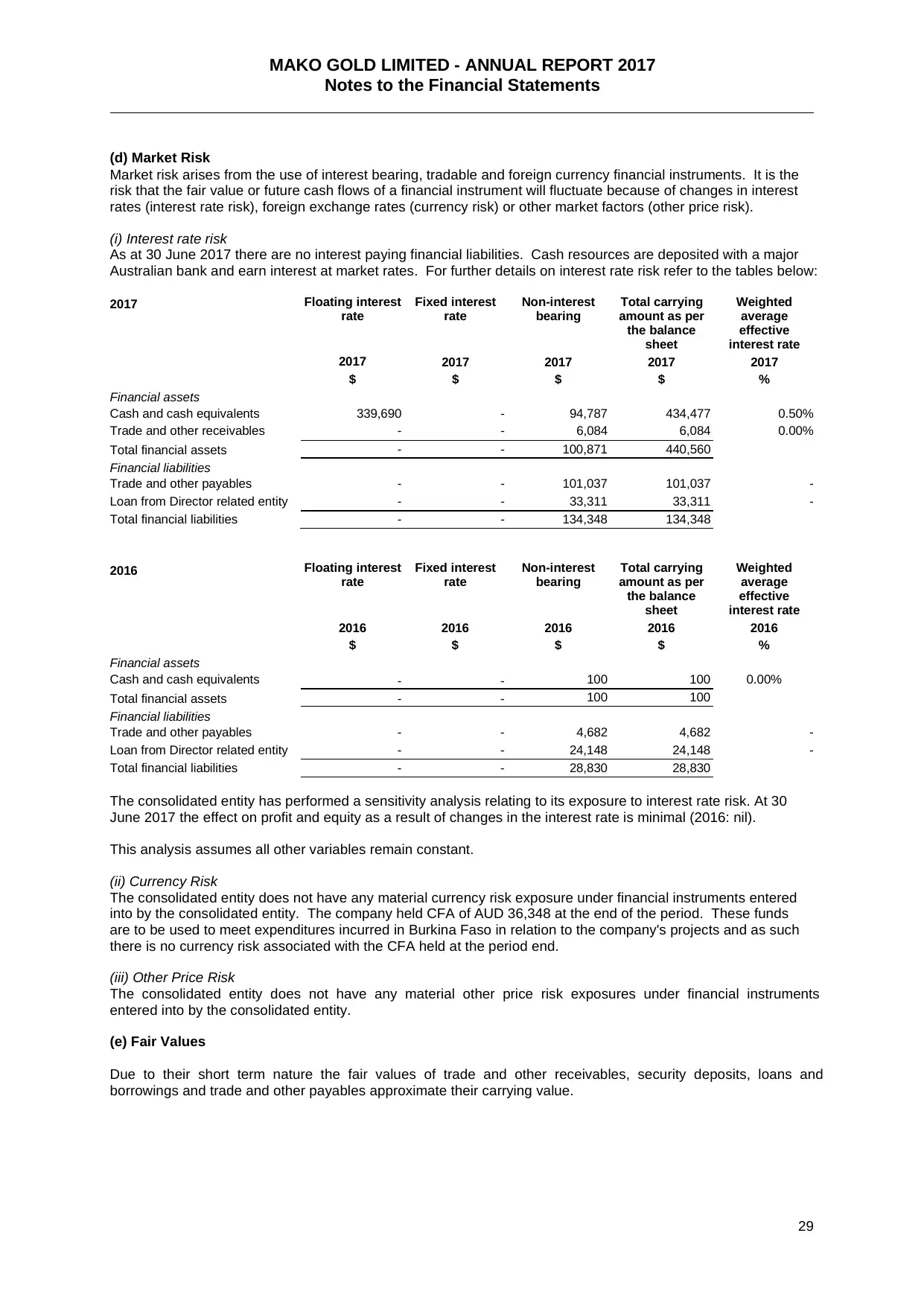
MAKO GOLD LIMITED - ANNUAL REPORT 2017
Notes to the Financial Statements
29
(d) Market Risk
Market risk arises from the use of interest bearing, tradable and foreign currency financial instruments. It is the
risk that the fair value or future cash flows of a financial instrument will fluctuate because of changes in interest
rates (interest rate risk), foreign exchange rates (currency risk) or other market factors (other price risk).
(i) Interest rate risk
As at 30 June 2017 there are no interest paying financial liabilities. Cash resources are deposited with a major
Australian bank and earn interest at market rates. For further details on interest rate risk refer to the tables below:
2017 Floating interest
rate
Fixed interest
rate
Non-interest
bearing
Total carrying
amount as per
the balance
sheet
Weighted
average
effective
interest rate
2017 2017 2017 2017 2017
$ $ $ $ %
Financial assets
Cash and cash equivalents 339,690 - 94,787 434,477 0.50%
Trade and other receivables - - 6,084 6,084 0.00%
Total financial assets - - 100,871 440,560
Financial liabilities
Trade and other payables - - 101,037 101,037 -
Loan from Director related entity - - 33,311 33,311 -
Total financial liabilities - - 134,348 134,348
2016 Floating interest
rate
Fixed interest
rate
Non-interest
bearing
Total carrying
amount as per
the balance
sheet
Weighted
average
effective
interest rate
2016 2016 2016 2016 2016
$ $ $ $ %
Financial assets
Cash and cash equivalents - - 100 100 0.00%
Total financial assets - - 100 100
Financial liabilities
Trade and other payables - - 4,682 4,682 -
Loan from Director related entity - - 24,148 24,148 -
Total financial liabilities - - 28,830 28,830
The consolidated entity has performed a sensitivity analysis relating to its exposure to interest rate risk. At 30
June 2017 the effect on profit and equity as a result of changes in the interest rate is minimal (2016: nil).
This analysis assumes all other variables remain constant.
(ii) Currency Risk
The consolidated entity does not have any material currency risk exposure under financial instruments entered
into by the consolidated entity. The company held CFA of AUD 36,348 at the end of the period. These funds
are to be used to meet expenditures incurred in Burkina Faso in relation to the company's projects and as such
there is no currency risk associated with the CFA held at the period end.
(iii) Other Price Risk
The consolidated entity does not have any material other price risk exposures under financial instruments
entered into by the consolidated entity.
(e) Fair Values
Due to their short term nature the fair values of trade and other receivables, security deposits, loans and
borrowings and trade and other payables approximate their carrying value.
Notes to the Financial Statements
29
(d) Market Risk
Market risk arises from the use of interest bearing, tradable and foreign currency financial instruments. It is the
risk that the fair value or future cash flows of a financial instrument will fluctuate because of changes in interest
rates (interest rate risk), foreign exchange rates (currency risk) or other market factors (other price risk).
(i) Interest rate risk
As at 30 June 2017 there are no interest paying financial liabilities. Cash resources are deposited with a major
Australian bank and earn interest at market rates. For further details on interest rate risk refer to the tables below:
2017 Floating interest
rate
Fixed interest
rate
Non-interest
bearing
Total carrying
amount as per
the balance
sheet
Weighted
average
effective
interest rate
2017 2017 2017 2017 2017
$ $ $ $ %
Financial assets
Cash and cash equivalents 339,690 - 94,787 434,477 0.50%
Trade and other receivables - - 6,084 6,084 0.00%
Total financial assets - - 100,871 440,560
Financial liabilities
Trade and other payables - - 101,037 101,037 -
Loan from Director related entity - - 33,311 33,311 -
Total financial liabilities - - 134,348 134,348
2016 Floating interest
rate
Fixed interest
rate
Non-interest
bearing
Total carrying
amount as per
the balance
sheet
Weighted
average
effective
interest rate
2016 2016 2016 2016 2016
$ $ $ $ %
Financial assets
Cash and cash equivalents - - 100 100 0.00%
Total financial assets - - 100 100
Financial liabilities
Trade and other payables - - 4,682 4,682 -
Loan from Director related entity - - 24,148 24,148 -
Total financial liabilities - - 28,830 28,830
The consolidated entity has performed a sensitivity analysis relating to its exposure to interest rate risk. At 30
June 2017 the effect on profit and equity as a result of changes in the interest rate is minimal (2016: nil).
This analysis assumes all other variables remain constant.
(ii) Currency Risk
The consolidated entity does not have any material currency risk exposure under financial instruments entered
into by the consolidated entity. The company held CFA of AUD 36,348 at the end of the period. These funds
are to be used to meet expenditures incurred in Burkina Faso in relation to the company's projects and as such
there is no currency risk associated with the CFA held at the period end.
(iii) Other Price Risk
The consolidated entity does not have any material other price risk exposures under financial instruments
entered into by the consolidated entity.
(e) Fair Values
Due to their short term nature the fair values of trade and other receivables, security deposits, loans and
borrowings and trade and other payables approximate their carrying value.
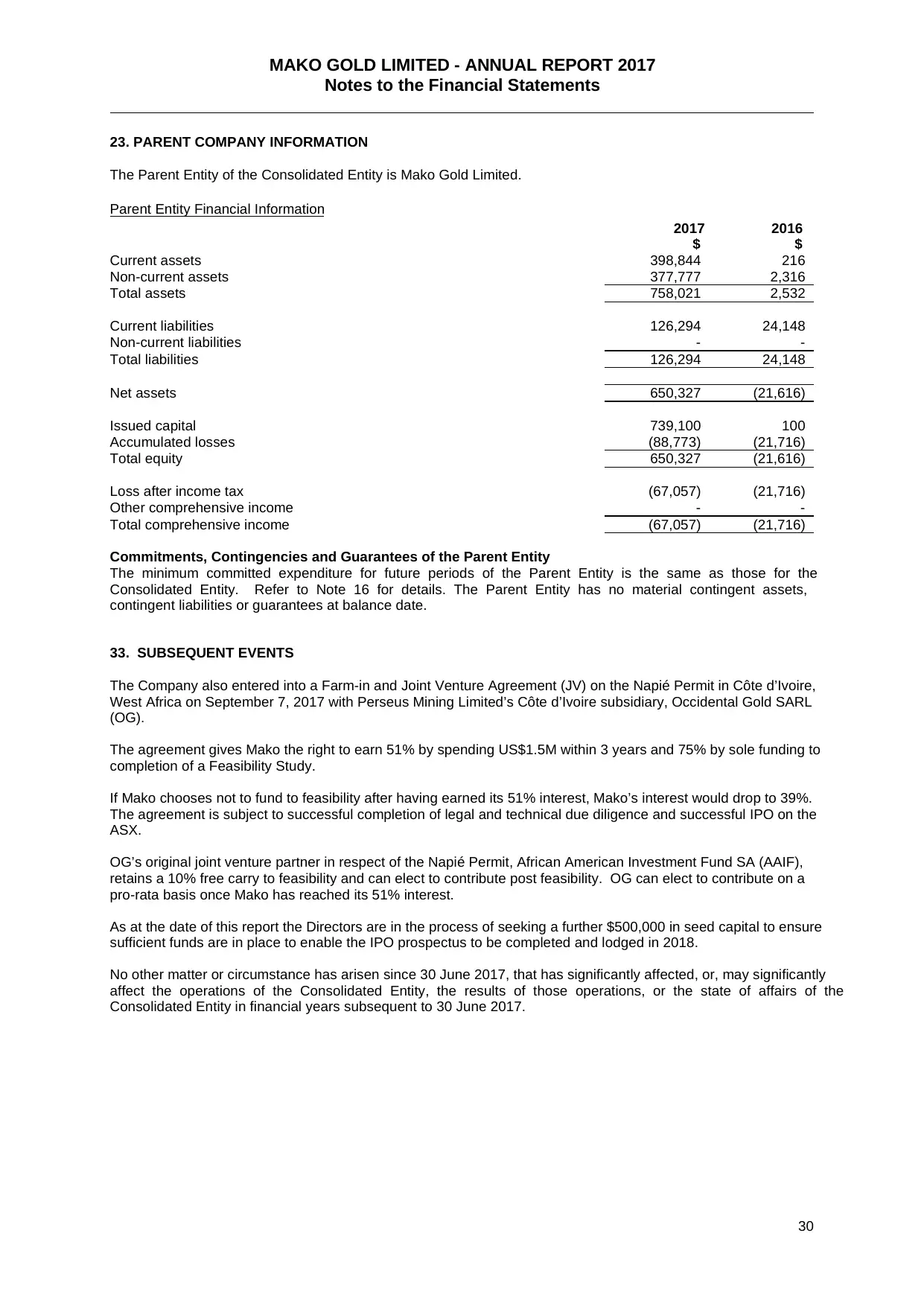
MAKO GOLD LIMITED - ANNUAL REPORT 2017
Notes to the Financial Statements
30
23. PARENT COMPANY INFORMATION
The Parent Entity of the Consolidated Entity is Mako Gold Limited.
Parent Entity Financial Information
2017 2016
$ $
Current assets 398,844 216
Non-current assets 377,777 2,316
Total assets 758,021 2,532
Current liabilities 126,294 24,148
Non-current liabilities - -
Total liabilities 126,294 24,148
Net assets 650,327 (21,616)
Issued capital 739,100 100
Accumulated losses (88,773) (21,716)
Total equity 650,327 (21,616)
Loss after income tax (67,057) (21,716)
Other comprehensive income - -
Total comprehensive income (67,057) (21,716)
Commitments, Contingencies and Guarantees of the Parent Entity
The minimum committed expenditure for future periods of the Parent Entity is the same as those for the
Consolidated Entity. Refer to Note 16 for details. The Parent Entity has no material contingent assets,
contingent liabilities or guarantees at balance date.
33. SUBSEQUENT EVENTS
The Company also entered into a Farm-in and Joint Venture Agreement (JV) on the Napié Permit in Côte d’Ivoire,
West Africa on September 7, 2017 with Perseus Mining Limited’s Côte d’Ivoire subsidiary, Occidental Gold SARL
(OG).
The agreement gives Mako the right to earn 51% by spending US$1.5M within 3 years and 75% by sole funding to
completion of a Feasibility Study.
If Mako chooses not to fund to feasibility after having earned its 51% interest, Mako’s interest would drop to 39%.
The agreement is subject to successful completion of legal and technical due diligence and successful IPO on the
ASX.
OG’s original joint venture partner in respect of the Napié Permit, African American Investment Fund SA (AAIF),
retains a 10% free carry to feasibility and can elect to contribute post feasibility. OG can elect to contribute on a
pro-rata basis once Mako has reached its 51% interest.
As at the date of this report the Directors are in the process of seeking a further $500,000 in seed capital to ensure
sufficient funds are in place to enable the IPO prospectus to be completed and lodged in 2018.
No other matter or circumstance has arisen since 30 June 2017, that has significantly affected, or, may significantly
affect the operations of the Consolidated Entity, the results of those operations, or the state of affairs of the
Consolidated Entity in financial years subsequent to 30 June 2017.
Notes to the Financial Statements
30
23. PARENT COMPANY INFORMATION
The Parent Entity of the Consolidated Entity is Mako Gold Limited.
Parent Entity Financial Information
2017 2016
$ $
Current assets 398,844 216
Non-current assets 377,777 2,316
Total assets 758,021 2,532
Current liabilities 126,294 24,148
Non-current liabilities - -
Total liabilities 126,294 24,148
Net assets 650,327 (21,616)
Issued capital 739,100 100
Accumulated losses (88,773) (21,716)
Total equity 650,327 (21,616)
Loss after income tax (67,057) (21,716)
Other comprehensive income - -
Total comprehensive income (67,057) (21,716)
Commitments, Contingencies and Guarantees of the Parent Entity
The minimum committed expenditure for future periods of the Parent Entity is the same as those for the
Consolidated Entity. Refer to Note 16 for details. The Parent Entity has no material contingent assets,
contingent liabilities or guarantees at balance date.
33. SUBSEQUENT EVENTS
The Company also entered into a Farm-in and Joint Venture Agreement (JV) on the Napié Permit in Côte d’Ivoire,
West Africa on September 7, 2017 with Perseus Mining Limited’s Côte d’Ivoire subsidiary, Occidental Gold SARL
(OG).
The agreement gives Mako the right to earn 51% by spending US$1.5M within 3 years and 75% by sole funding to
completion of a Feasibility Study.
If Mako chooses not to fund to feasibility after having earned its 51% interest, Mako’s interest would drop to 39%.
The agreement is subject to successful completion of legal and technical due diligence and successful IPO on the
ASX.
OG’s original joint venture partner in respect of the Napié Permit, African American Investment Fund SA (AAIF),
retains a 10% free carry to feasibility and can elect to contribute post feasibility. OG can elect to contribute on a
pro-rata basis once Mako has reached its 51% interest.
As at the date of this report the Directors are in the process of seeking a further $500,000 in seed capital to ensure
sufficient funds are in place to enable the IPO prospectus to be completed and lodged in 2018.
No other matter or circumstance has arisen since 30 June 2017, that has significantly affected, or, may significantly
affect the operations of the Consolidated Entity, the results of those operations, or the state of affairs of the
Consolidated Entity in financial years subsequent to 30 June 2017.
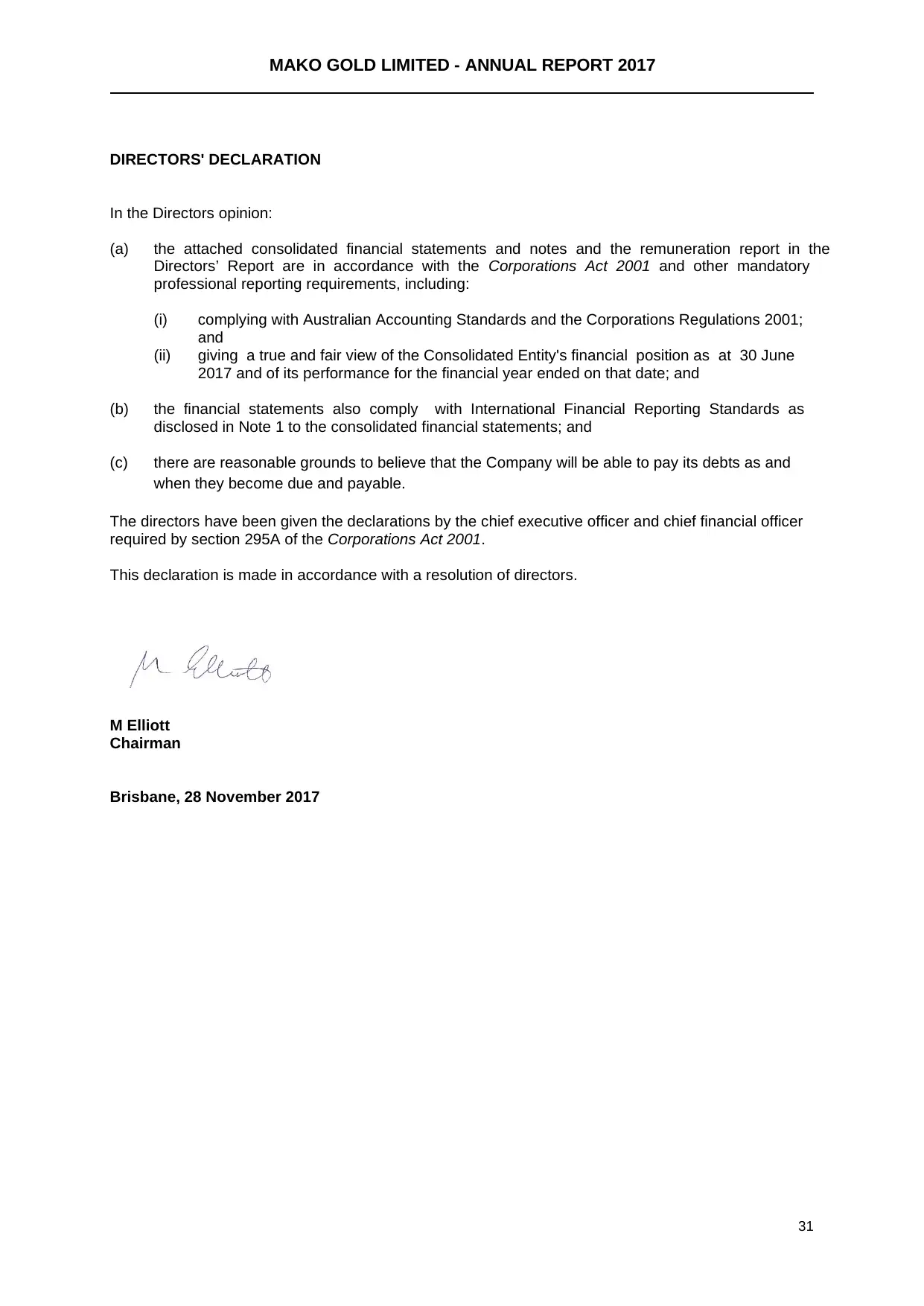
MAKO GOLD LIMITED - ANNUAL REPORT 2017
31
DIRECTORS' DECLARATION
In the Directors opinion:
(a) the attached consolidated financial statements and notes and the remuneration report in the
Directors’ Report are in accordance with the Corporations Act 2001 and other mandatory
professional reporting requirements, including:
(i) complying with Australian Accounting Standards and the Corporations Regulations 2001;
and
(ii) giving a true and fair view of the Consolidated Entity's financial position as at 30 June
2017 and of its performance for the financial year ended on that date; and
(b) the financial statements also comply with International Financial Reporting Standards as
disclosed in Note 1 to the consolidated financial statements; and
(c) there are reasonable grounds to believe that the Company will be able to pay its debts as and
when they become due and payable.
The directors have been given the declarations by the chief executive officer and chief financial officer
required by section 295A of the Corporations Act 2001.
This declaration is made in accordance with a resolution of directors.
M Elliott
Chairman
Brisbane, 28 November 2017
31
DIRECTORS' DECLARATION
In the Directors opinion:
(a) the attached consolidated financial statements and notes and the remuneration report in the
Directors’ Report are in accordance with the Corporations Act 2001 and other mandatory
professional reporting requirements, including:
(i) complying with Australian Accounting Standards and the Corporations Regulations 2001;
and
(ii) giving a true and fair view of the Consolidated Entity's financial position as at 30 June
2017 and of its performance for the financial year ended on that date; and
(b) the financial statements also comply with International Financial Reporting Standards as
disclosed in Note 1 to the consolidated financial statements; and
(c) there are reasonable grounds to believe that the Company will be able to pay its debts as and
when they become due and payable.
The directors have been given the declarations by the chief executive officer and chief financial officer
required by section 295A of the Corporations Act 2001.
This declaration is made in accordance with a resolution of directors.
M Elliott
Chairman
Brisbane, 28 November 2017
Paraphrase This Document
Need a fresh take? Get an instant paraphrase of this document with our AI Paraphraser
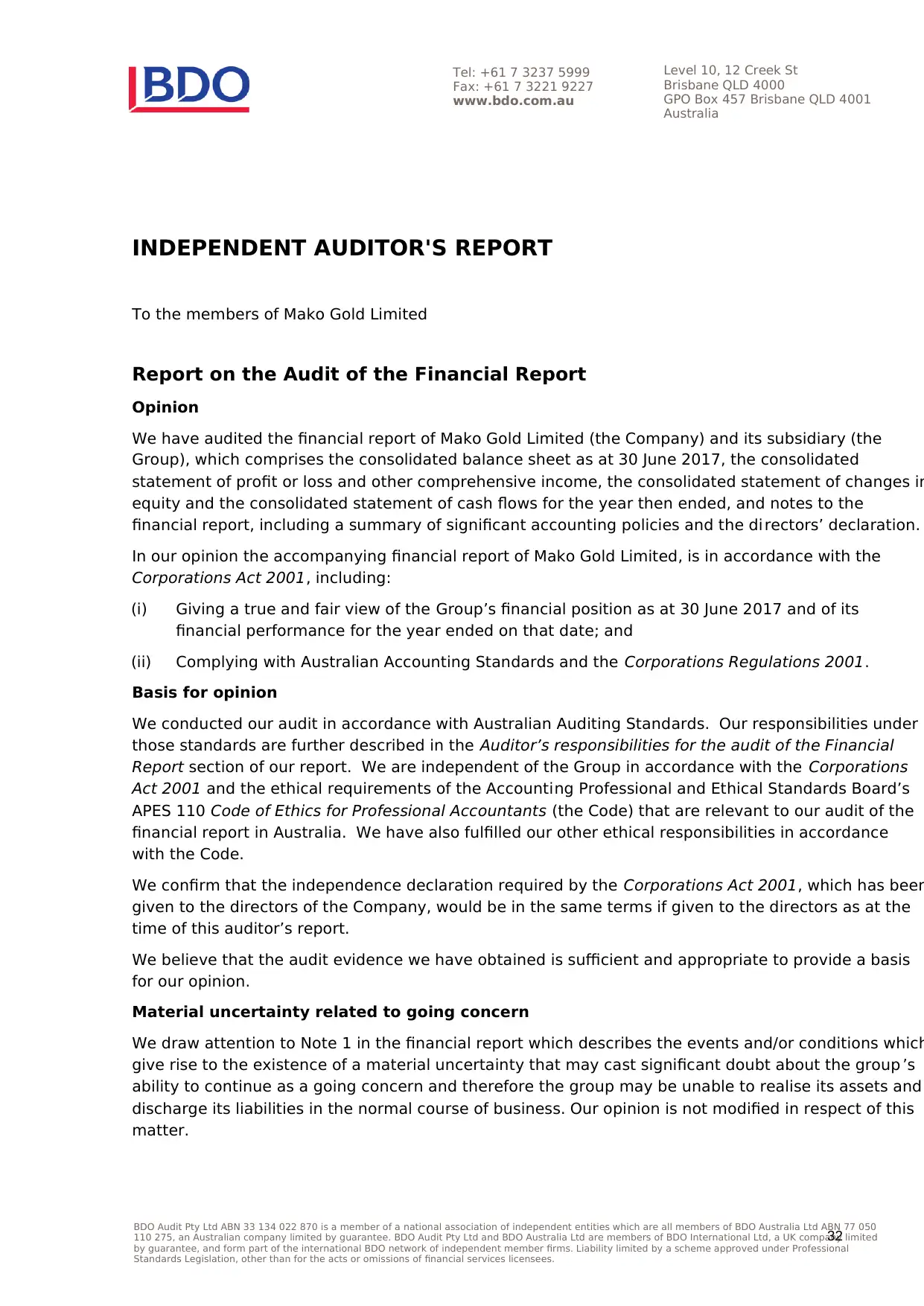
Level 10, 12 Creek St
Brisbane QLD 4000
GPO Box 457 Brisbane QLD 4001
Australia
Tel: +61 7 3237 5999
Fax: +61 7 3221 9227
www.bdo.com.au
BDO Audit Pty Ltd ABN 33 134 022 870 is a member of a national association of independent entities which are all members of BDO Australia Ltd ABN 77 050
110 275, an Australian company limited by guarantee. BDO Audit Pty Ltd and BDO Australia Ltd are members of BDO International Ltd, a UK company limited
by guarantee, and form part of the international BDO network of independent member firms. Liability limited by a scheme approved under Professional
Standards Legislation, other than for the acts or omissions of financial services licensees.
INDEPENDENT AUDITOR'S REPORT
To the members of Mako Gold Limited
Report on the Audit of the Financial Report
Opinion
We have audited the financial report of Mako Gold Limited (the Company) and its subsidiary (the
Group), which comprises the consolidated balance sheet as at 30 June 2017, the consolidated
statement of profit or loss and other comprehensive income, the consolidated statement of changes in
equity and the consolidated statement of cash flows for the year then ended, and notes to the
financial report, including a summary of significant accounting policies and the di rectors’ declaration.
In our opinion the accompanying financial report of Mako Gold Limited, is in accordance with the
Corporations Act 2001, including:
(i) Giving a true and fair view of the Group’s financial position as at 30 June 2017 and of its
financial performance for the year ended on that date; and
(ii) Complying with Australian Accounting Standards and the Corporations Regulations 2001.
Basis for opinion
We conducted our audit in accordance with Australian Auditing Standards. Our responsibilities under
those standards are further described in the Auditor’s responsibilities for the audit of the Financial
Report section of our report. We are independent of the Group in accordance with the Corporations
Act 2001 and the ethical requirements of the Accounting Professional and Ethical Standards Board’s
APES 110 Code of Ethics for Professional Accountants (the Code) that are relevant to our audit of the
financial report in Australia. We have also fulfilled our other ethical responsibilities in accordance
with the Code.
We confirm that the independence declaration required by the Corporations Act 2001, which has been
given to the directors of the Company, would be in the same terms if given to the directors as at the
time of this auditor’s report.
We believe that the audit evidence we have obtained is sufficient and appropriate to provide a basis
for our opinion.
Material uncertainty related to going concern
We draw attention to Note 1 in the financial report which describes the events and/or conditions which
give rise to the existence of a material uncertainty that may cast significant doubt about the group ’s
ability to continue as a going concern and therefore the group may be unable to realise its assets and
discharge its liabilities in the normal course of business. Our opinion is not modified in respect of this
matter.
32
Brisbane QLD 4000
GPO Box 457 Brisbane QLD 4001
Australia
Tel: +61 7 3237 5999
Fax: +61 7 3221 9227
www.bdo.com.au
BDO Audit Pty Ltd ABN 33 134 022 870 is a member of a national association of independent entities which are all members of BDO Australia Ltd ABN 77 050
110 275, an Australian company limited by guarantee. BDO Audit Pty Ltd and BDO Australia Ltd are members of BDO International Ltd, a UK company limited
by guarantee, and form part of the international BDO network of independent member firms. Liability limited by a scheme approved under Professional
Standards Legislation, other than for the acts or omissions of financial services licensees.
INDEPENDENT AUDITOR'S REPORT
To the members of Mako Gold Limited
Report on the Audit of the Financial Report
Opinion
We have audited the financial report of Mako Gold Limited (the Company) and its subsidiary (the
Group), which comprises the consolidated balance sheet as at 30 June 2017, the consolidated
statement of profit or loss and other comprehensive income, the consolidated statement of changes in
equity and the consolidated statement of cash flows for the year then ended, and notes to the
financial report, including a summary of significant accounting policies and the di rectors’ declaration.
In our opinion the accompanying financial report of Mako Gold Limited, is in accordance with the
Corporations Act 2001, including:
(i) Giving a true and fair view of the Group’s financial position as at 30 June 2017 and of its
financial performance for the year ended on that date; and
(ii) Complying with Australian Accounting Standards and the Corporations Regulations 2001.
Basis for opinion
We conducted our audit in accordance with Australian Auditing Standards. Our responsibilities under
those standards are further described in the Auditor’s responsibilities for the audit of the Financial
Report section of our report. We are independent of the Group in accordance with the Corporations
Act 2001 and the ethical requirements of the Accounting Professional and Ethical Standards Board’s
APES 110 Code of Ethics for Professional Accountants (the Code) that are relevant to our audit of the
financial report in Australia. We have also fulfilled our other ethical responsibilities in accordance
with the Code.
We confirm that the independence declaration required by the Corporations Act 2001, which has been
given to the directors of the Company, would be in the same terms if given to the directors as at the
time of this auditor’s report.
We believe that the audit evidence we have obtained is sufficient and appropriate to provide a basis
for our opinion.
Material uncertainty related to going concern
We draw attention to Note 1 in the financial report which describes the events and/or conditions which
give rise to the existence of a material uncertainty that may cast significant doubt about the group ’s
ability to continue as a going concern and therefore the group may be unable to realise its assets and
discharge its liabilities in the normal course of business. Our opinion is not modified in respect of this
matter.
32
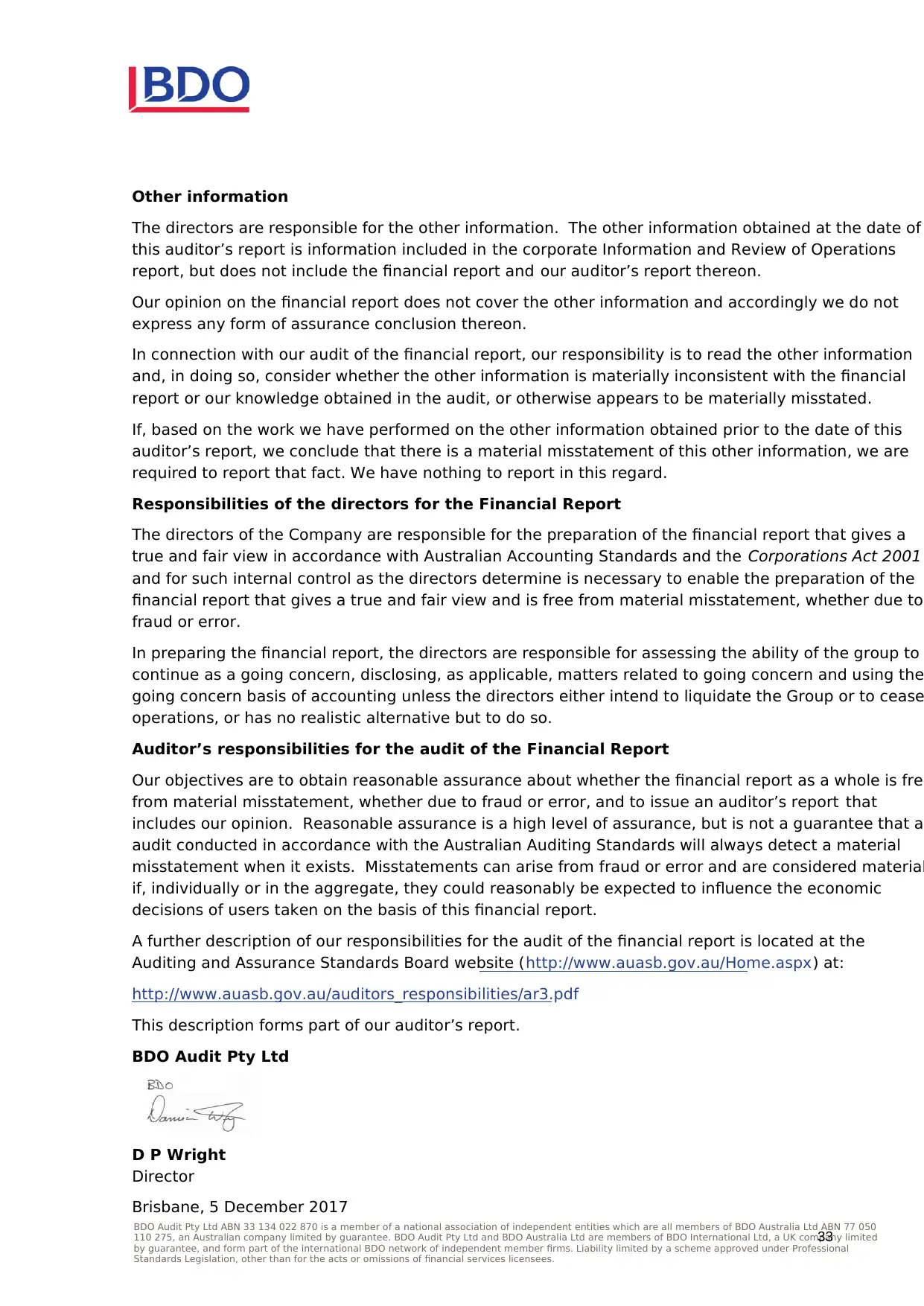
BDO Audit Pty Ltd ABN 33 134 022 870 is a member of a national association of independent entities which are all members of BDO Australia Ltd ABN 77 050
110 275, an Australian company limited by guarantee. BDO Audit Pty Ltd and BDO Australia Ltd are members of BDO International Ltd, a UK company limited
by guarantee, and form part of the international BDO network of independent member firms. Liability limited by a scheme approved under Professional
Standards Legislation, other than for the acts or omissions of financial services licensees.
Other information
The directors are responsible for the other information. The other information obtained at the date of
this auditor’s report is information included in the corporate Information and Review of Operations
report, but does not include the financial report and our auditor’s report thereon.
Our opinion on the financial report does not cover the other information and accordingly we do not
express any form of assurance conclusion thereon.
In connection with our audit of the financial report, our responsibility is to read the other information
and, in doing so, consider whether the other information is materially inconsistent with the financial
report or our knowledge obtained in the audit, or otherwise appears to be materially misstated.
If, based on the work we have performed on the other information obtained prior to the date of this
auditor’s report, we conclude that there is a material misstatement of this other information, we are
required to report that fact. We have nothing to report in this regard.
Responsibilities of the directors for the Financial Report
The directors of the Company are responsible for the preparation of the financial report that gives a
true and fair view in accordance with Australian Accounting Standards and the Corporations Act 2001
and for such internal control as the directors determine is necessary to enable the preparation of the
financial report that gives a true and fair view and is free from material misstatement, whether due to
fraud or error.
In preparing the financial report, the directors are responsible for assessing the ability of the group to
continue as a going concern, disclosing, as applicable, matters related to going concern and using the
going concern basis of accounting unless the directors either intend to liquidate the Group or to cease
operations, or has no realistic alternative but to do so.
Auditor’s responsibilities for the audit of the Financial Report
Our objectives are to obtain reasonable assurance about whether the financial report as a whole is free
from material misstatement, whether due to fraud or error, and to issue an auditor’s report that
includes our opinion. Reasonable assurance is a high level of assurance, but is not a guarantee that a
audit conducted in accordance with the Australian Auditing Standards will always detect a material
misstatement when it exists. Misstatements can arise from fraud or error and are considered material
if, individually or in the aggregate, they could reasonably be expected to influence the economic
decisions of users taken on the basis of this financial report.
A further description of our responsibilities for the audit of the financial report is located at the
Auditing and Assurance Standards Board website (http://www.auasb.gov.au/Home.aspx) at:
http://www.auasb.gov.au/auditors_responsibilities/ar3.pdf
This description forms part of our auditor’s report.
BDO Audit Pty Ltd
D P Wright
Director
Brisbane, 5 December 2017
33
110 275, an Australian company limited by guarantee. BDO Audit Pty Ltd and BDO Australia Ltd are members of BDO International Ltd, a UK company limited
by guarantee, and form part of the international BDO network of independent member firms. Liability limited by a scheme approved under Professional
Standards Legislation, other than for the acts or omissions of financial services licensees.
Other information
The directors are responsible for the other information. The other information obtained at the date of
this auditor’s report is information included in the corporate Information and Review of Operations
report, but does not include the financial report and our auditor’s report thereon.
Our opinion on the financial report does not cover the other information and accordingly we do not
express any form of assurance conclusion thereon.
In connection with our audit of the financial report, our responsibility is to read the other information
and, in doing so, consider whether the other information is materially inconsistent with the financial
report or our knowledge obtained in the audit, or otherwise appears to be materially misstated.
If, based on the work we have performed on the other information obtained prior to the date of this
auditor’s report, we conclude that there is a material misstatement of this other information, we are
required to report that fact. We have nothing to report in this regard.
Responsibilities of the directors for the Financial Report
The directors of the Company are responsible for the preparation of the financial report that gives a
true and fair view in accordance with Australian Accounting Standards and the Corporations Act 2001
and for such internal control as the directors determine is necessary to enable the preparation of the
financial report that gives a true and fair view and is free from material misstatement, whether due to
fraud or error.
In preparing the financial report, the directors are responsible for assessing the ability of the group to
continue as a going concern, disclosing, as applicable, matters related to going concern and using the
going concern basis of accounting unless the directors either intend to liquidate the Group or to cease
operations, or has no realistic alternative but to do so.
Auditor’s responsibilities for the audit of the Financial Report
Our objectives are to obtain reasonable assurance about whether the financial report as a whole is free
from material misstatement, whether due to fraud or error, and to issue an auditor’s report that
includes our opinion. Reasonable assurance is a high level of assurance, but is not a guarantee that a
audit conducted in accordance with the Australian Auditing Standards will always detect a material
misstatement when it exists. Misstatements can arise from fraud or error and are considered material
if, individually or in the aggregate, they could reasonably be expected to influence the economic
decisions of users taken on the basis of this financial report.
A further description of our responsibilities for the audit of the financial report is located at the
Auditing and Assurance Standards Board website (http://www.auasb.gov.au/Home.aspx) at:
http://www.auasb.gov.au/auditors_responsibilities/ar3.pdf
This description forms part of our auditor’s report.
BDO Audit Pty Ltd
D P Wright
Director
Brisbane, 5 December 2017
33
1 out of 33
Your All-in-One AI-Powered Toolkit for Academic Success.
+13062052269
info@desklib.com
Available 24*7 on WhatsApp / Email
![[object Object]](/_next/static/media/star-bottom.7253800d.svg)
Unlock your academic potential
© 2024 | Zucol Services PVT LTD | All rights reserved.